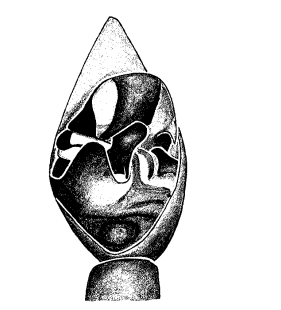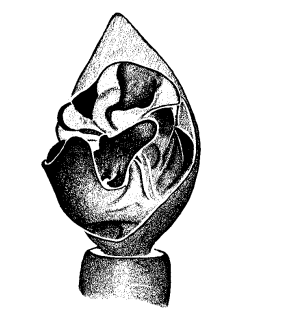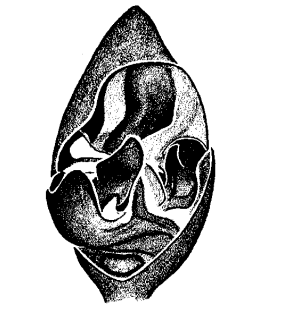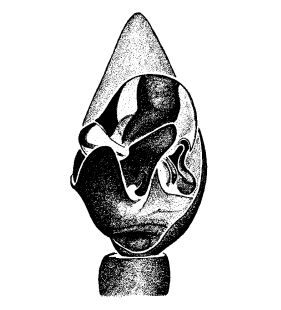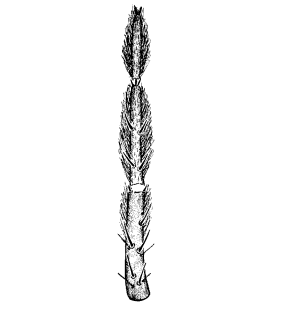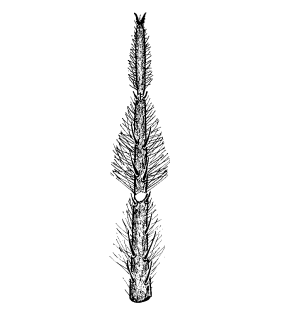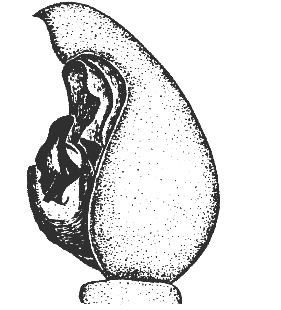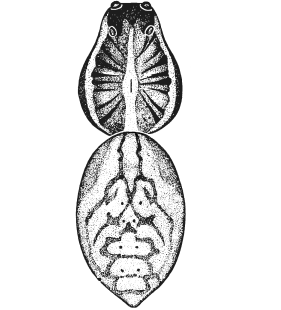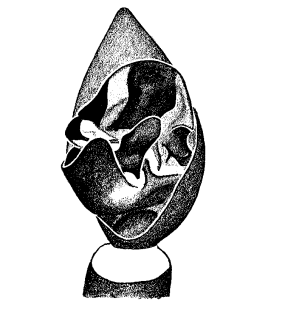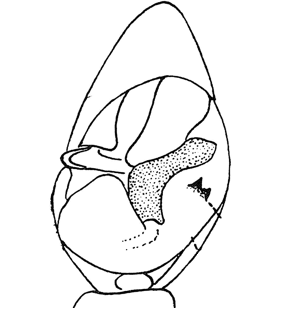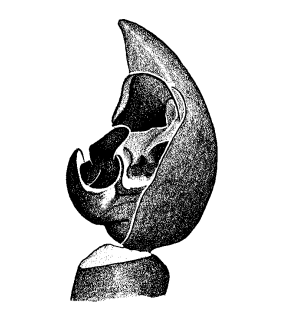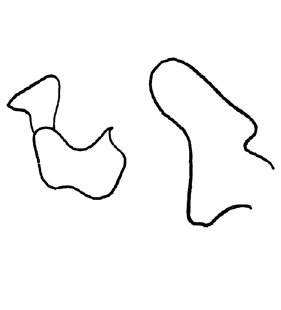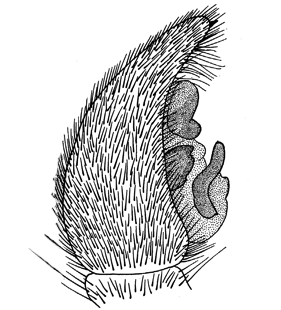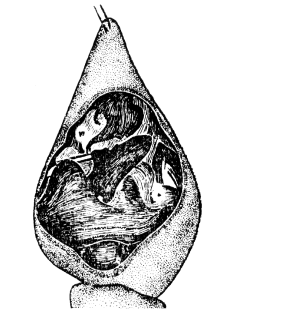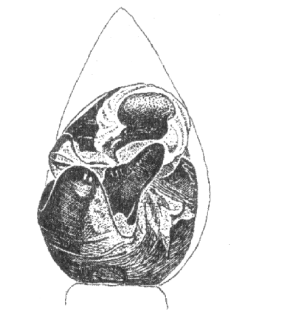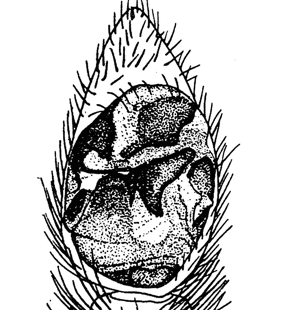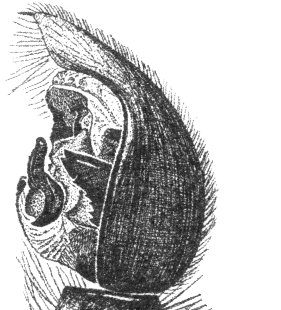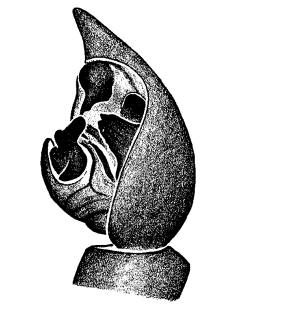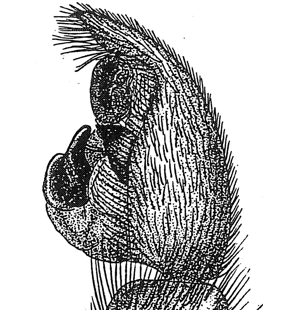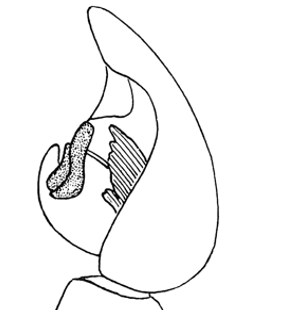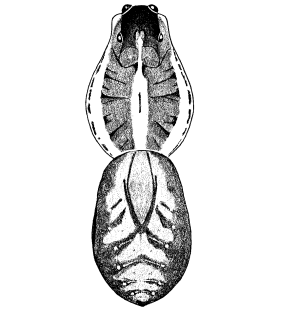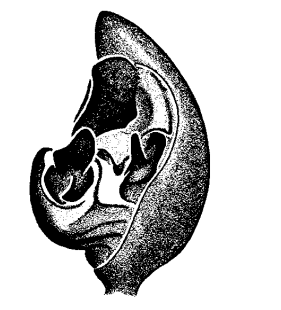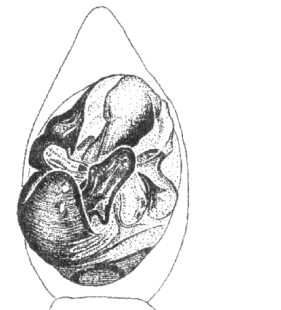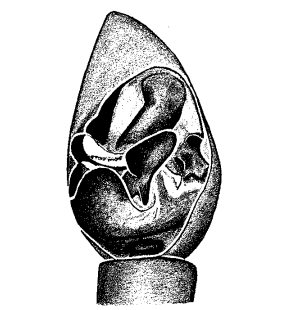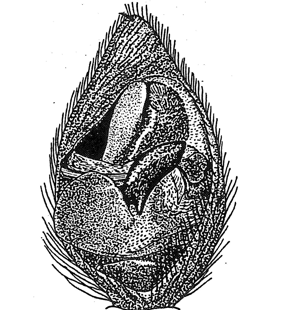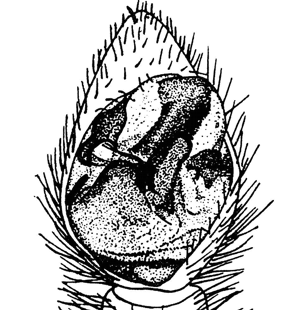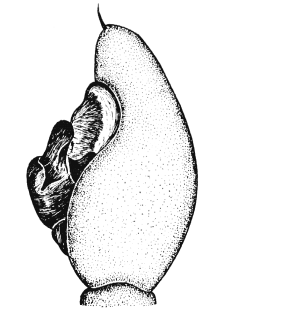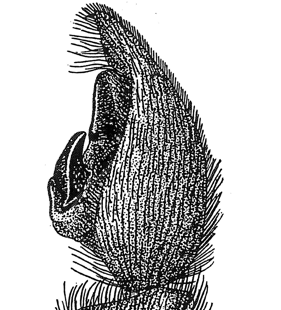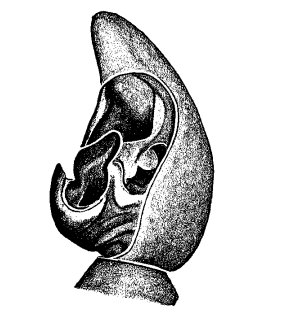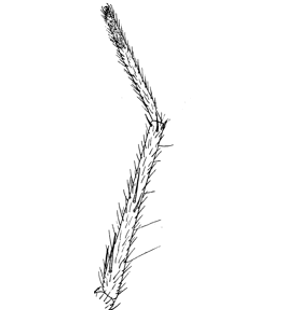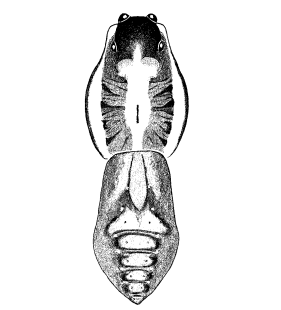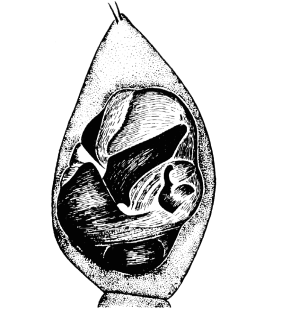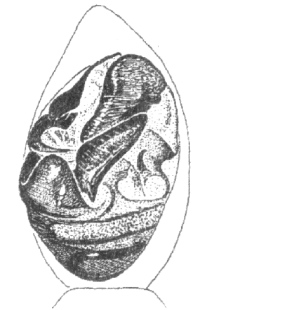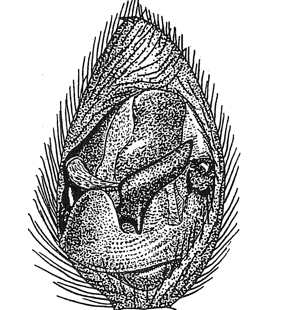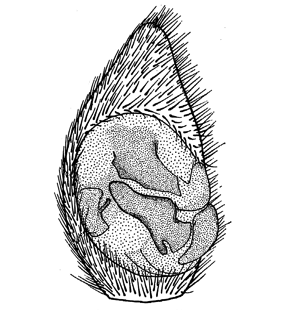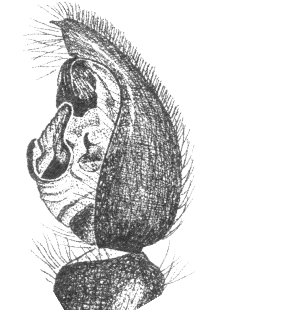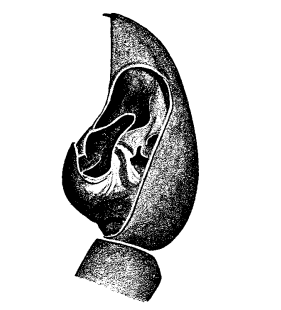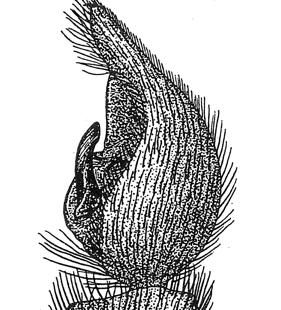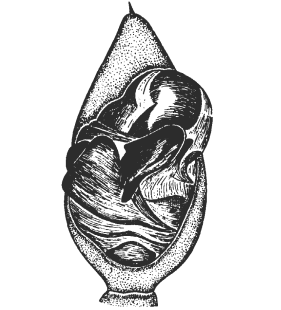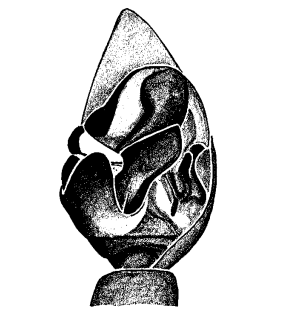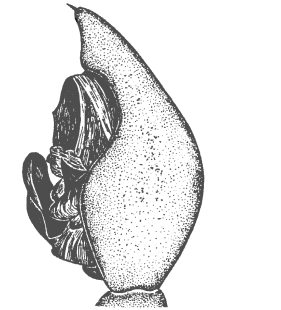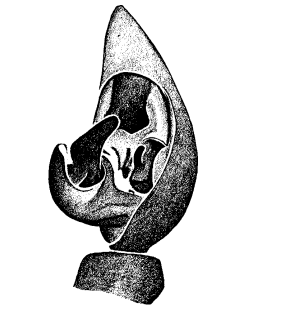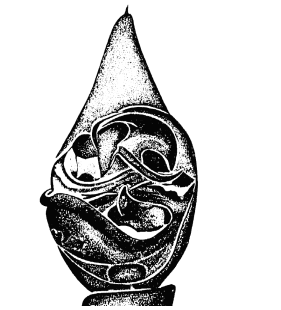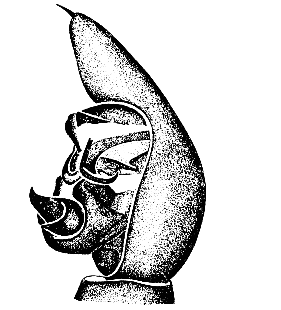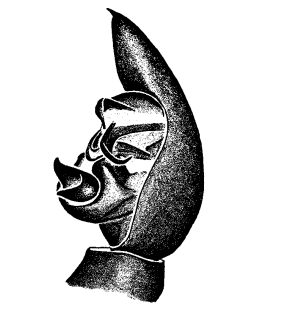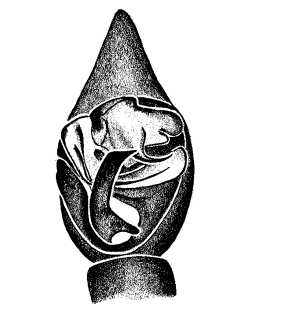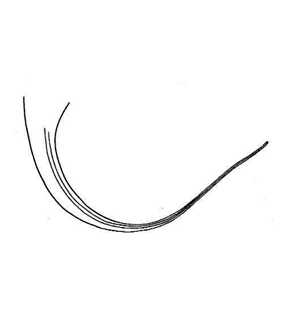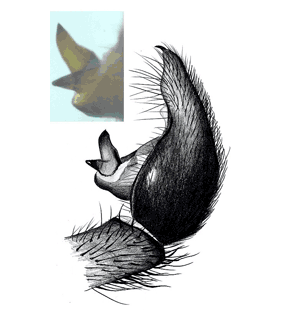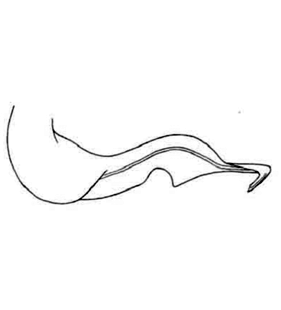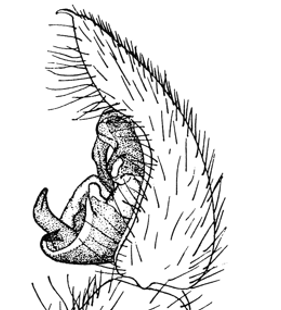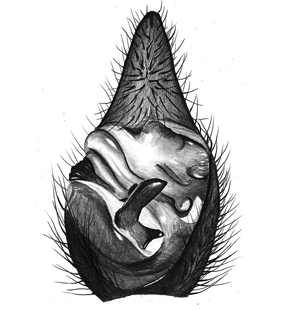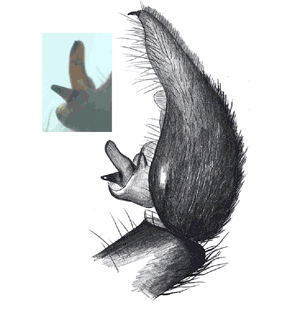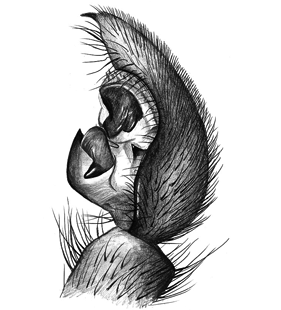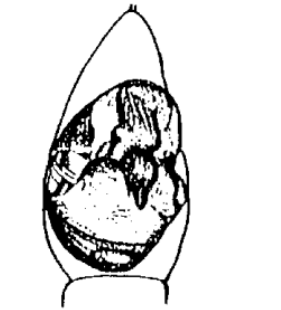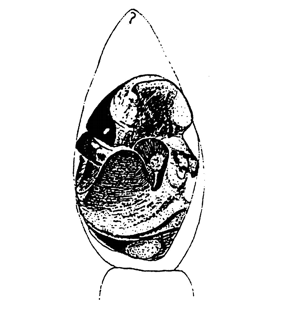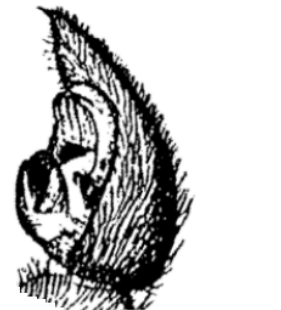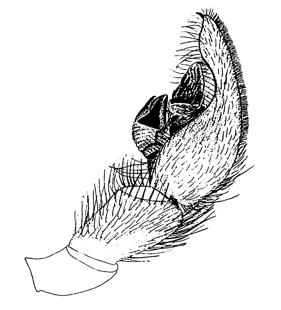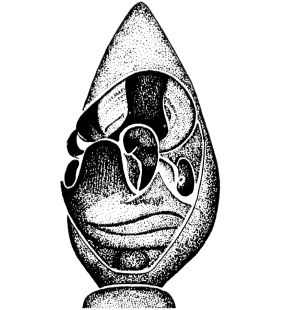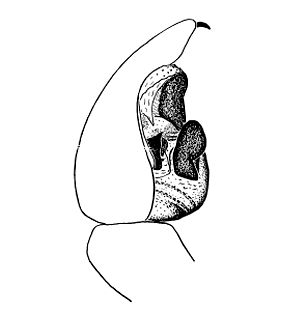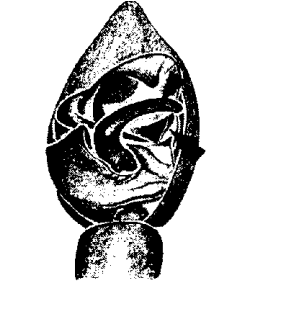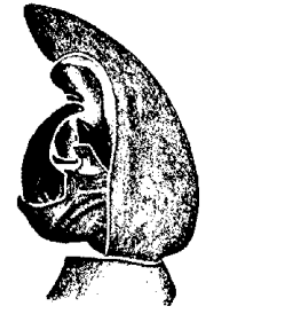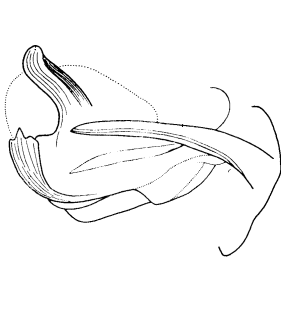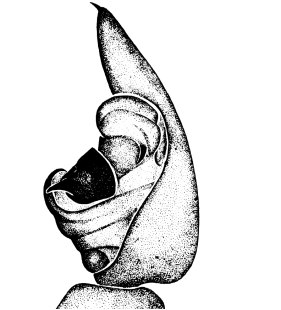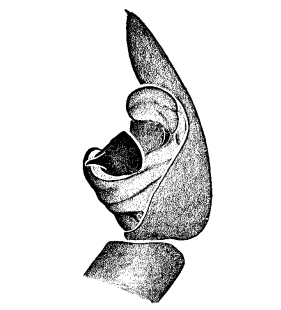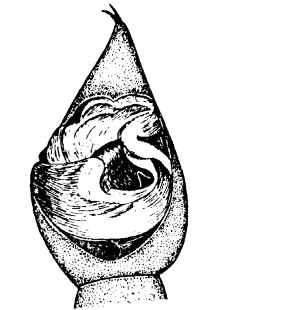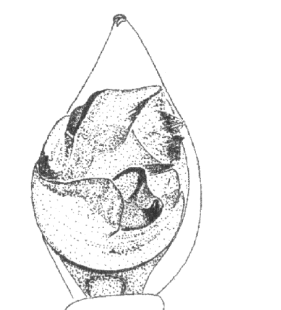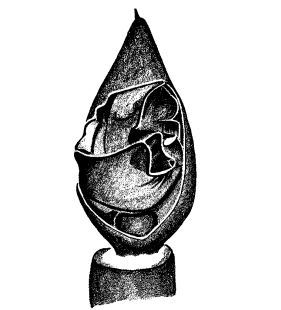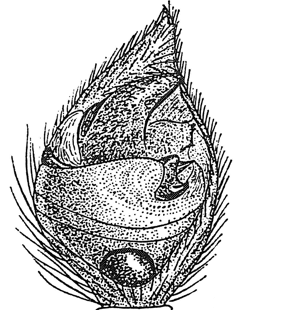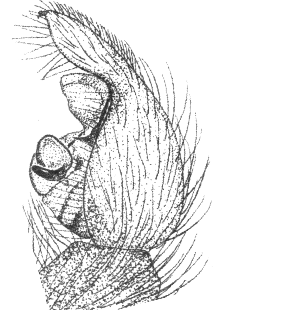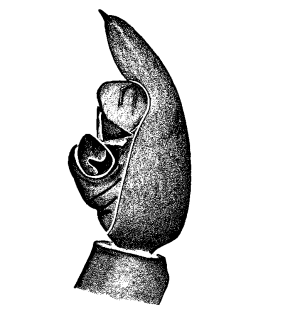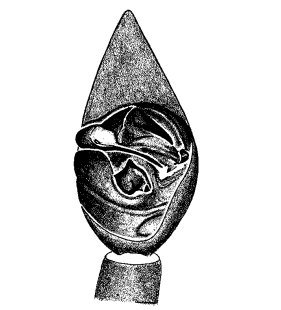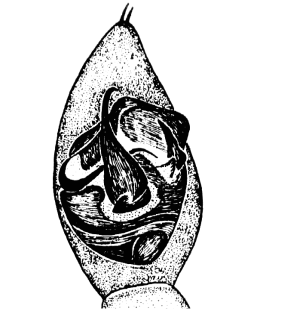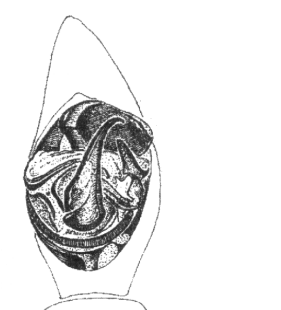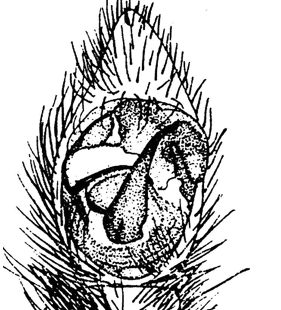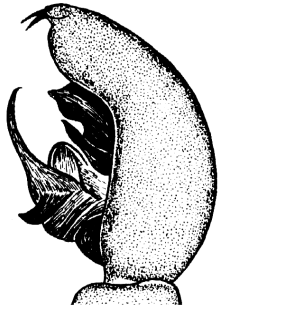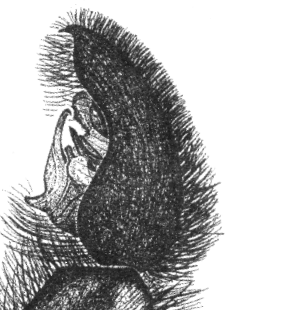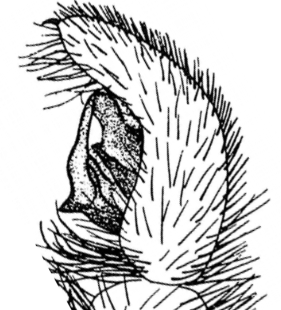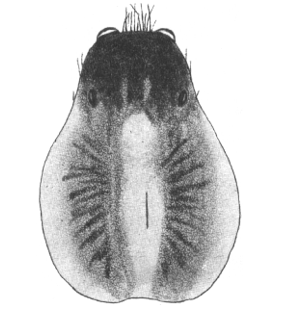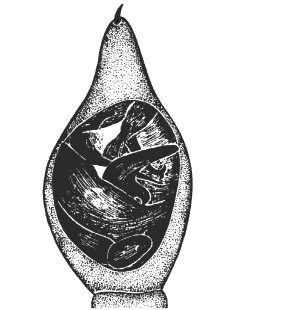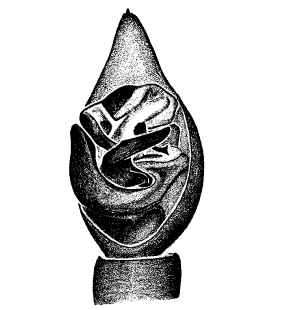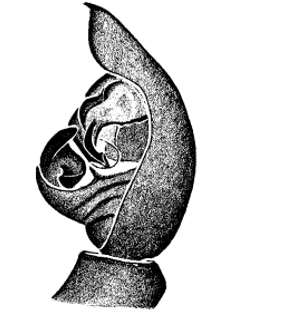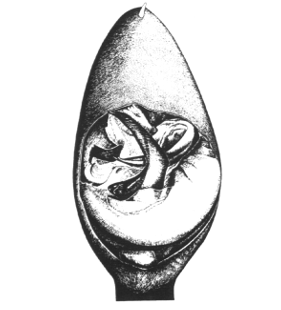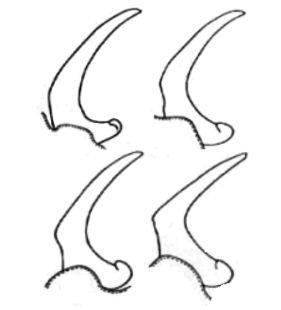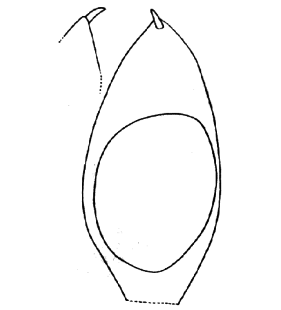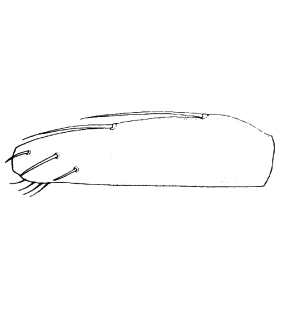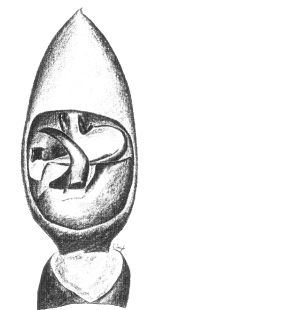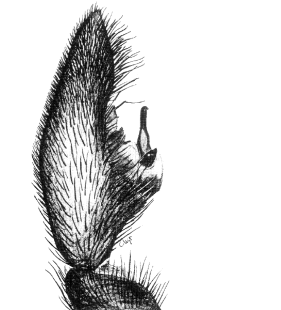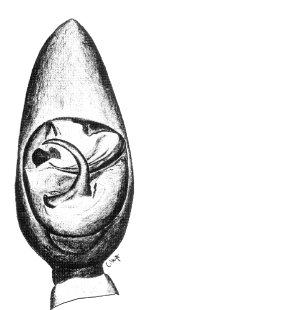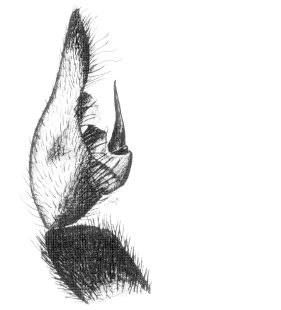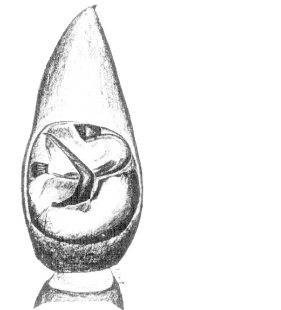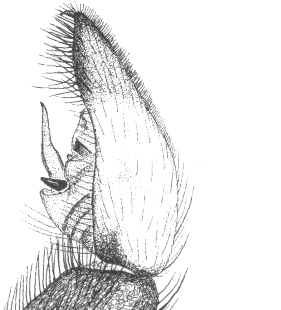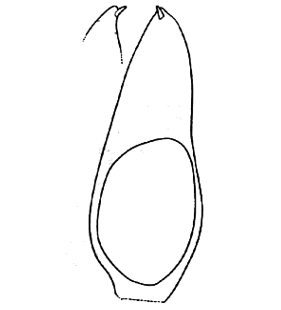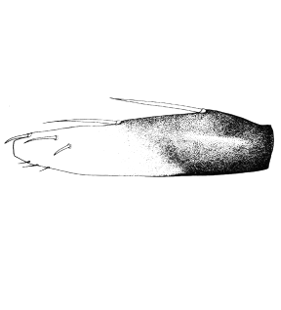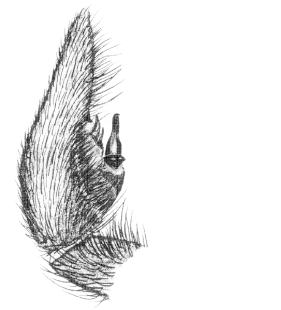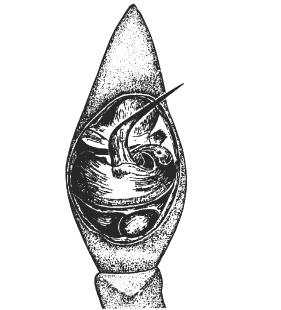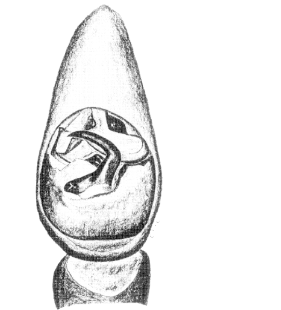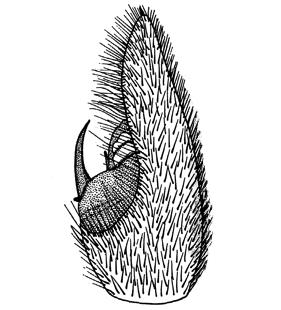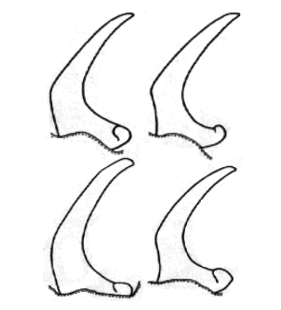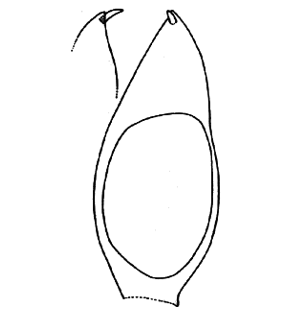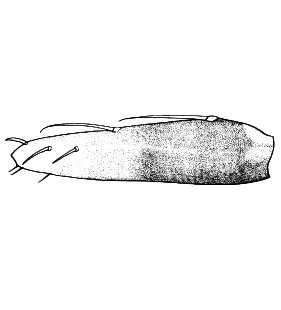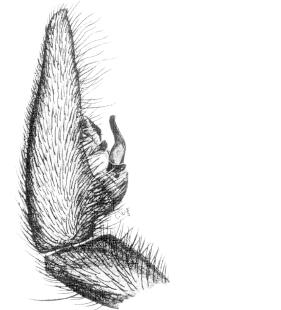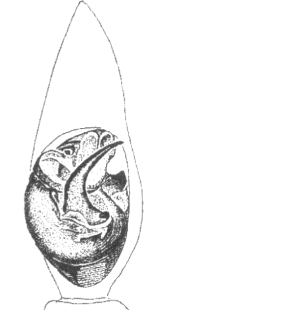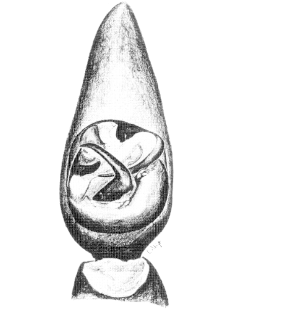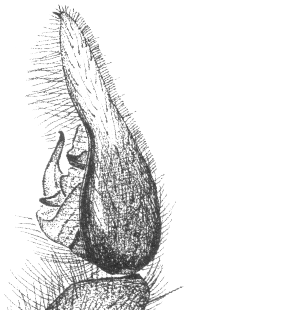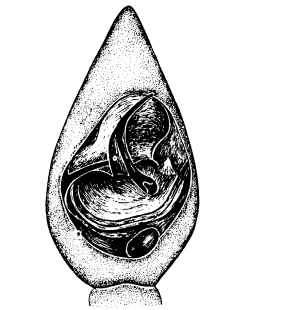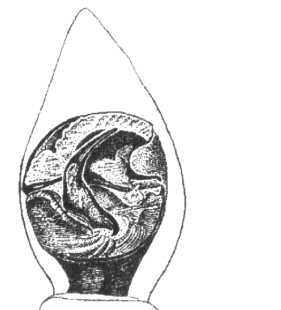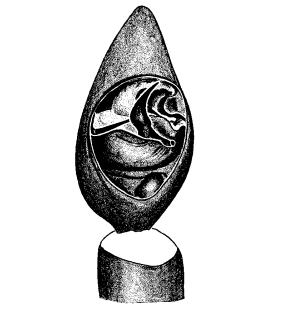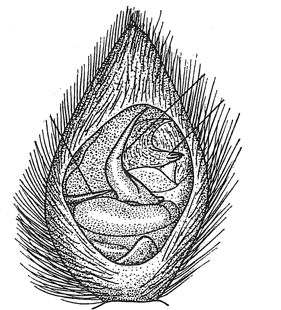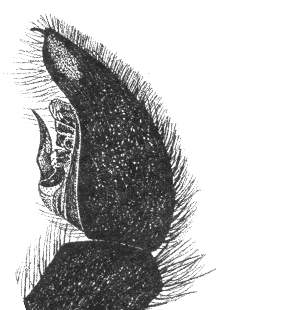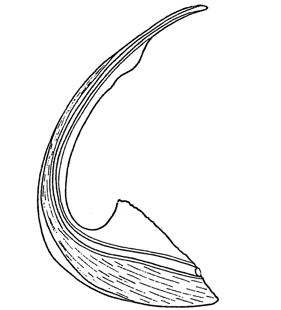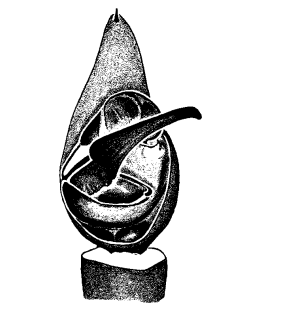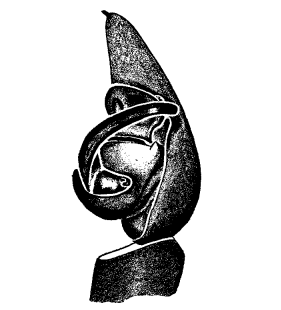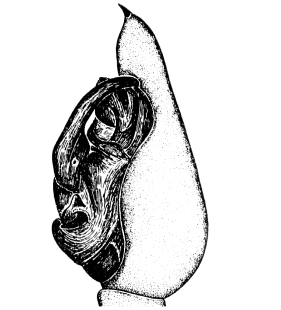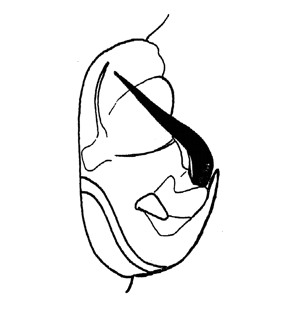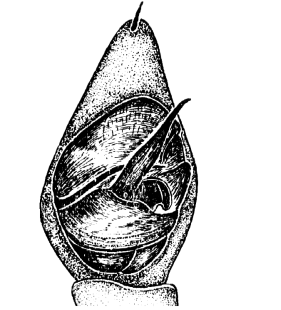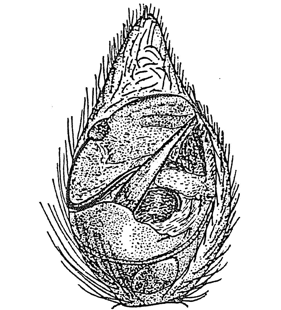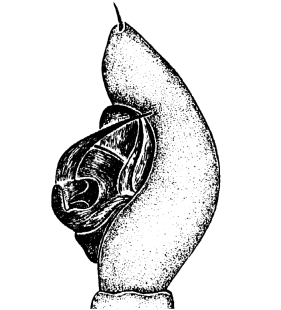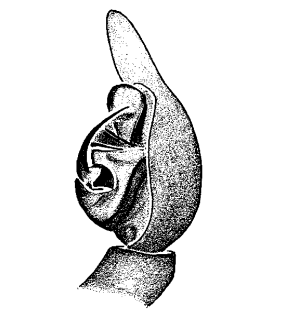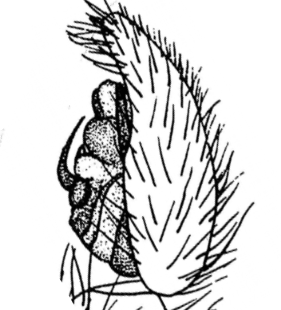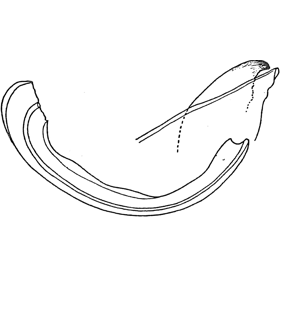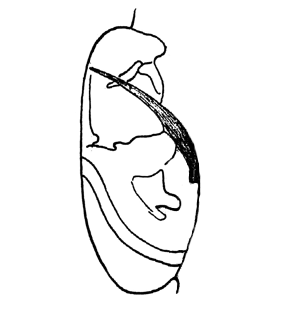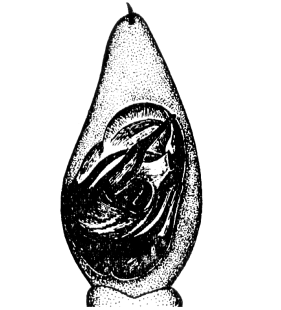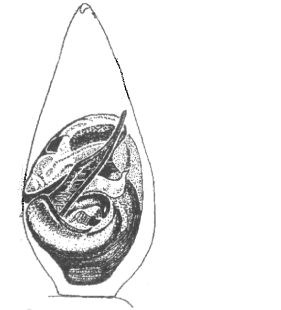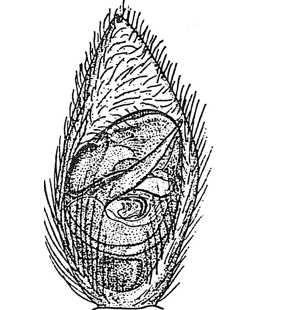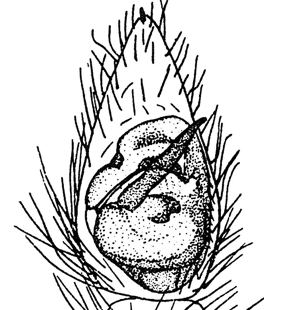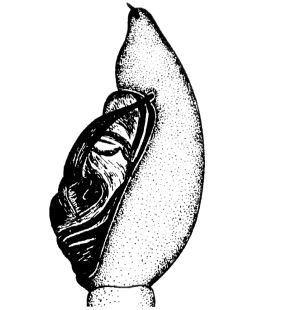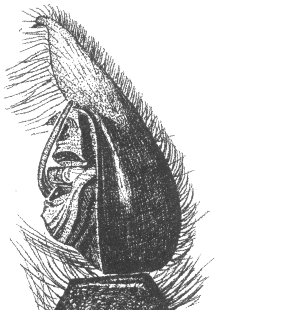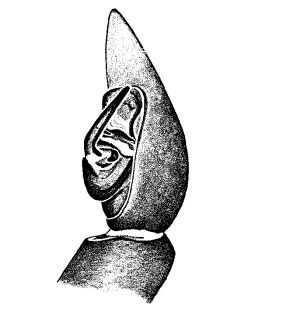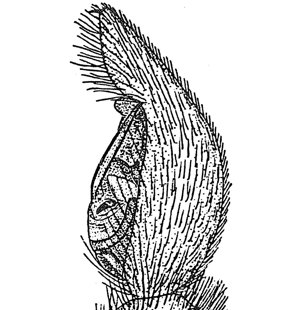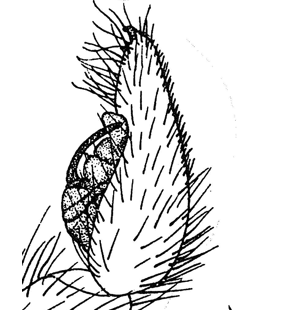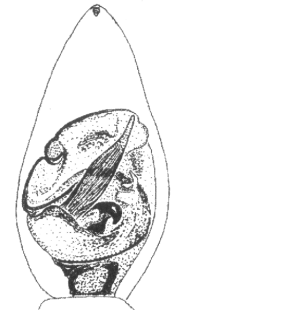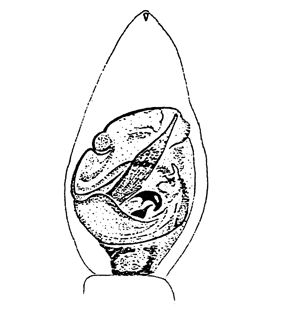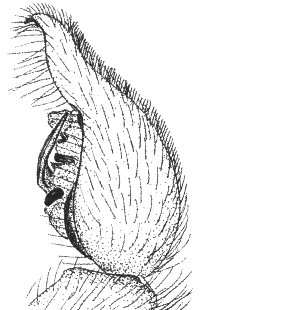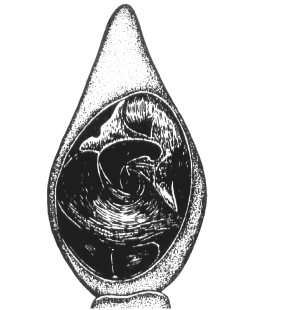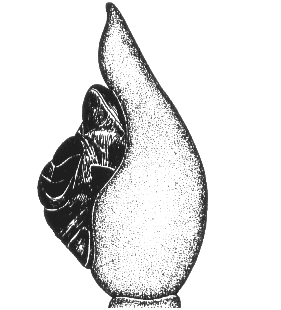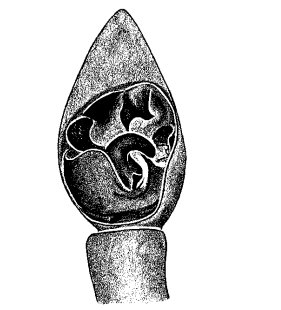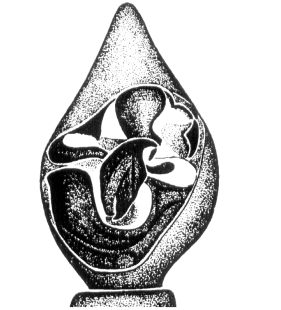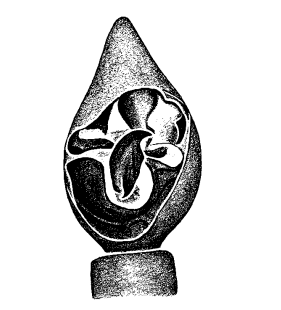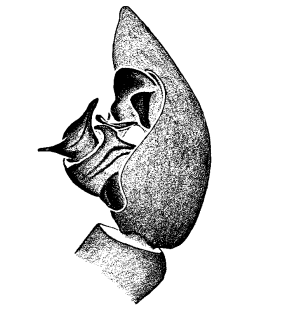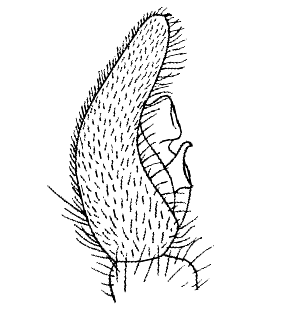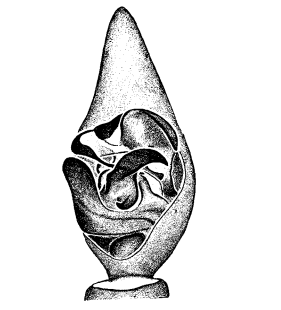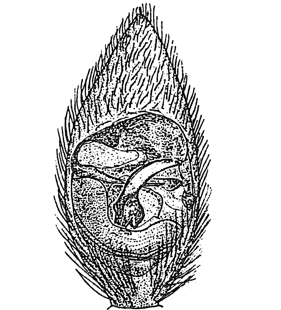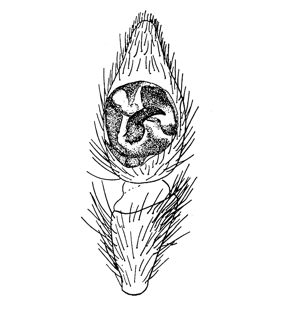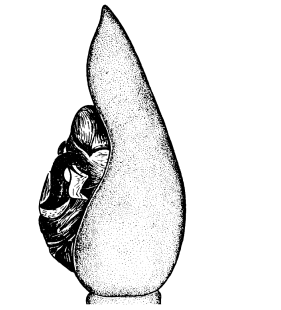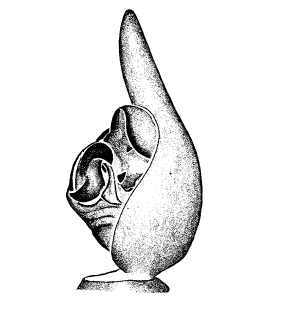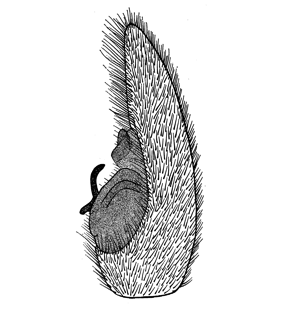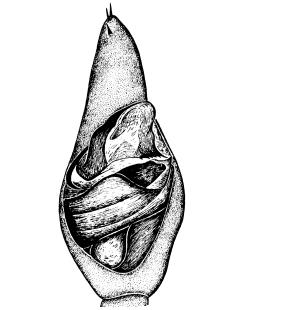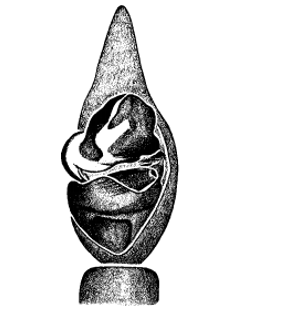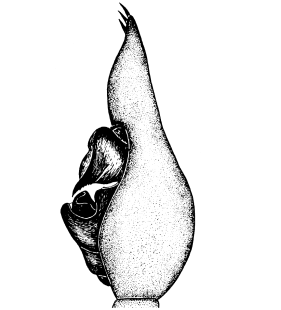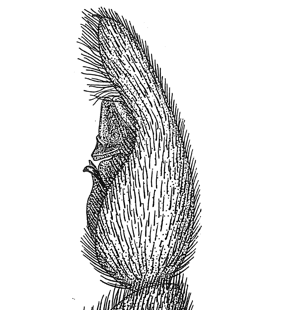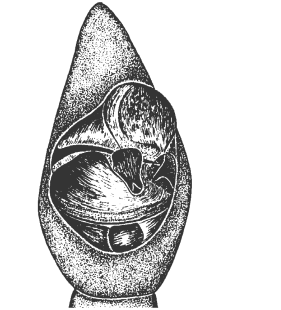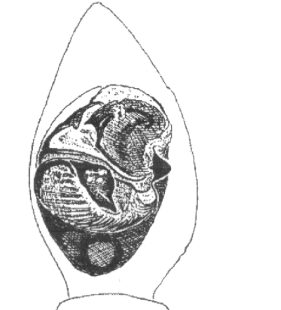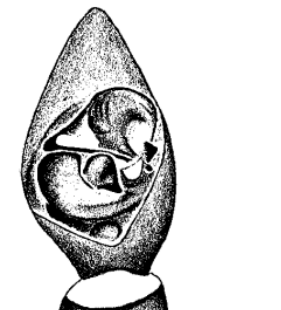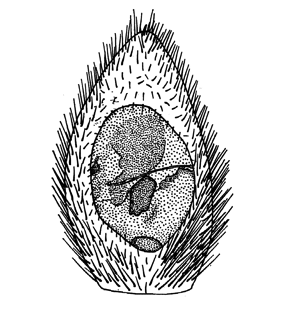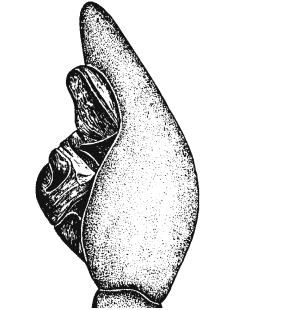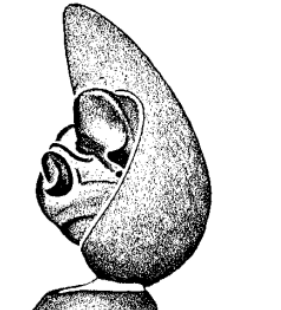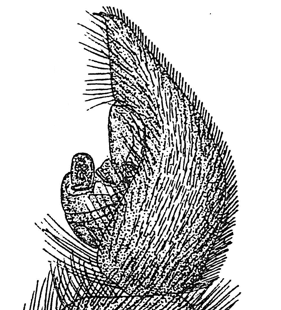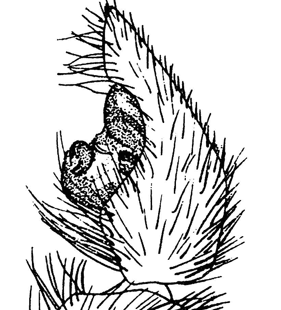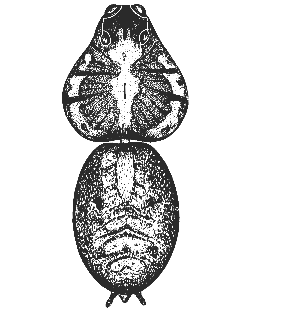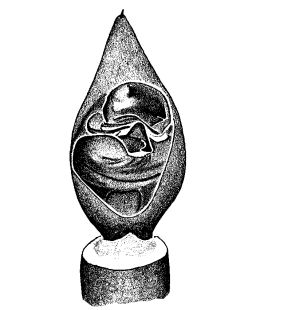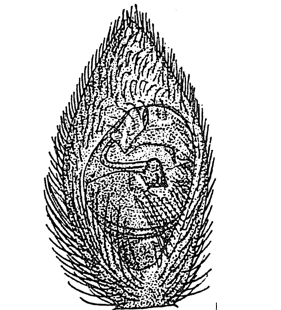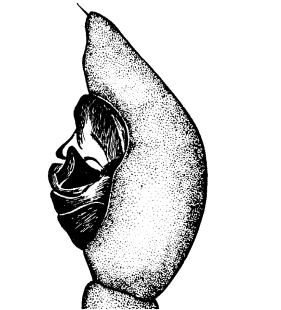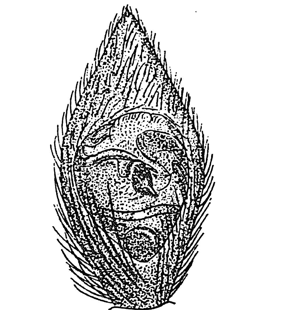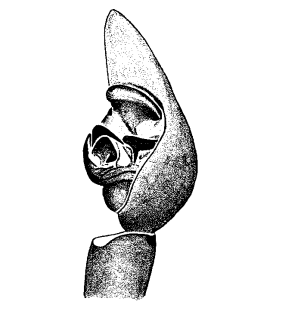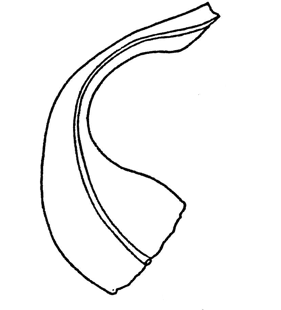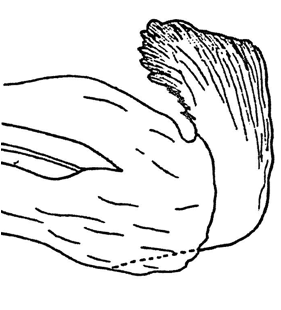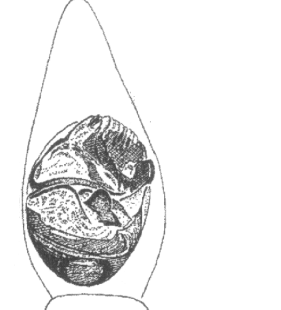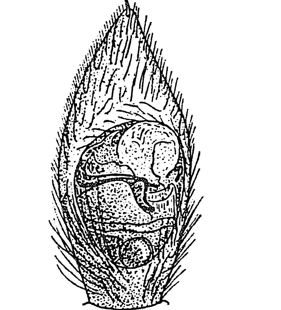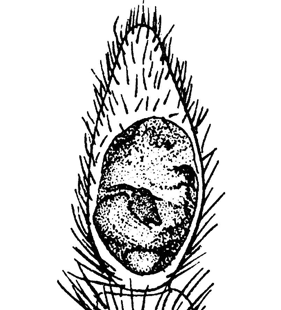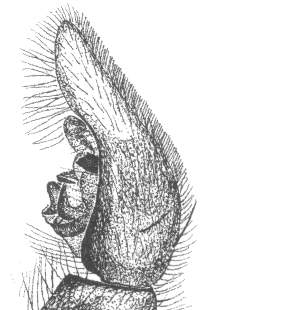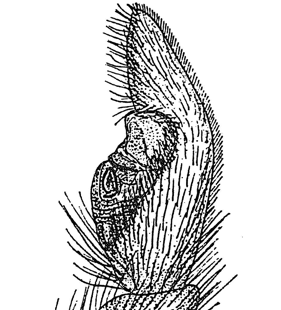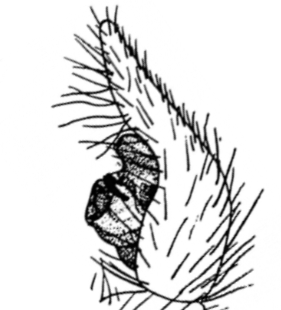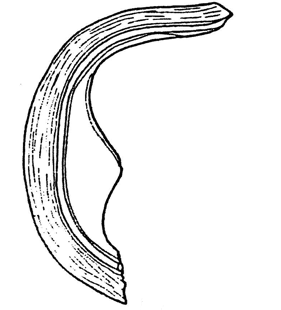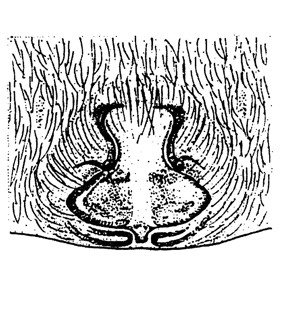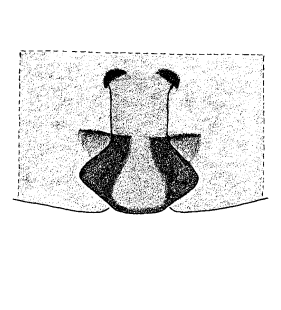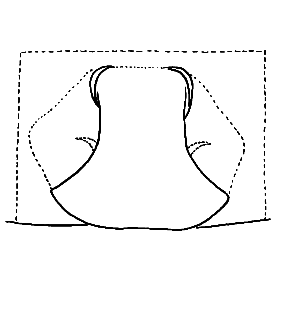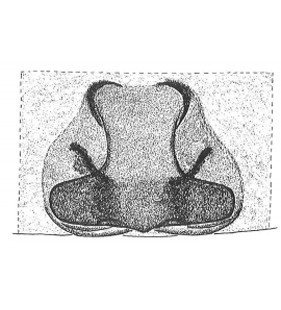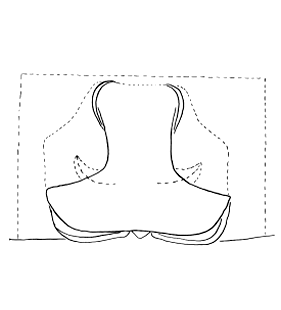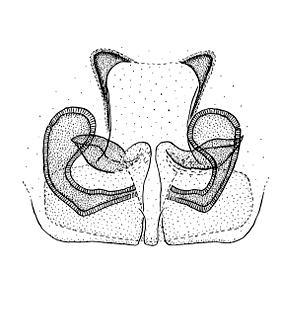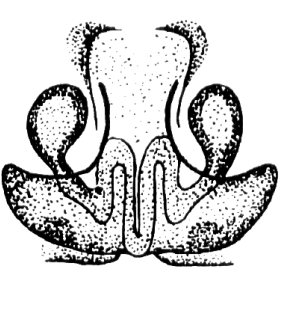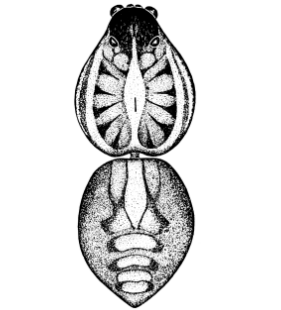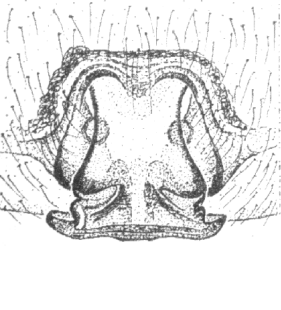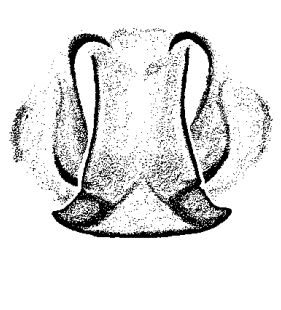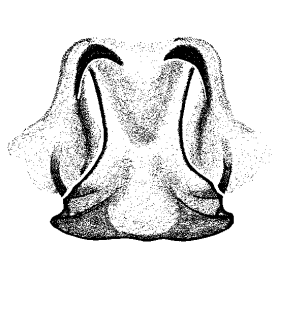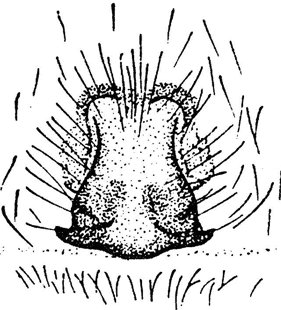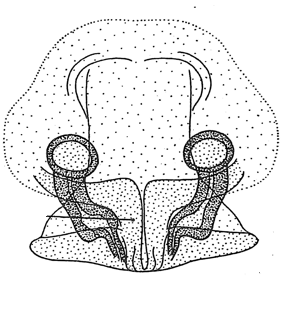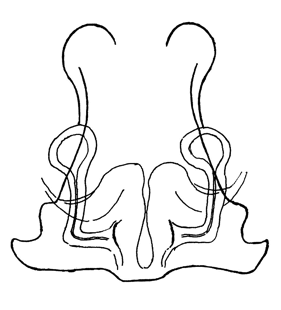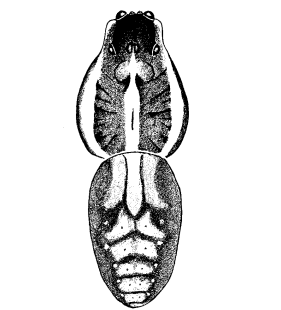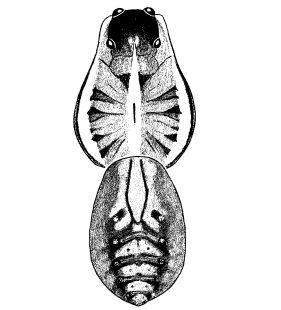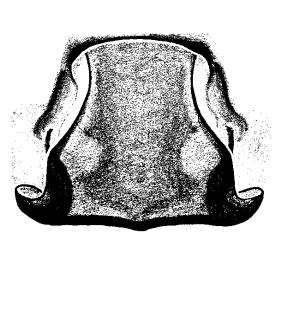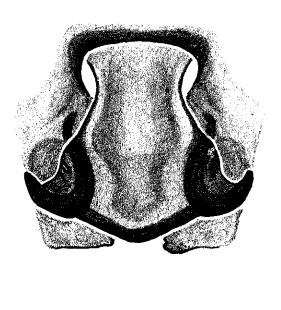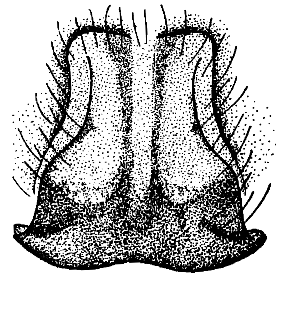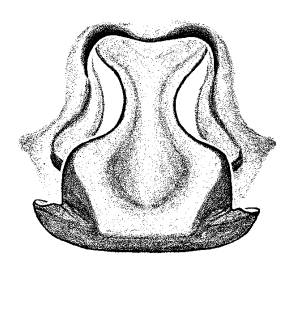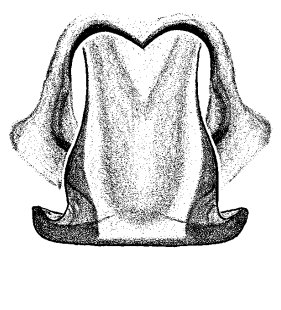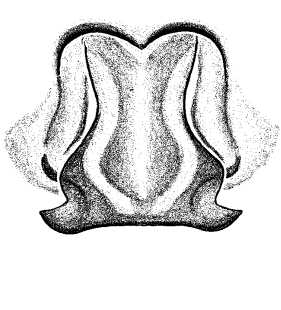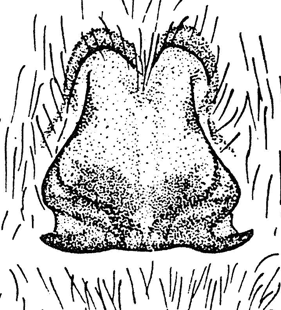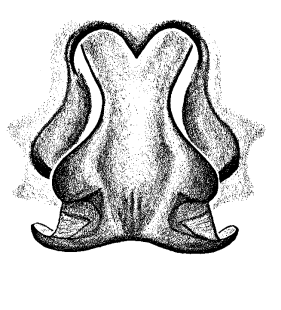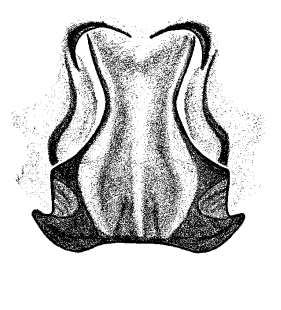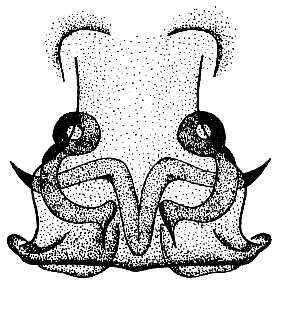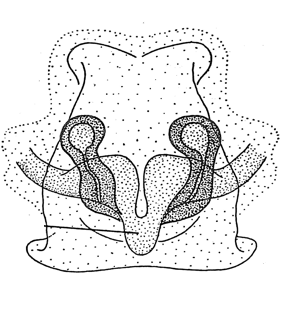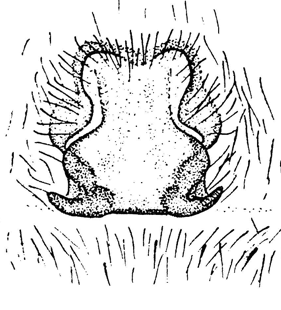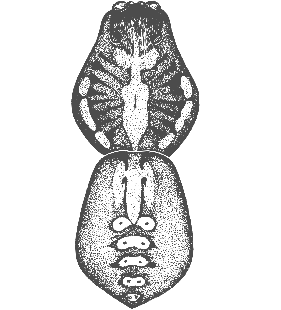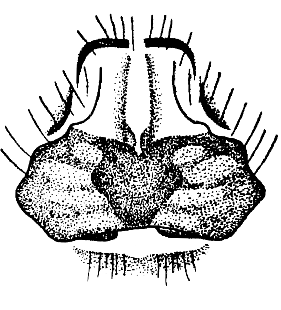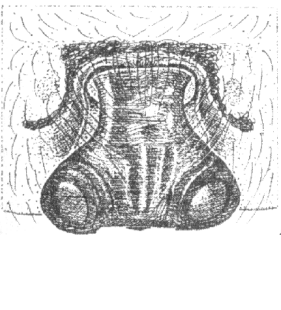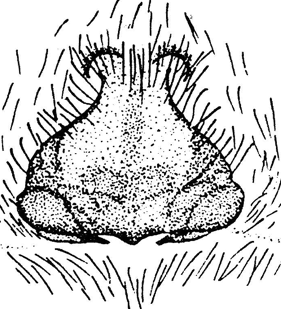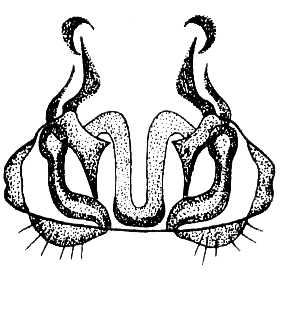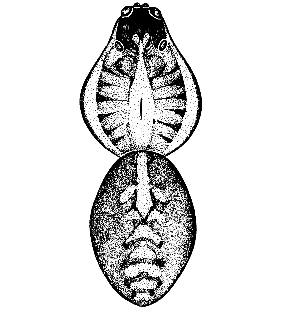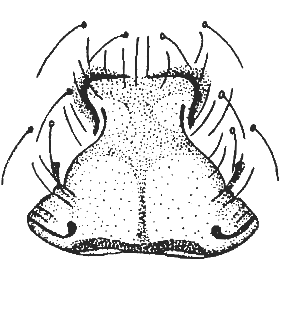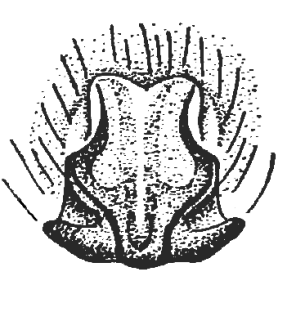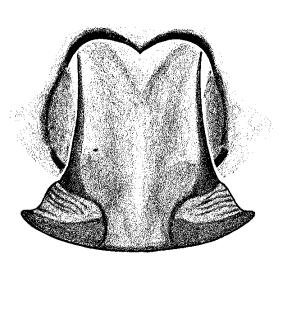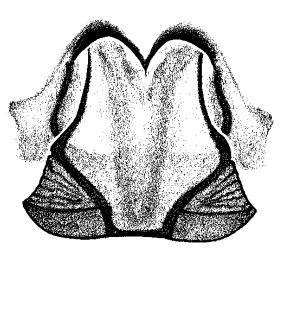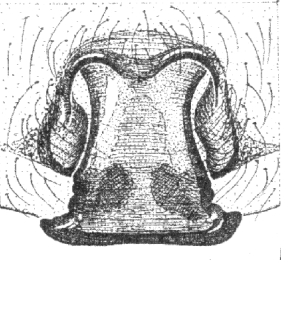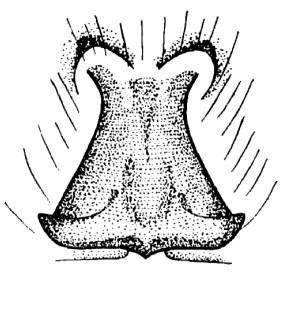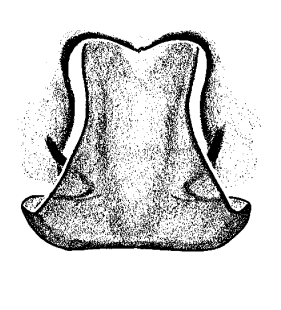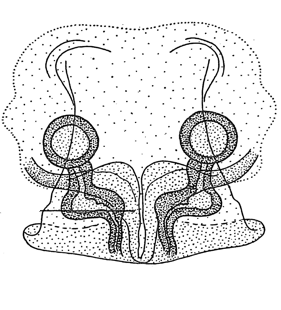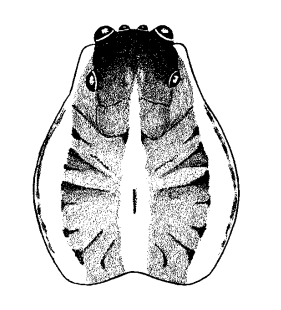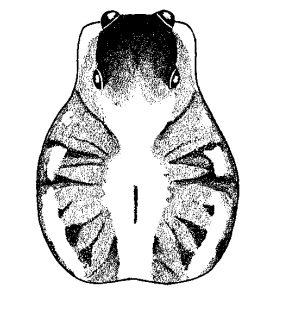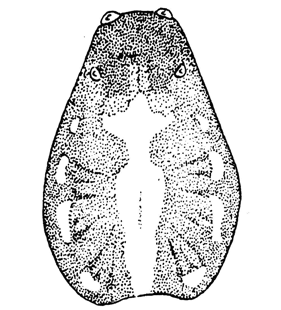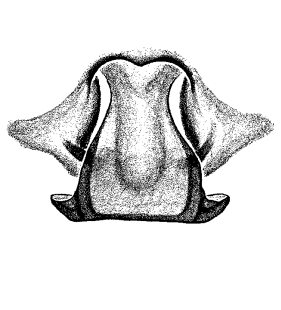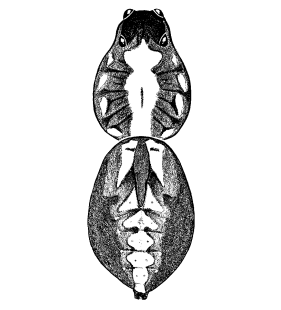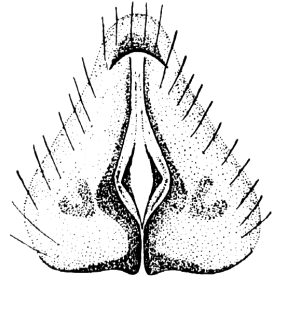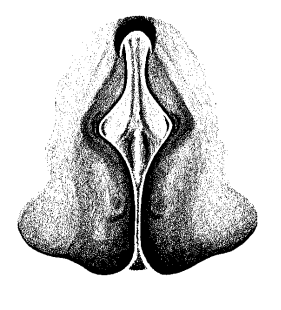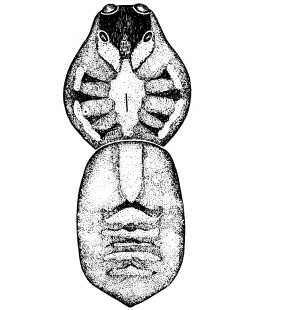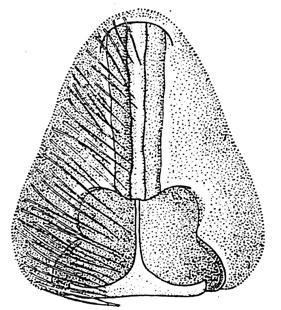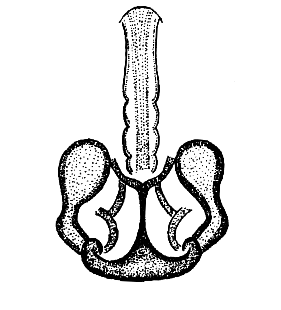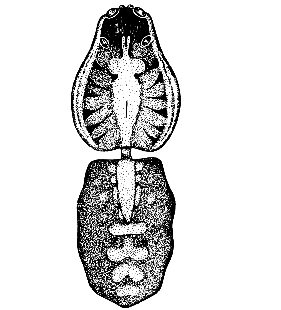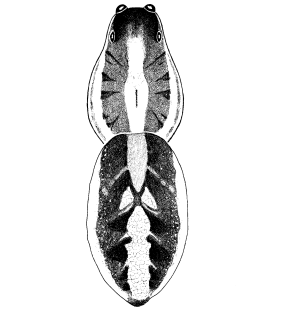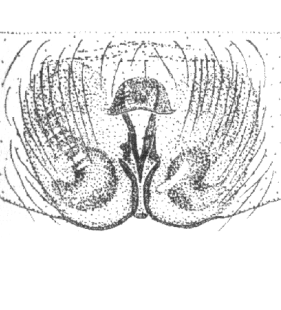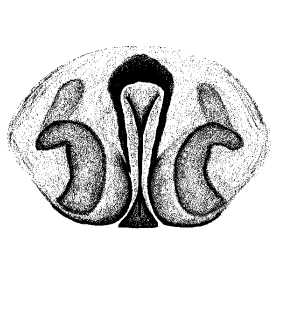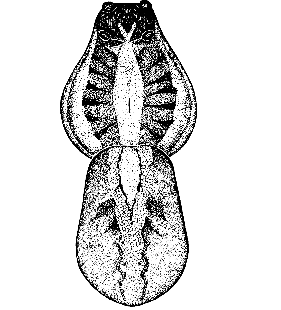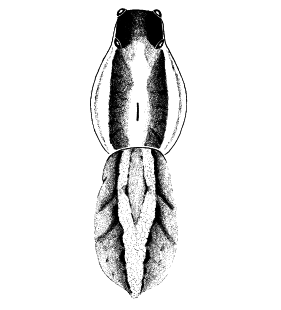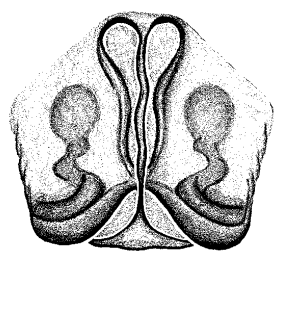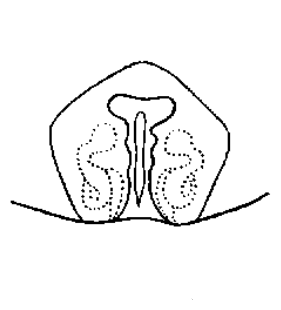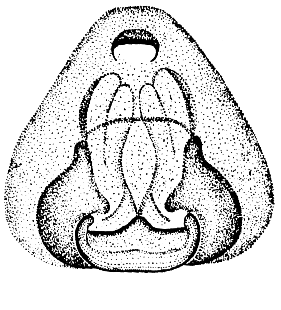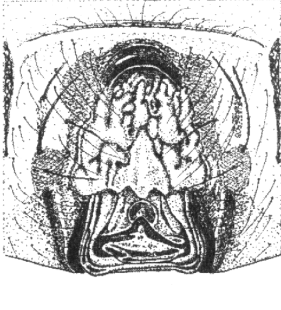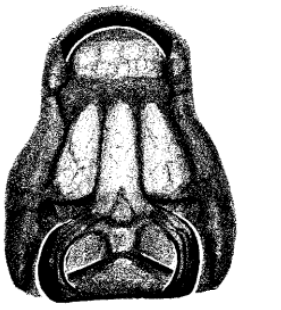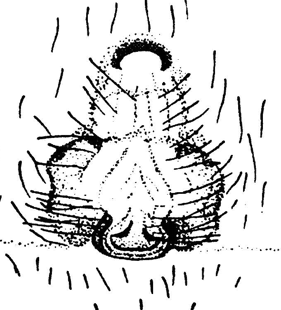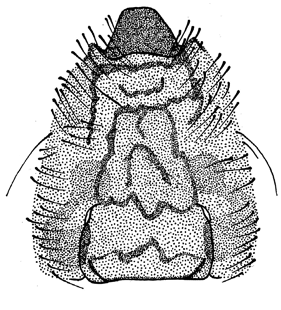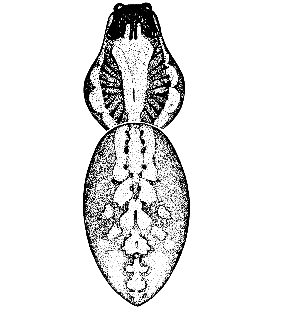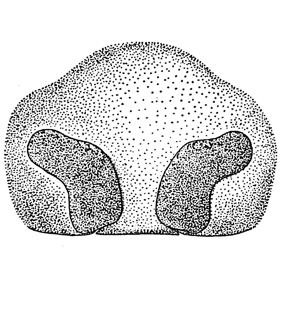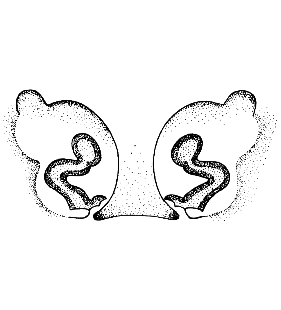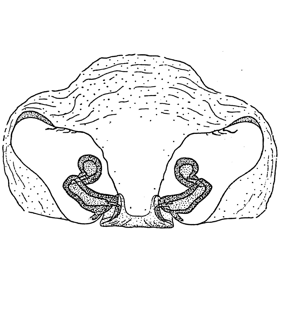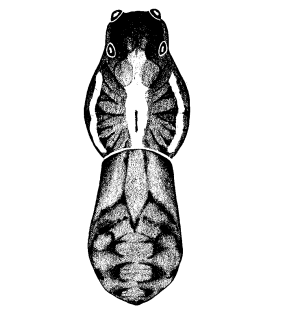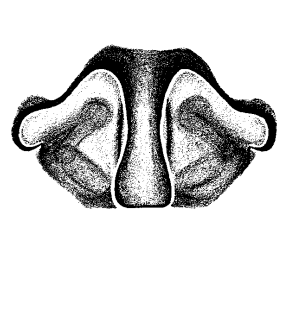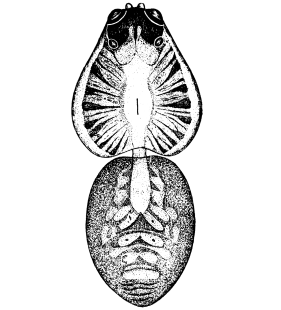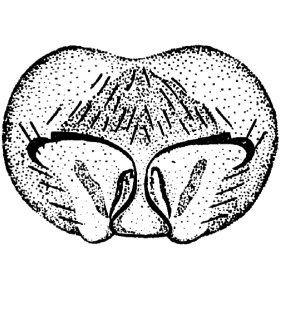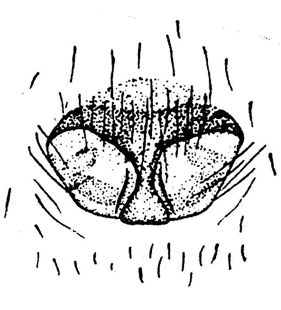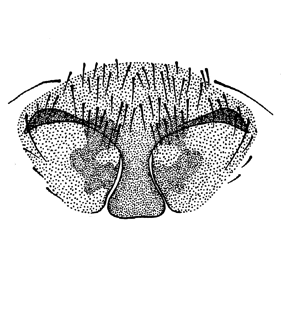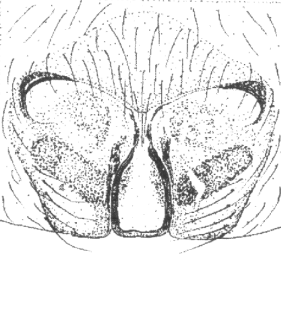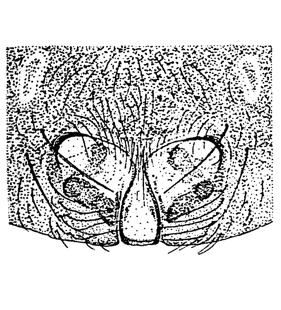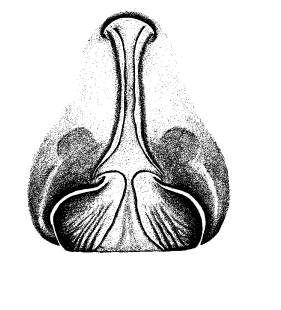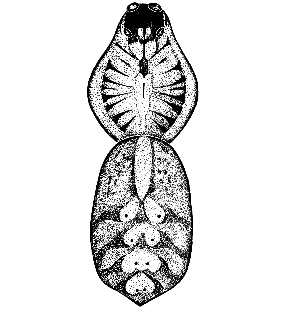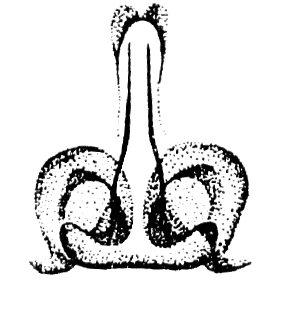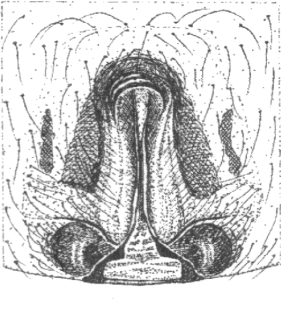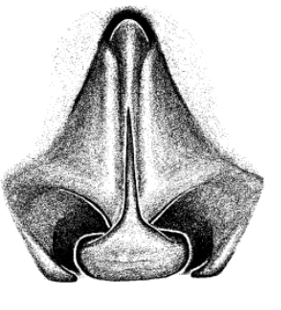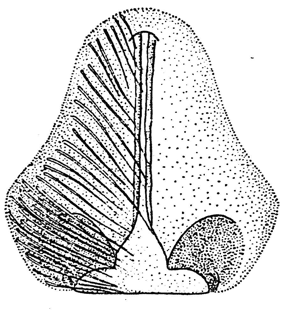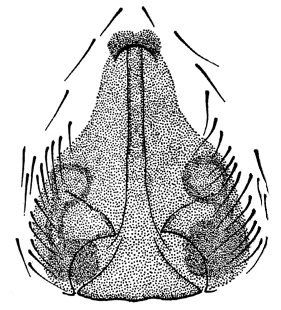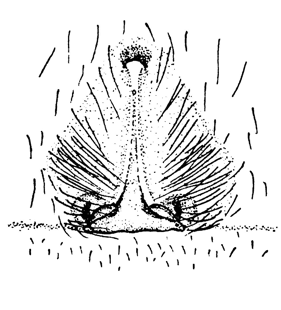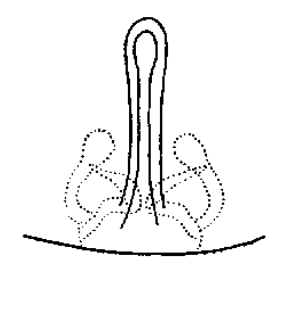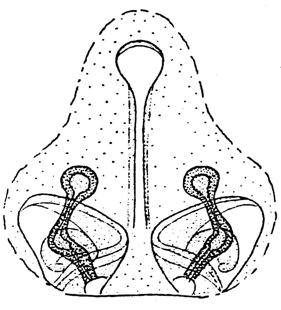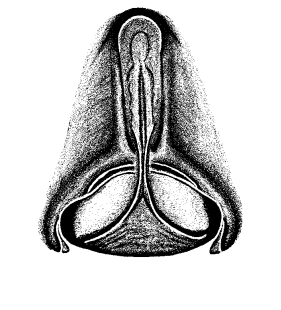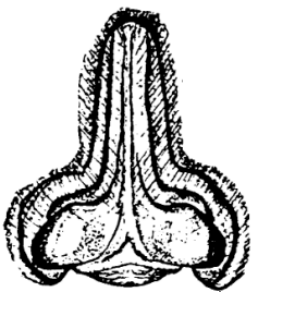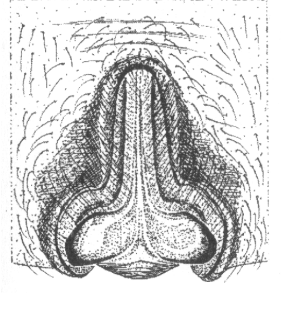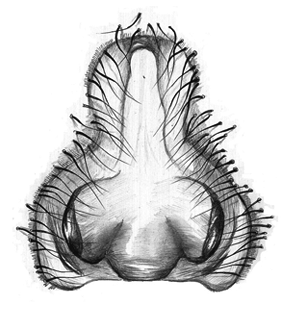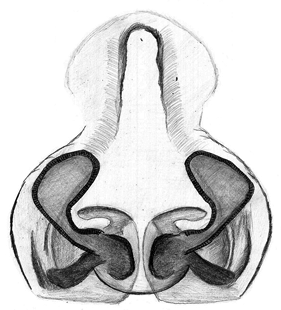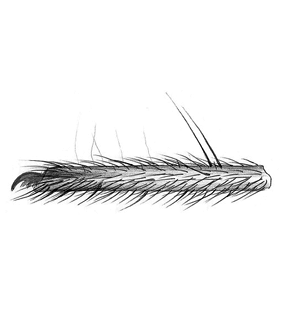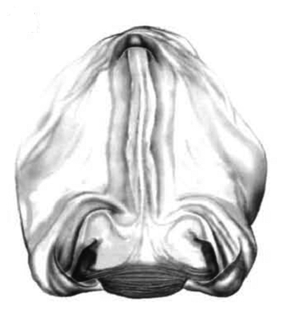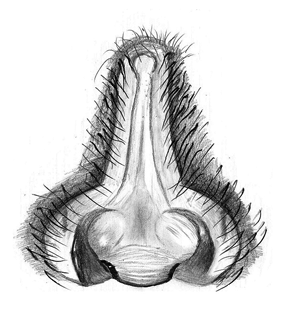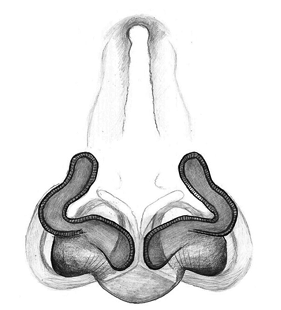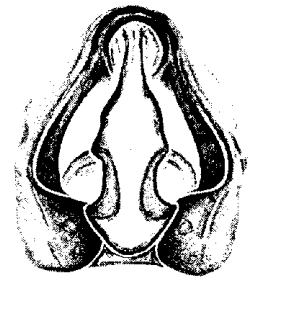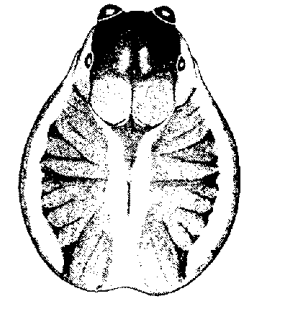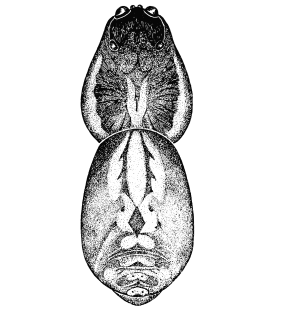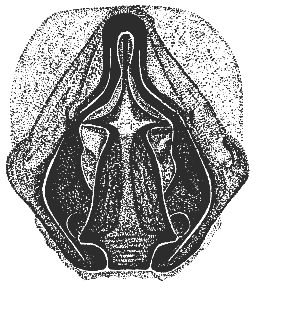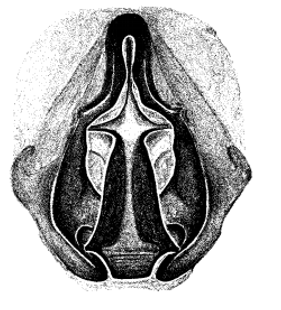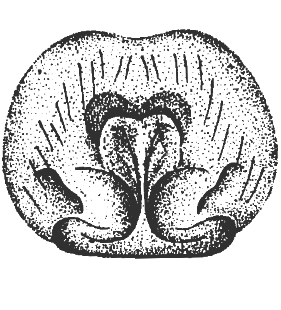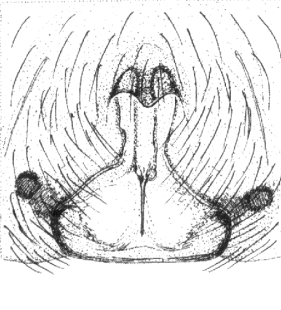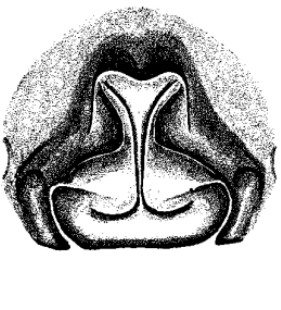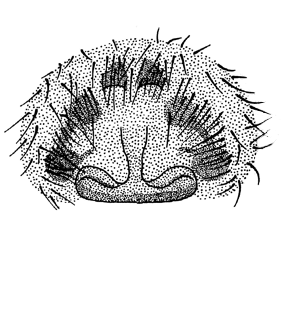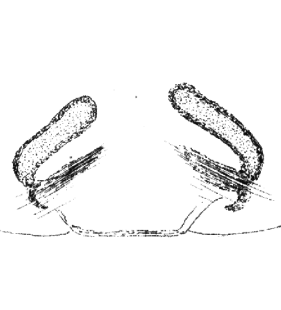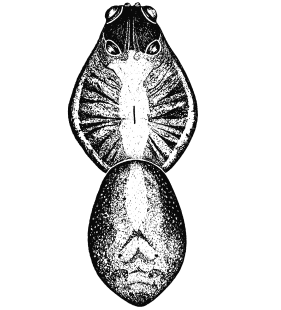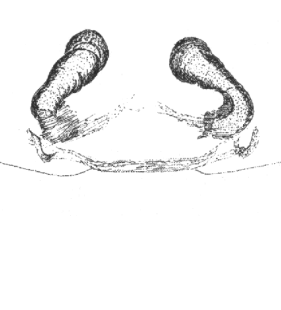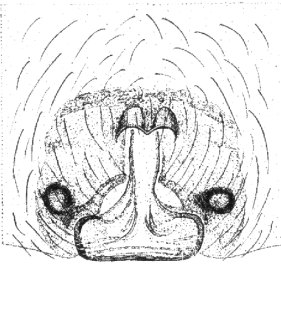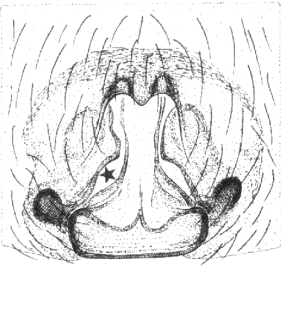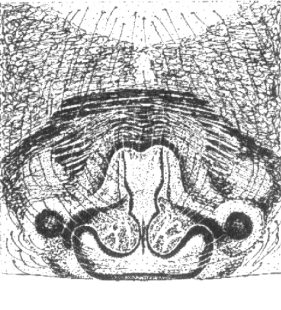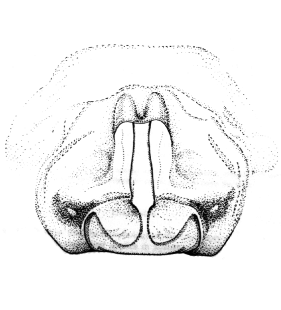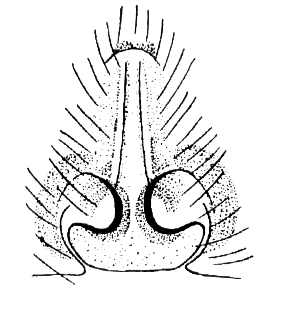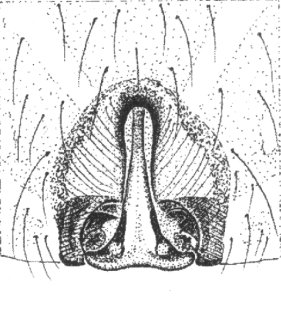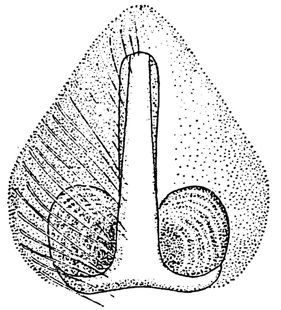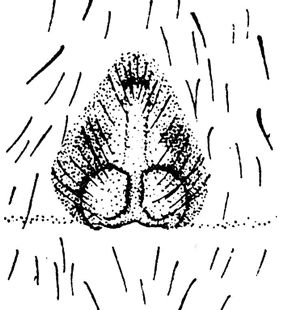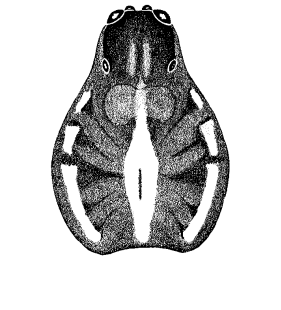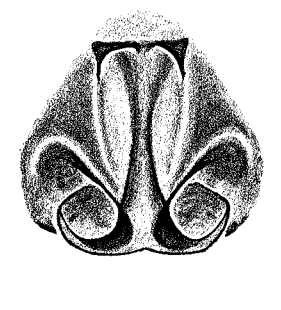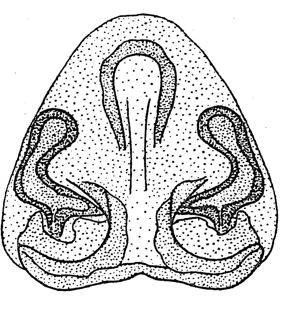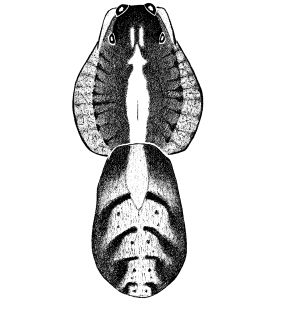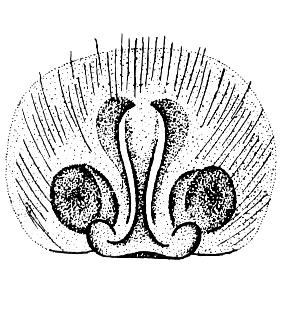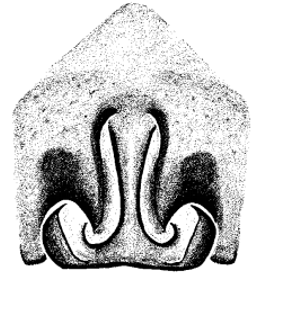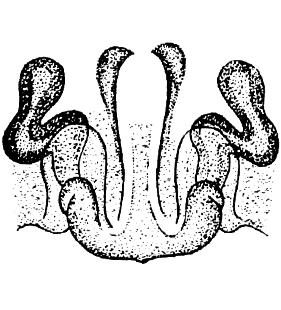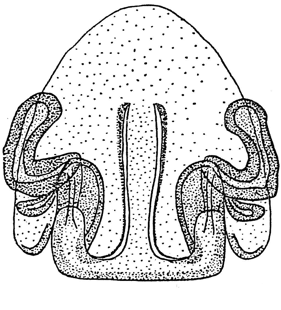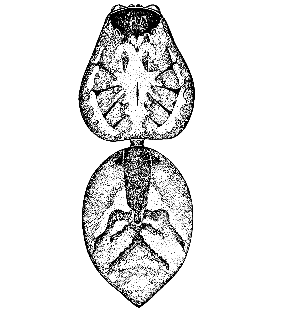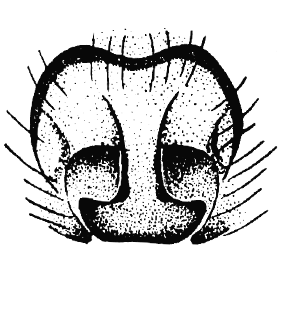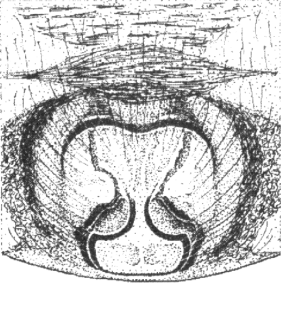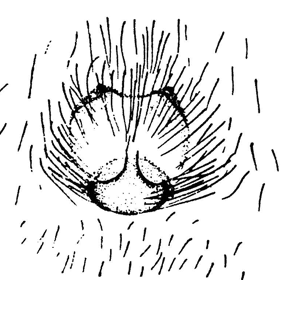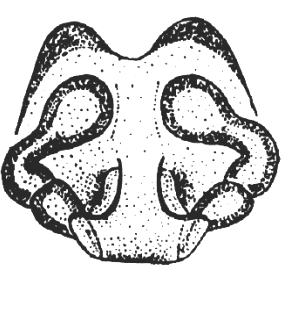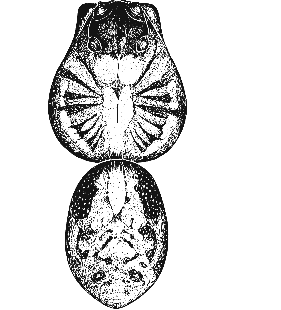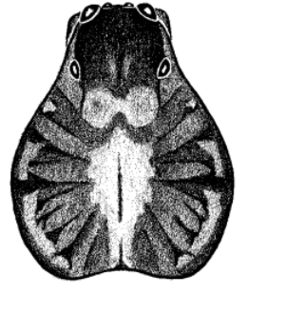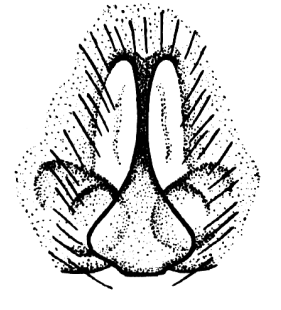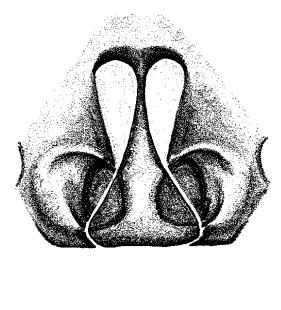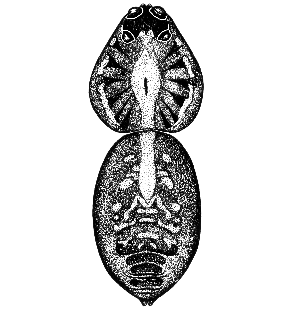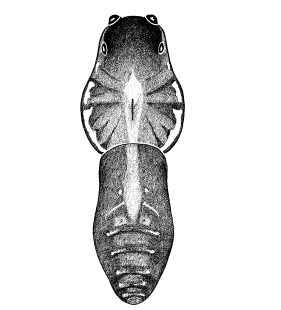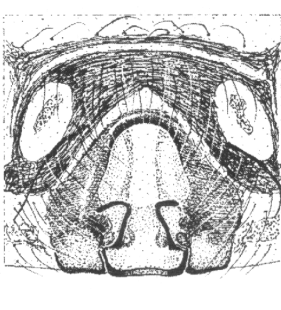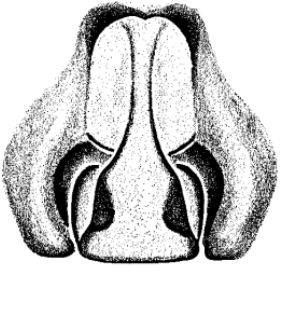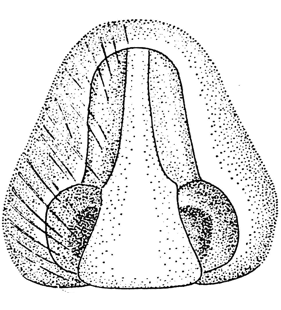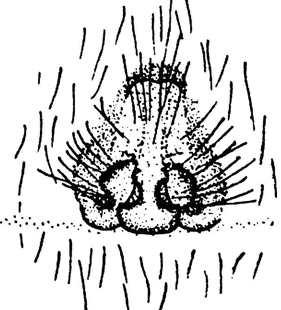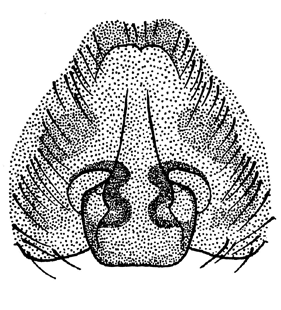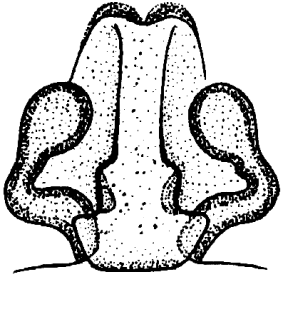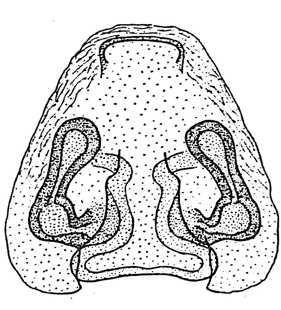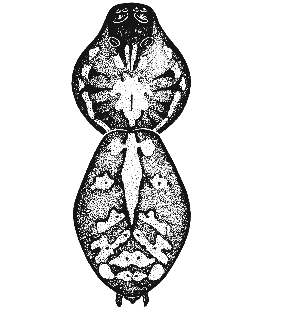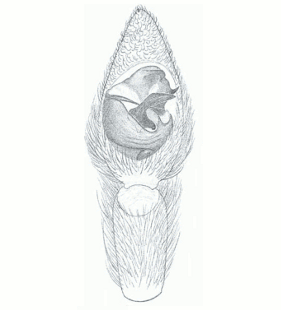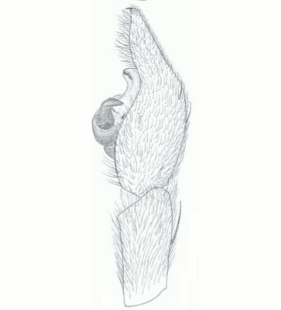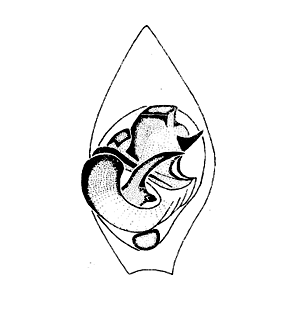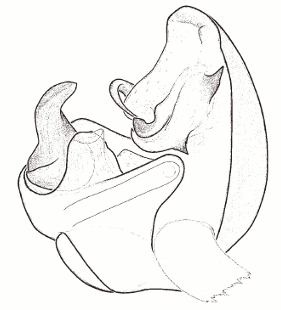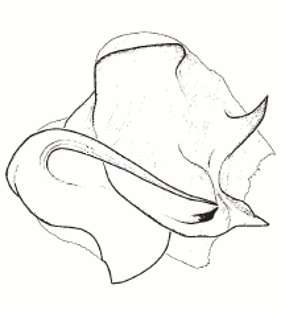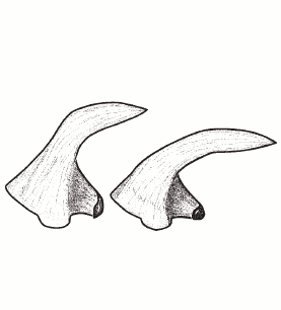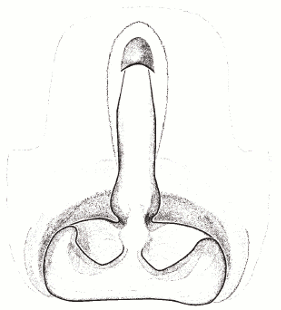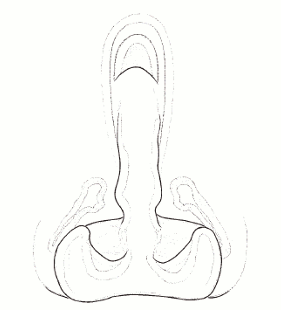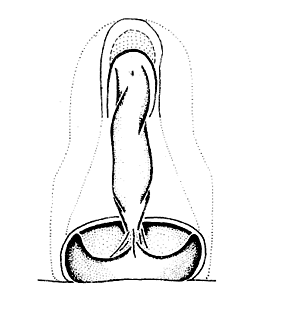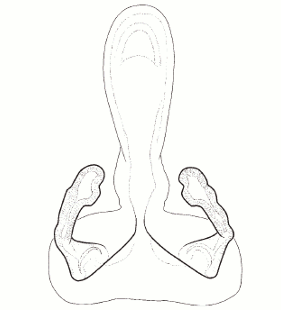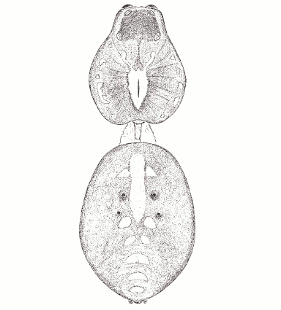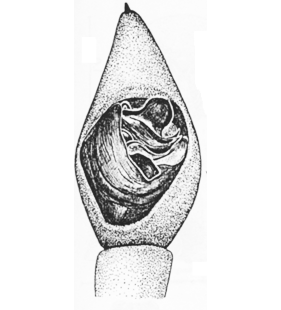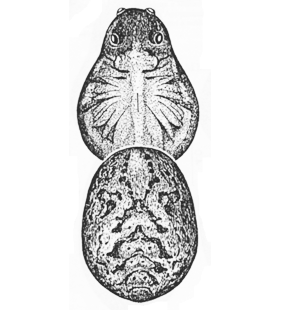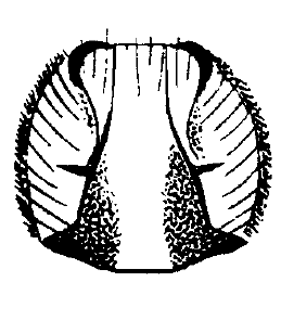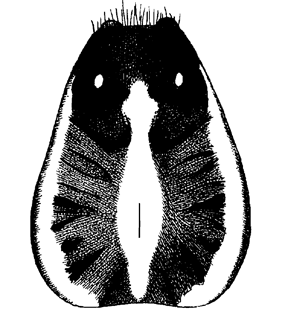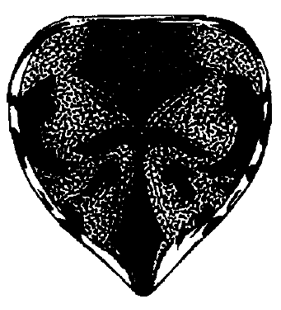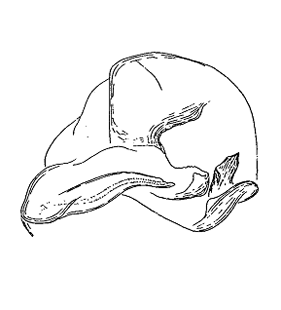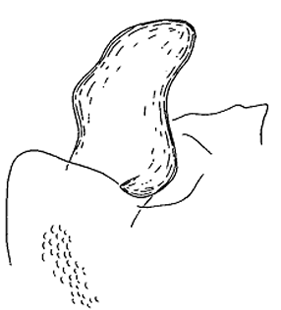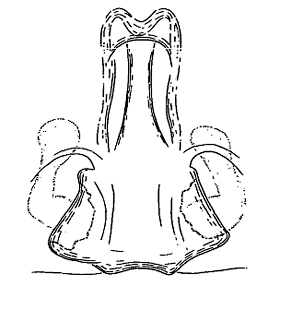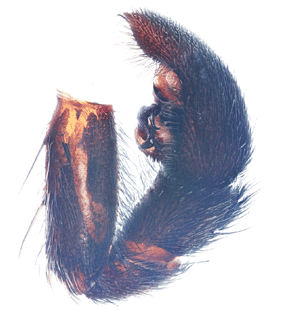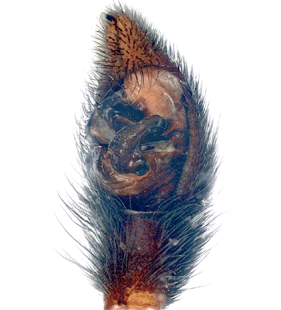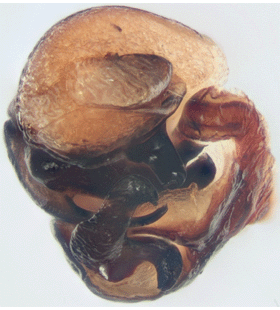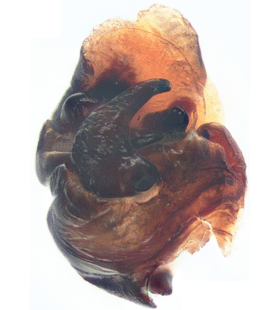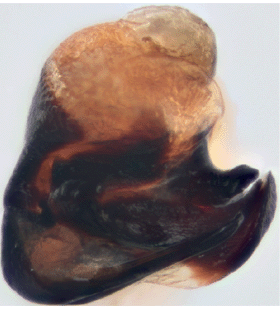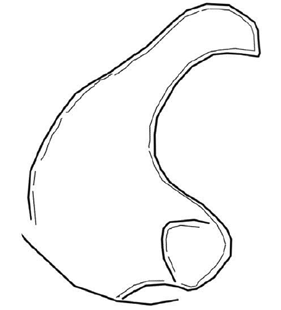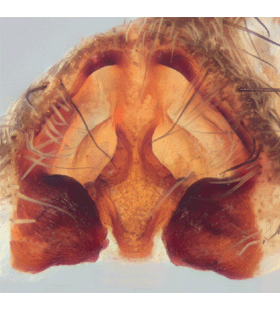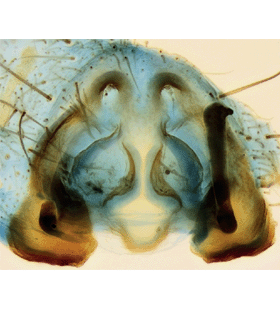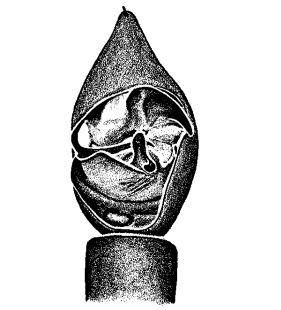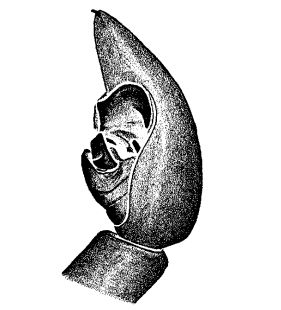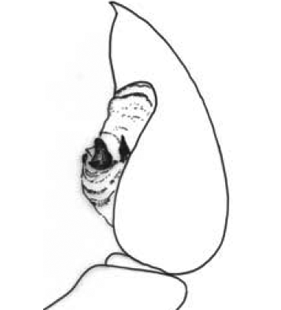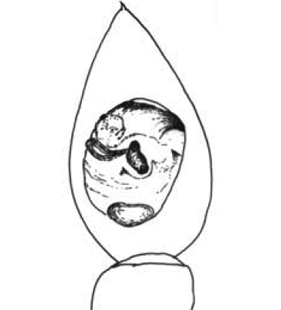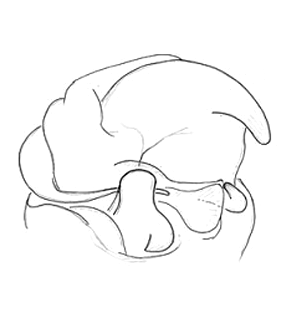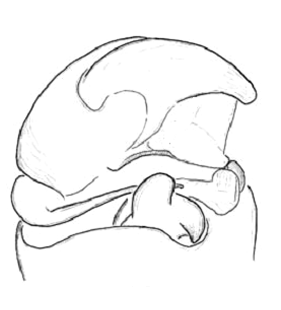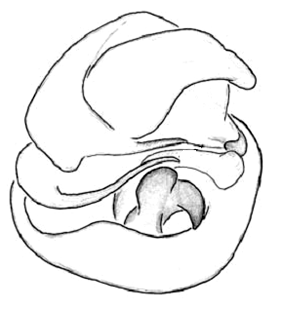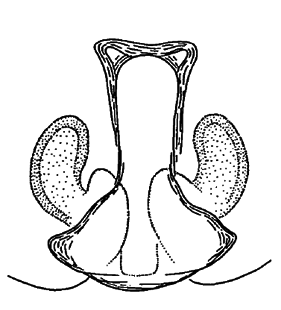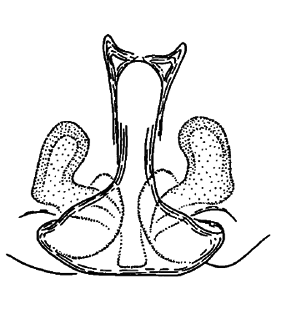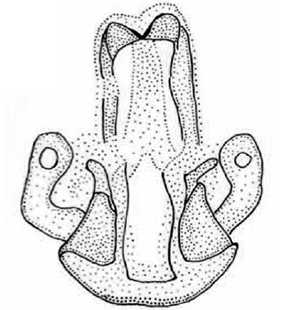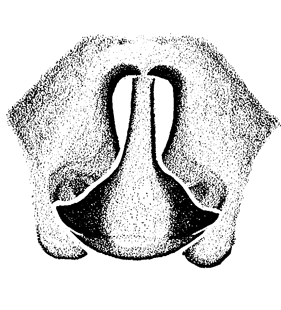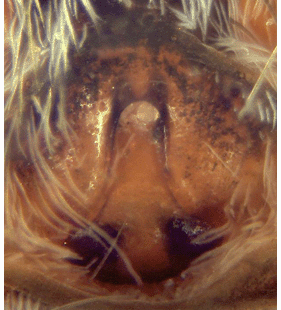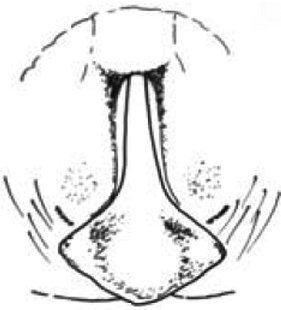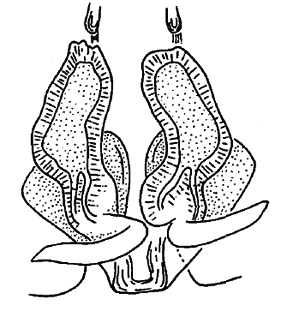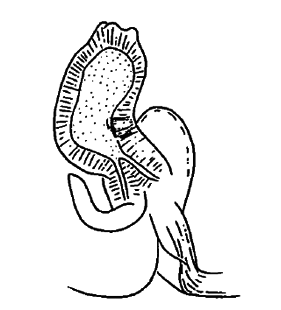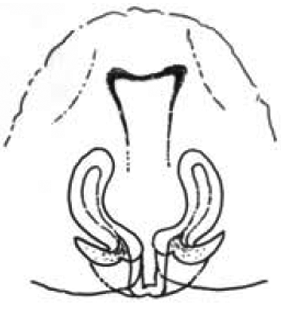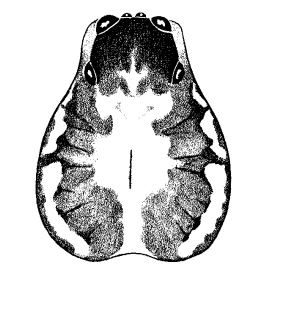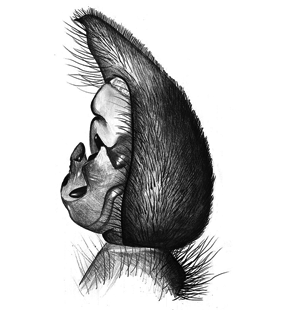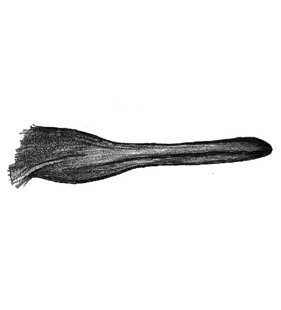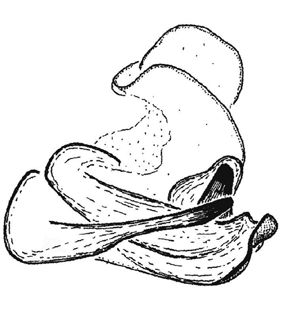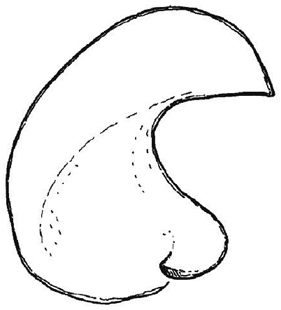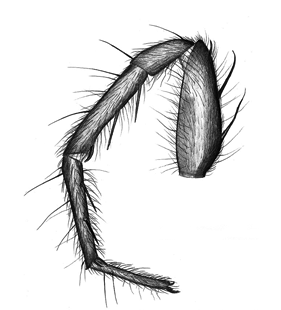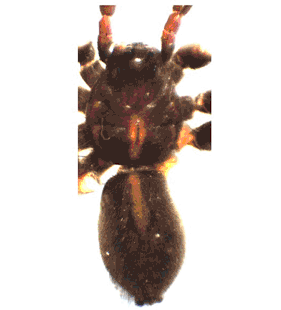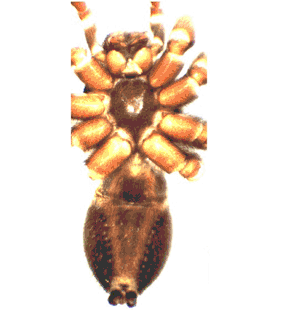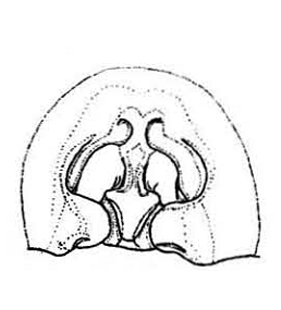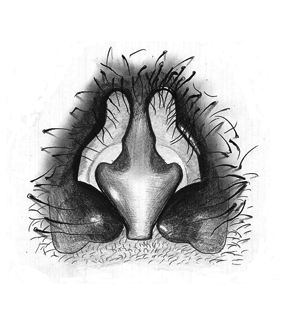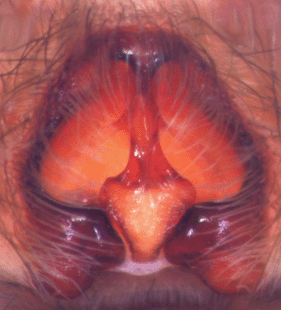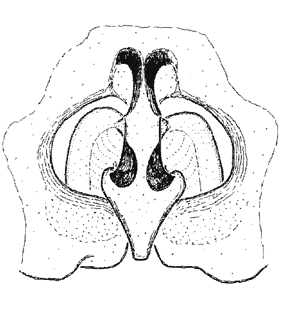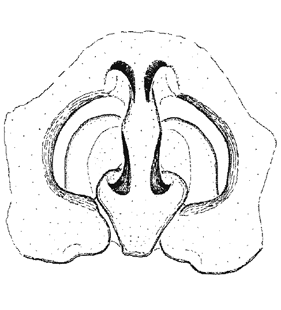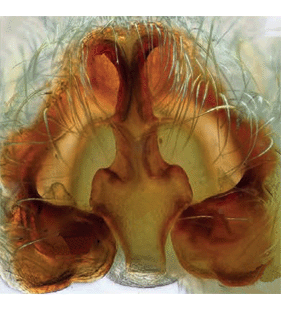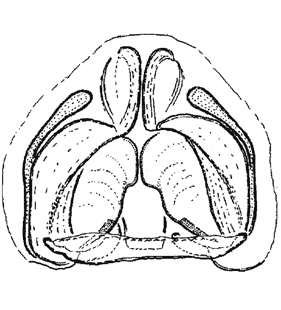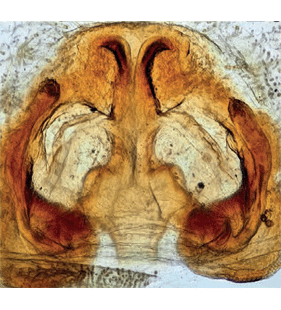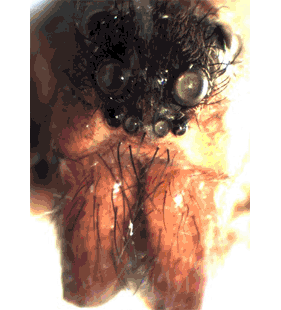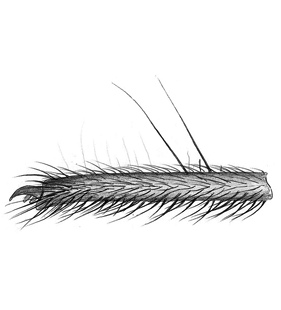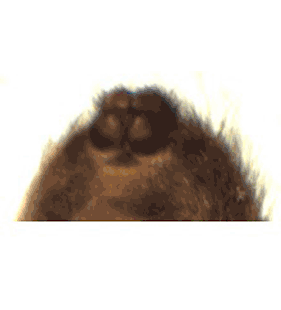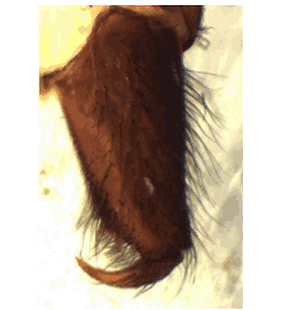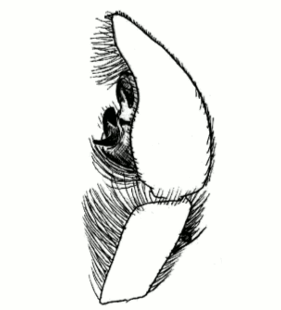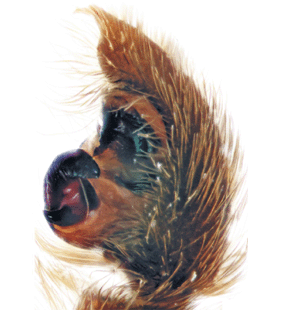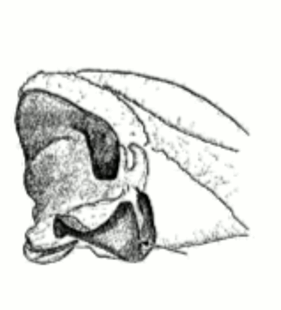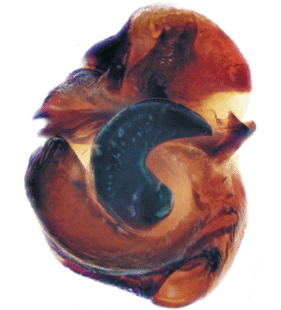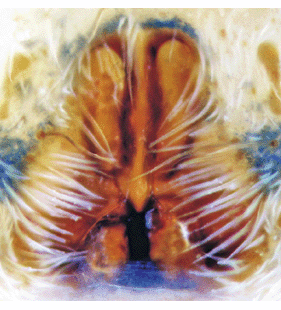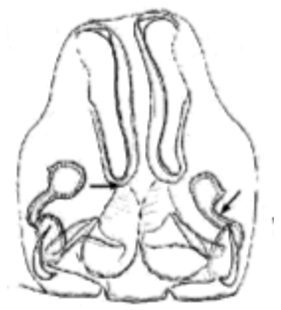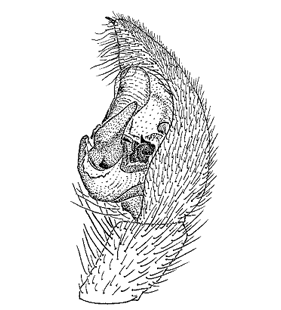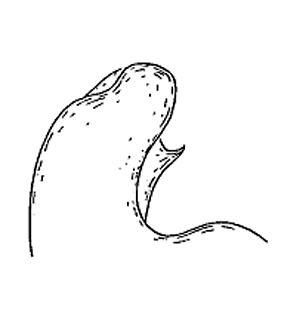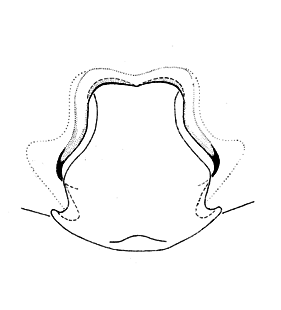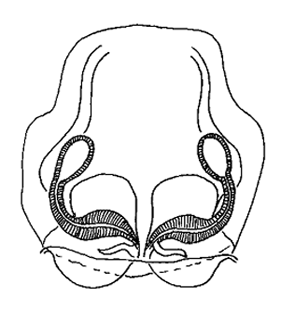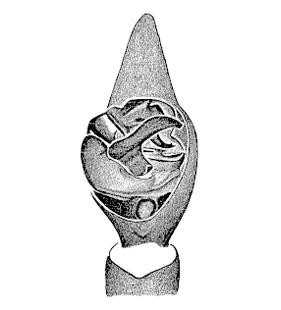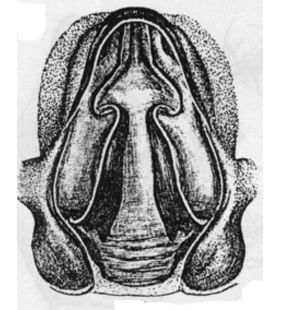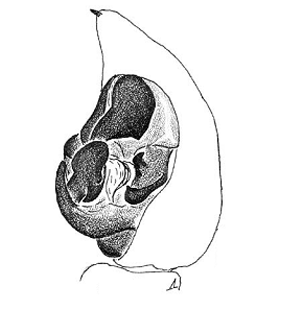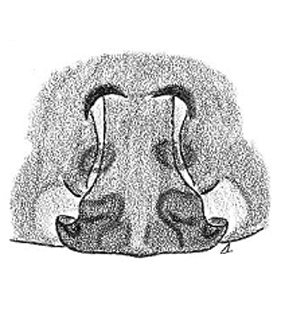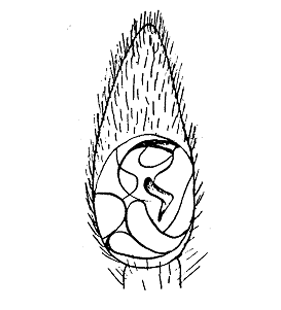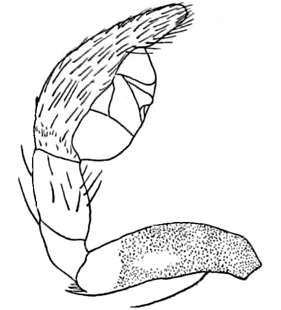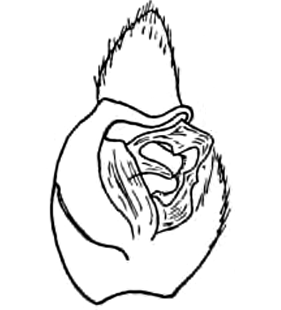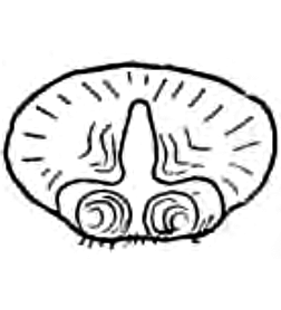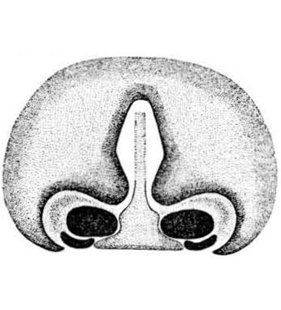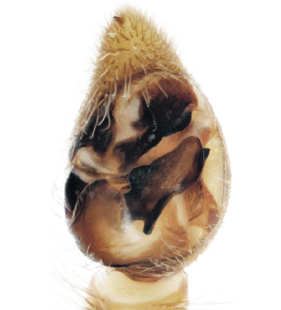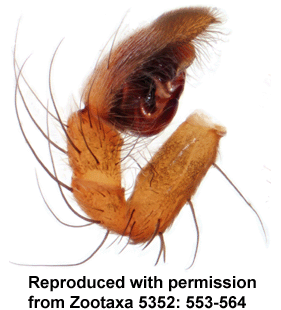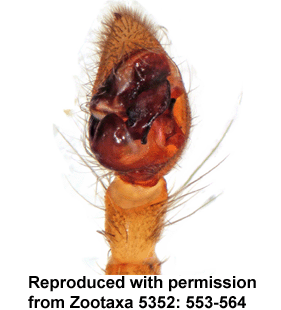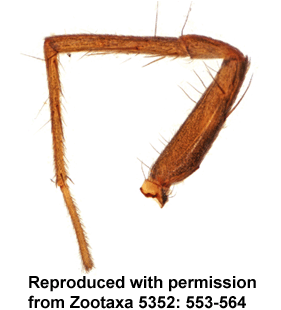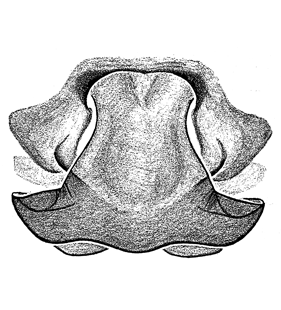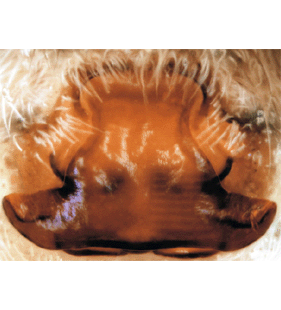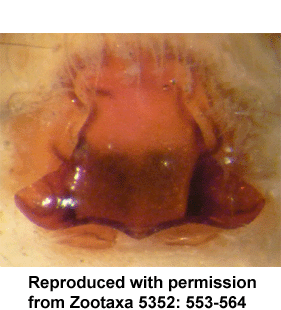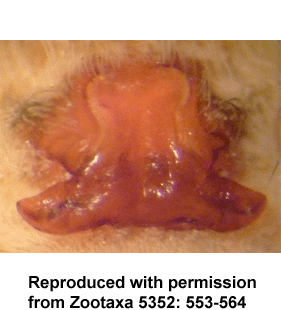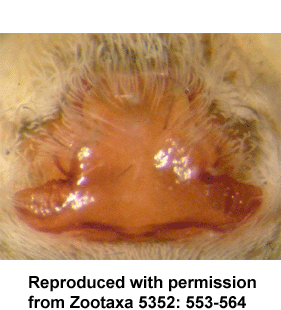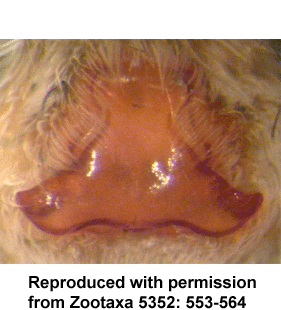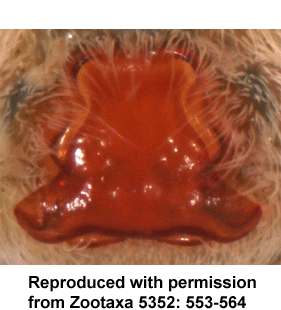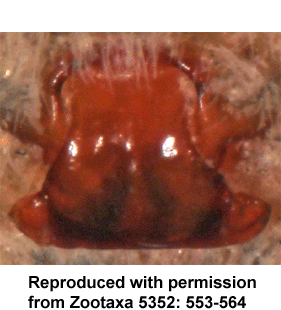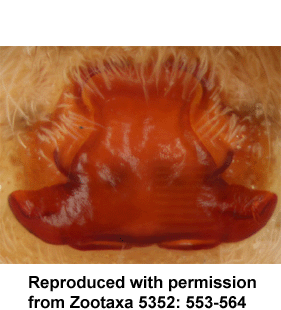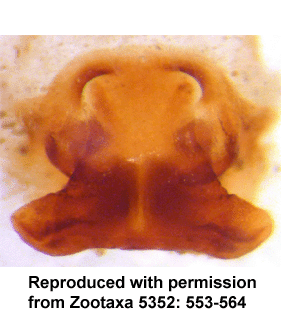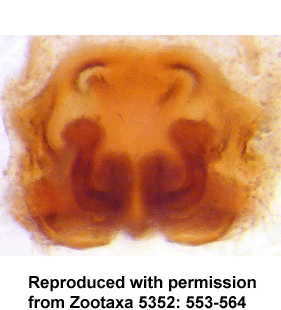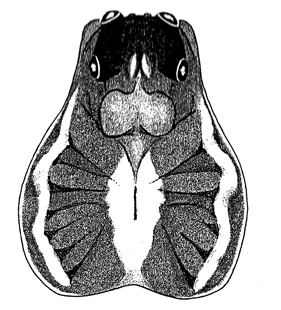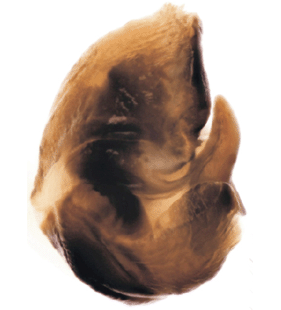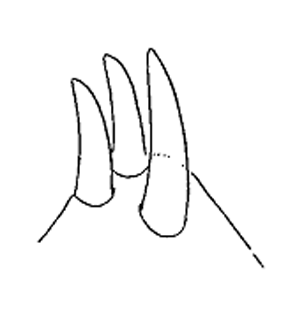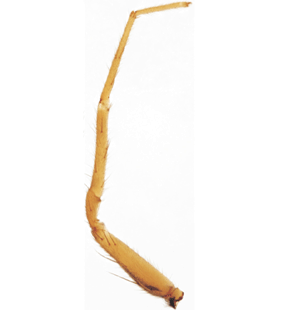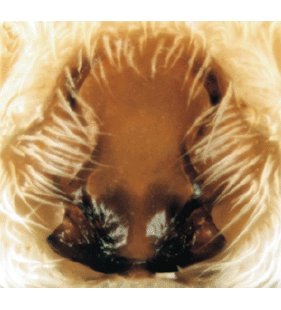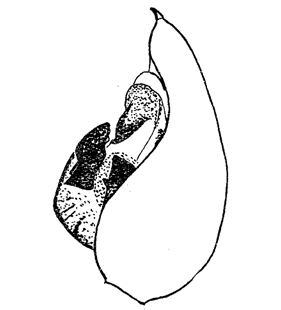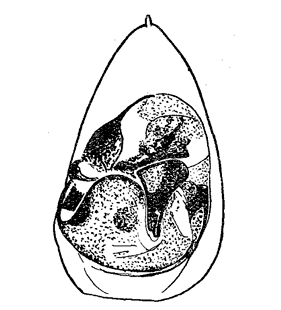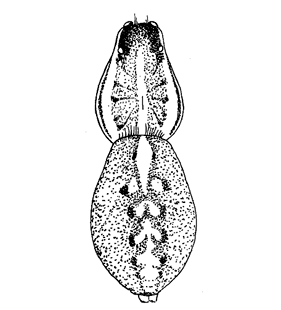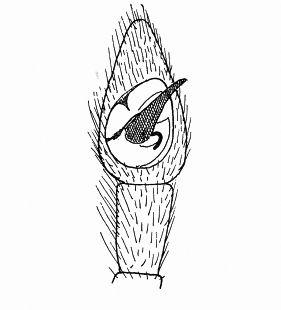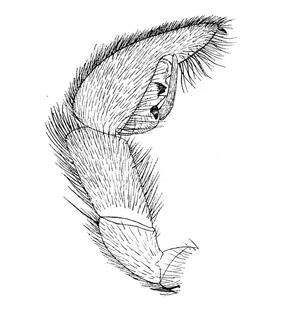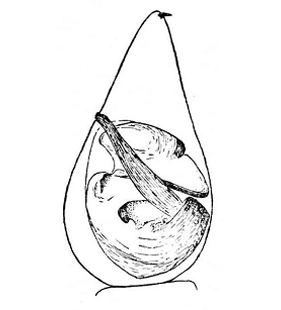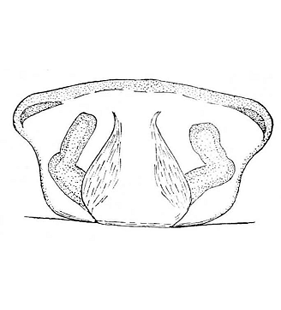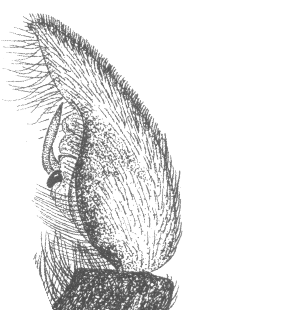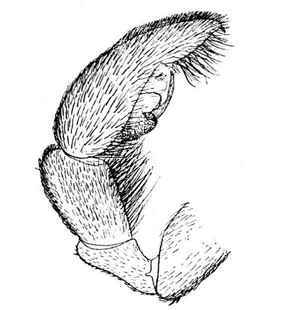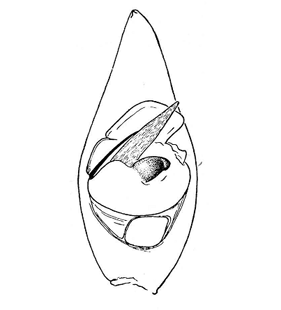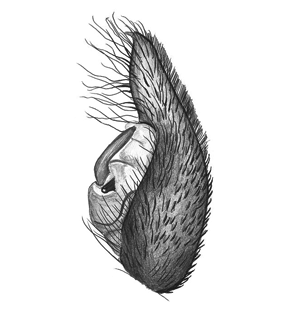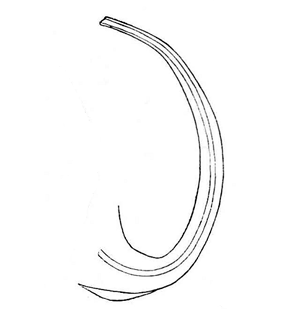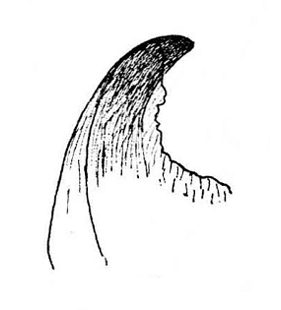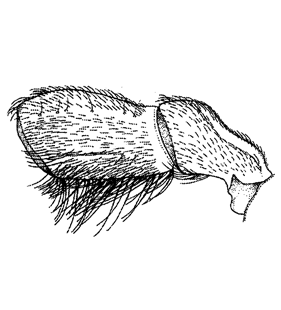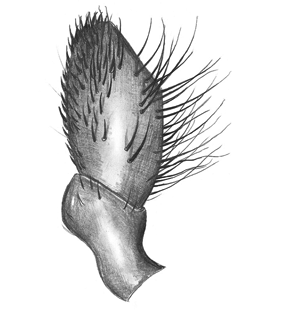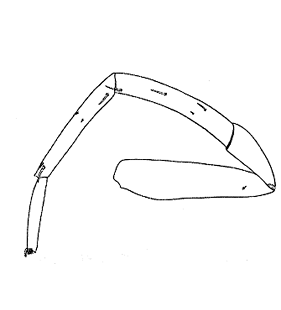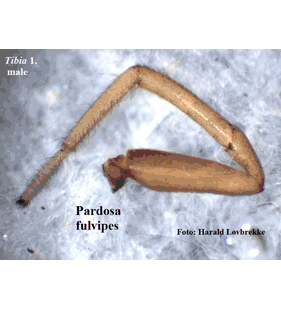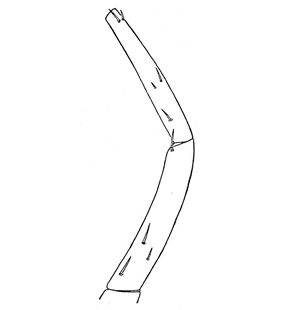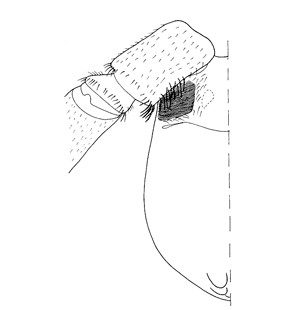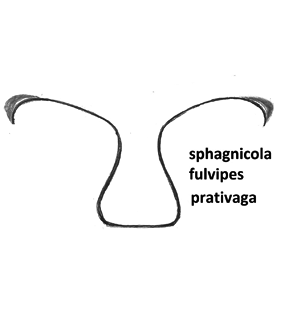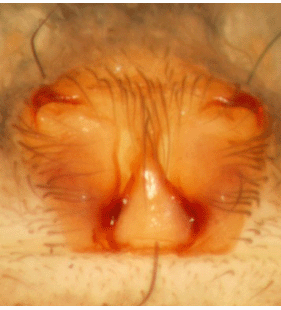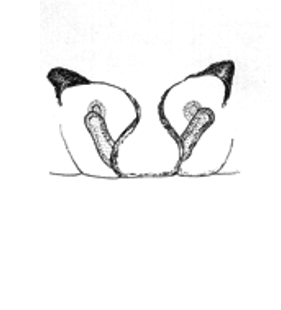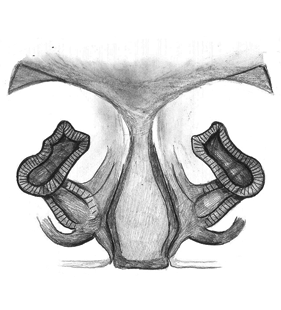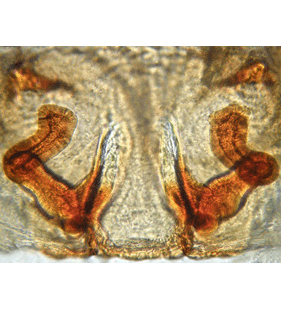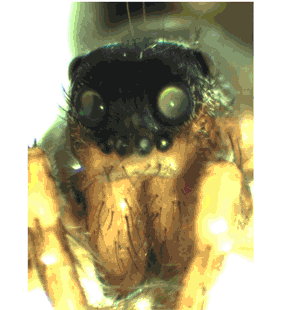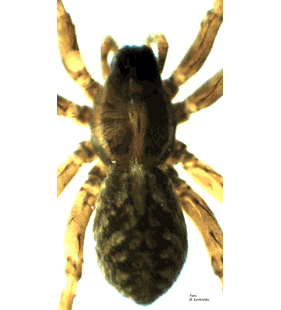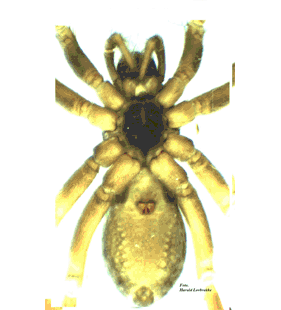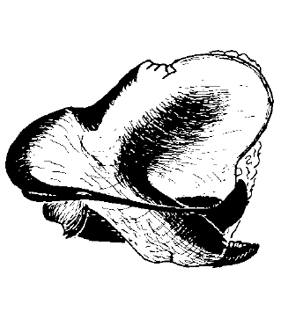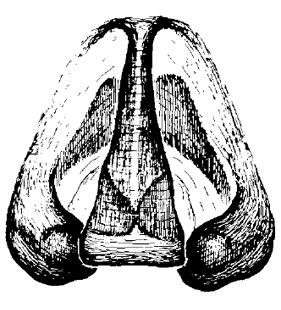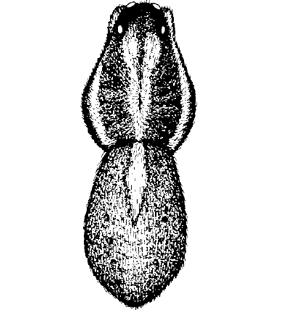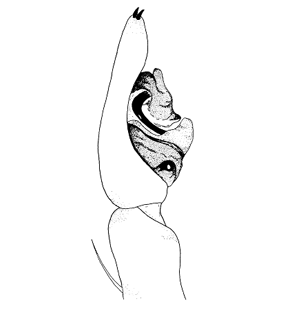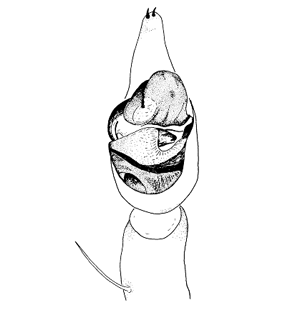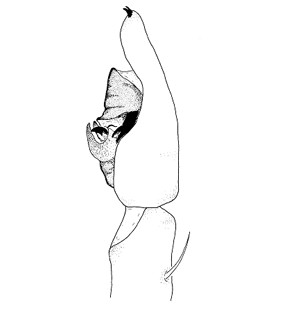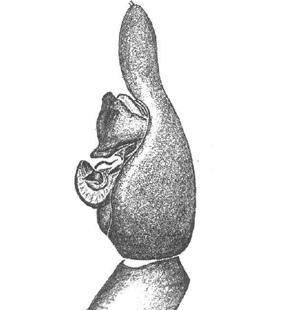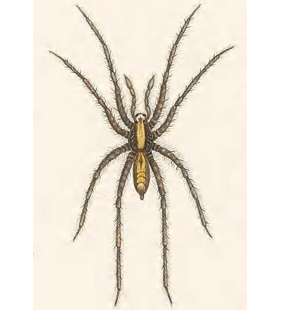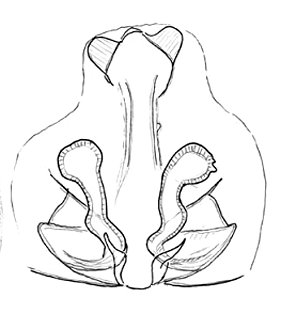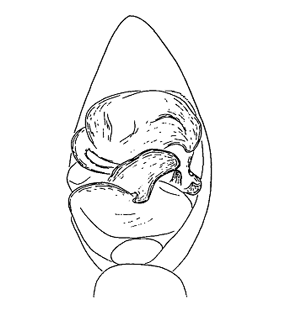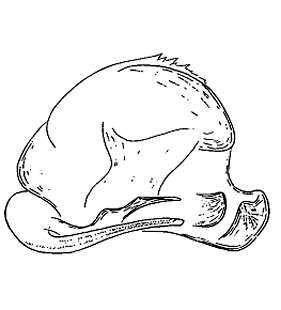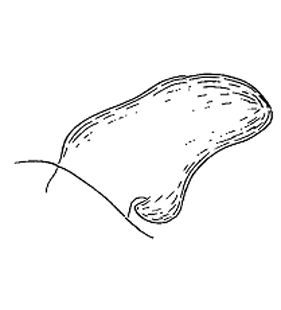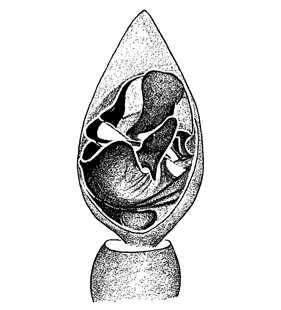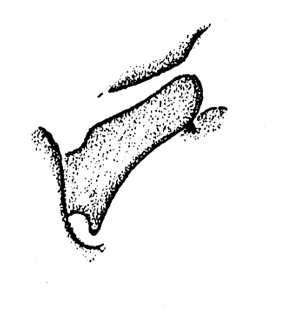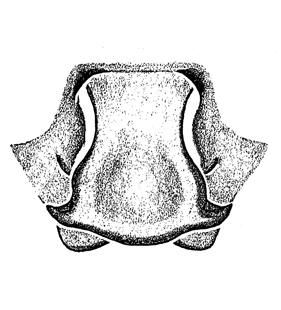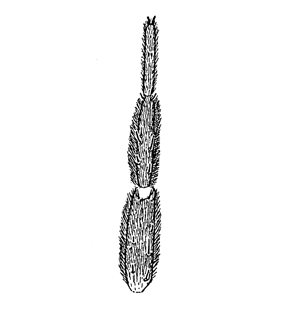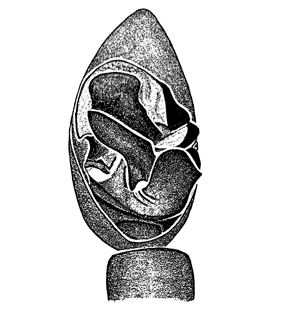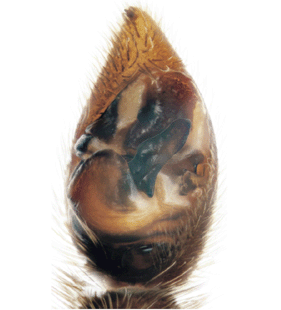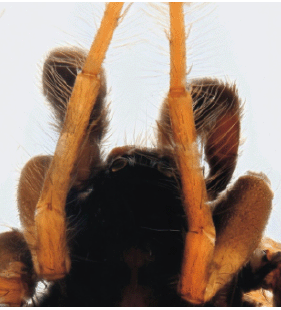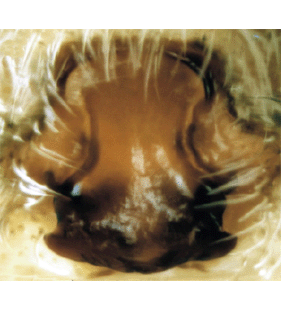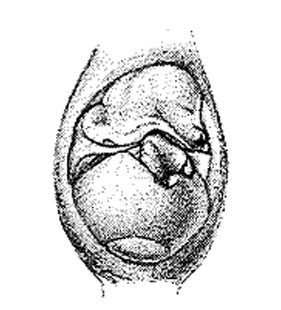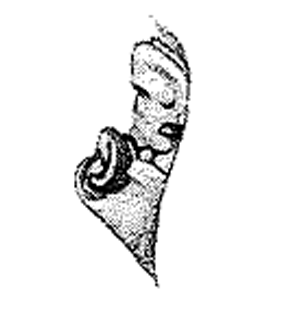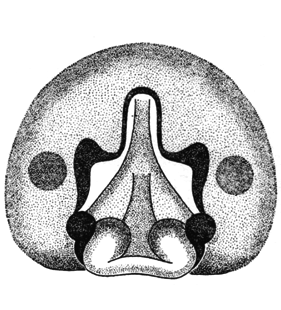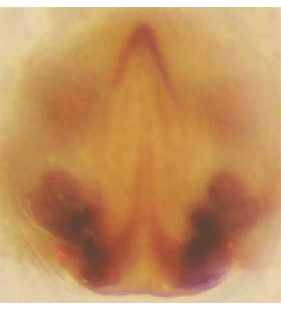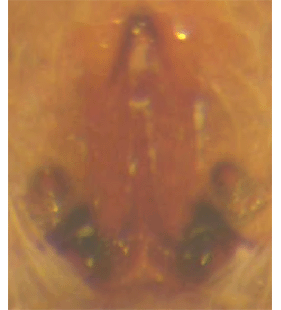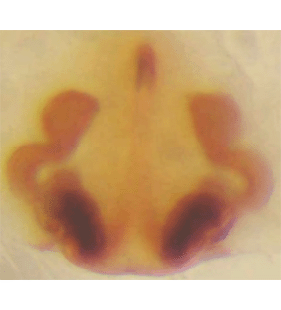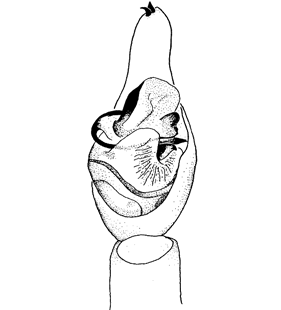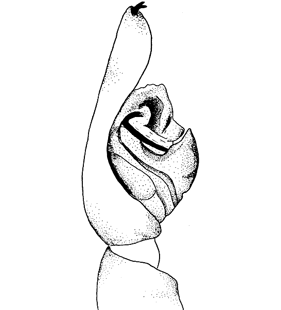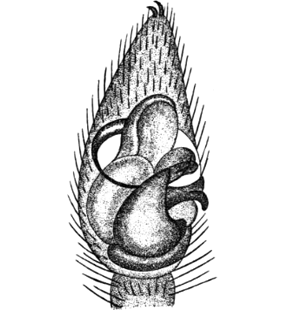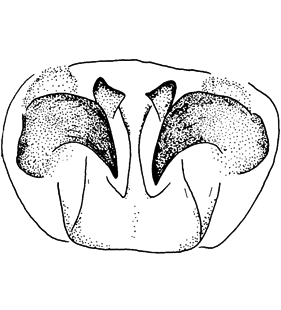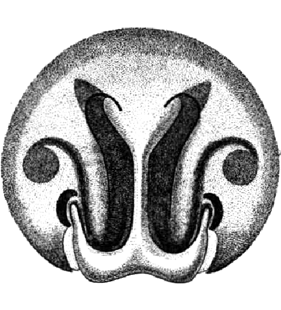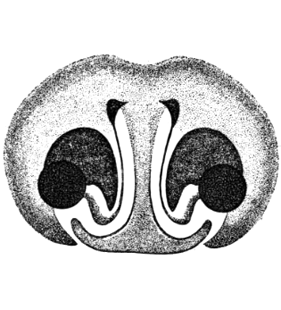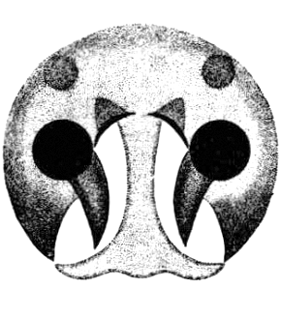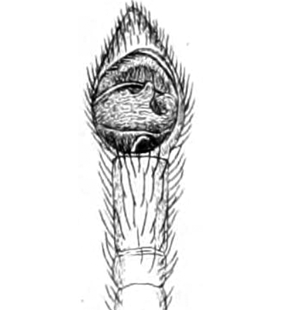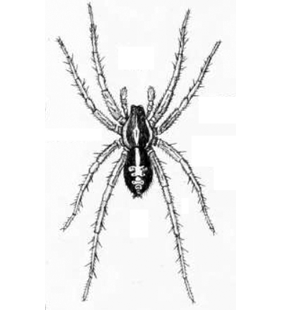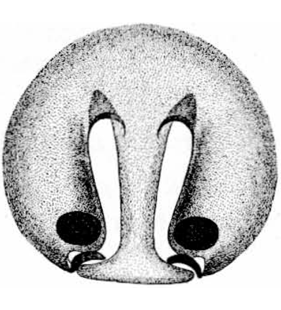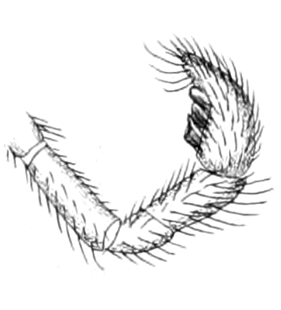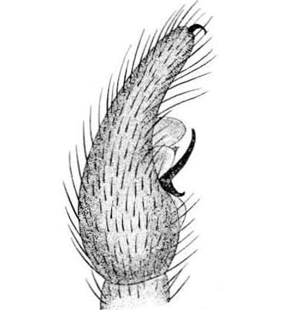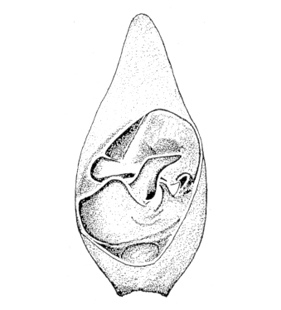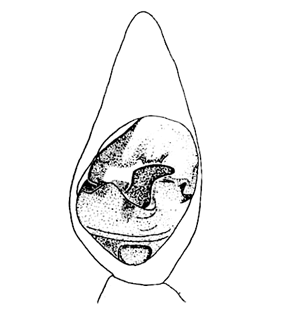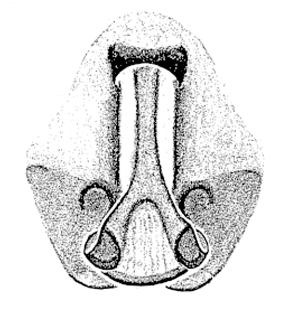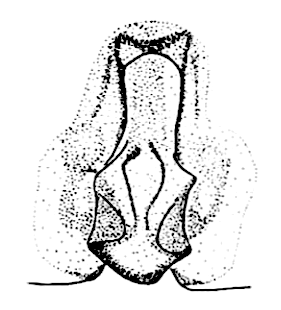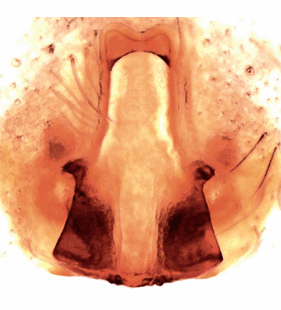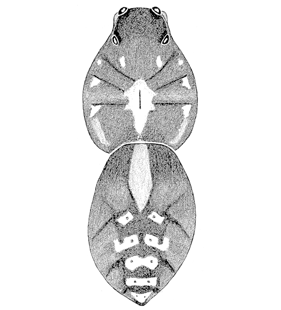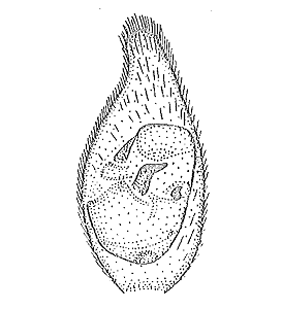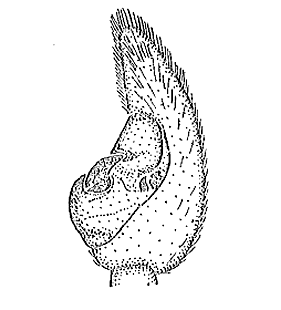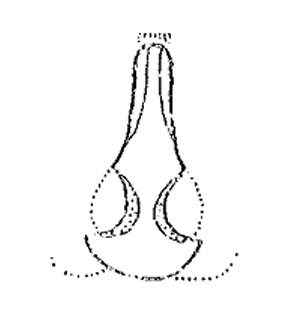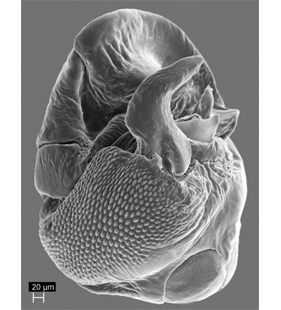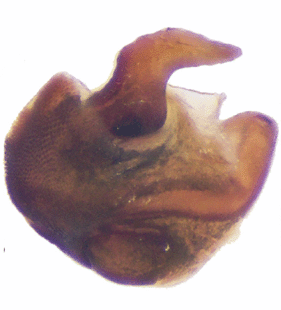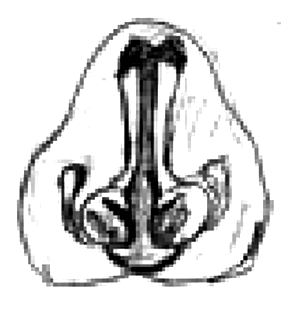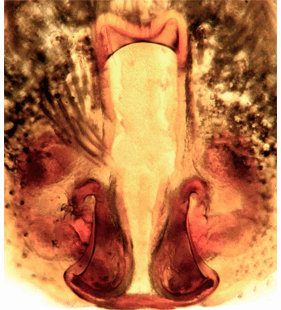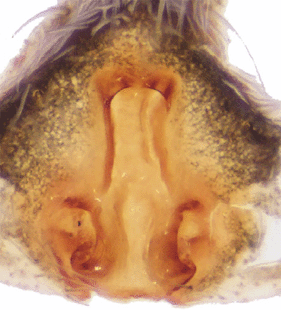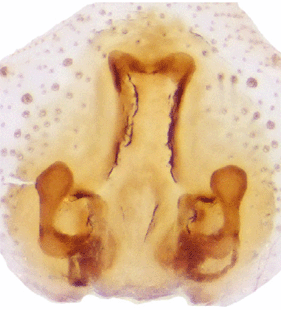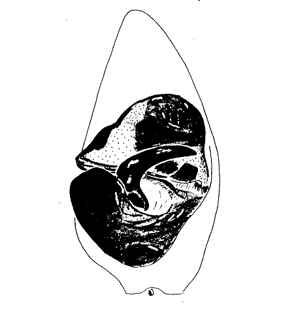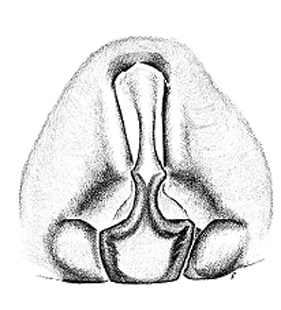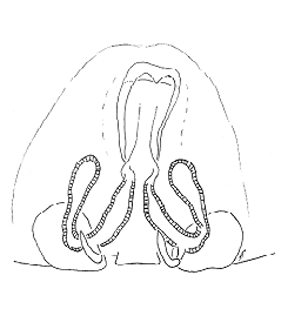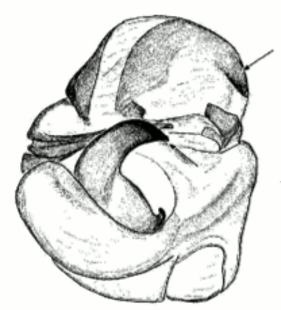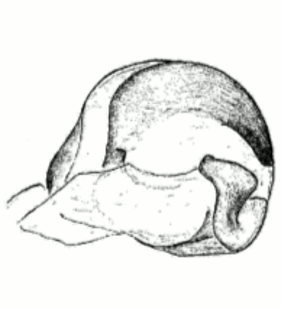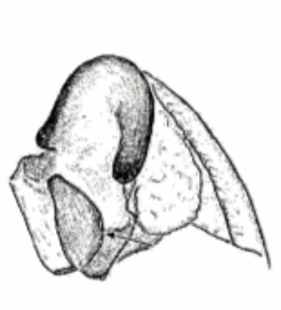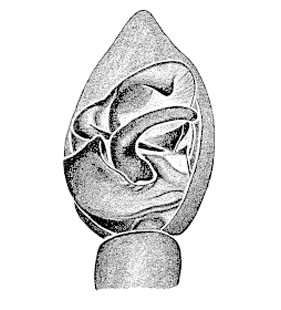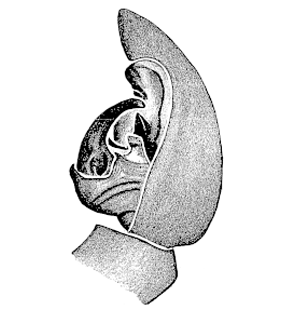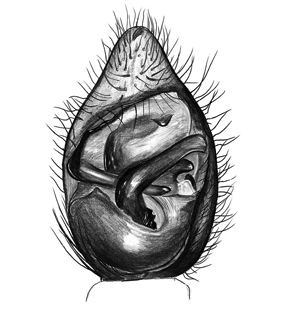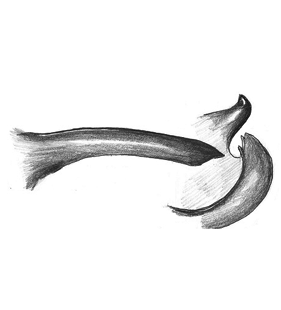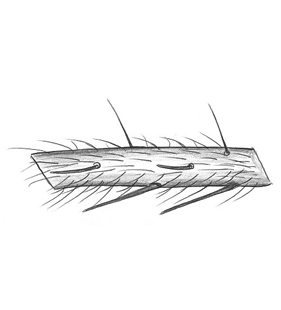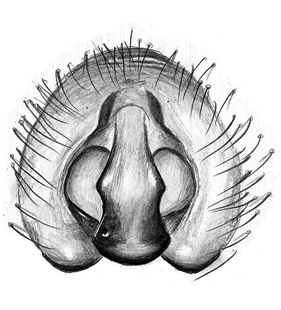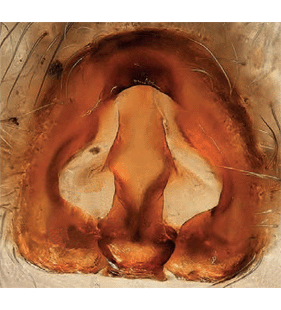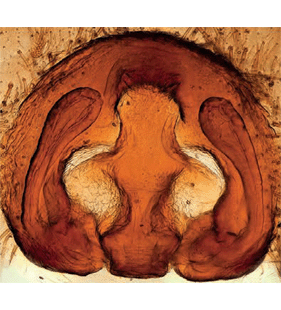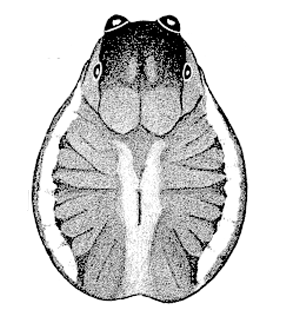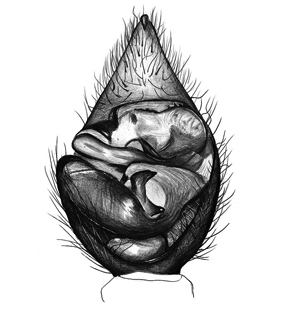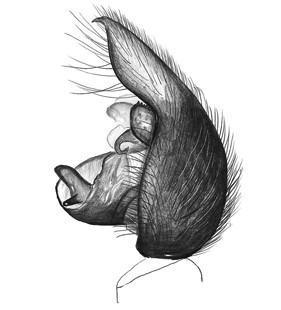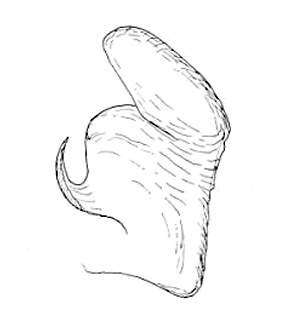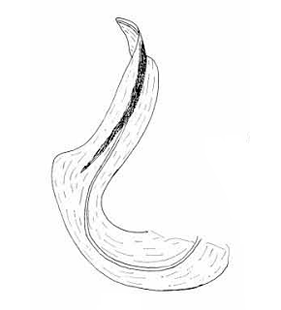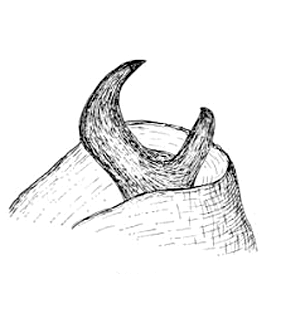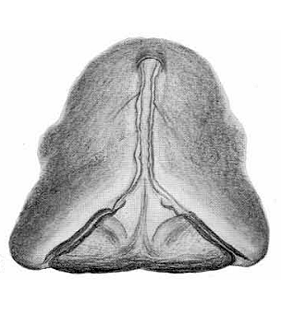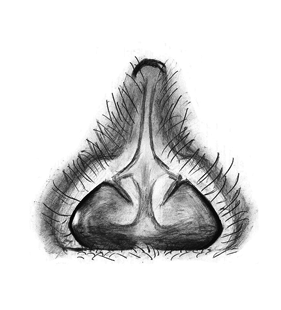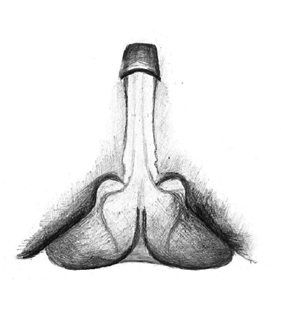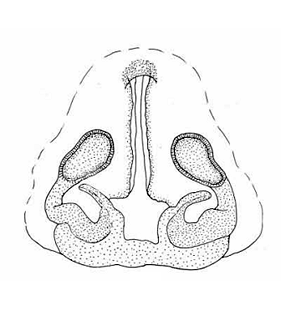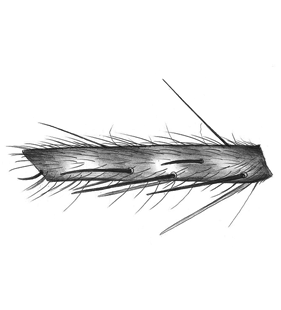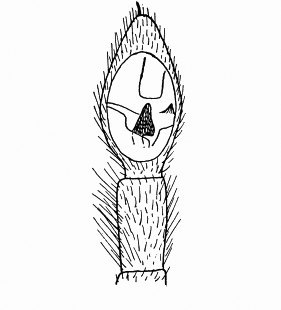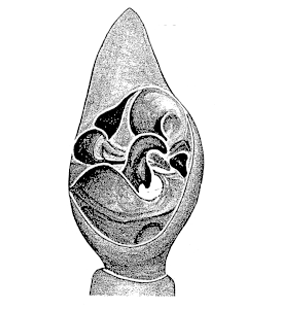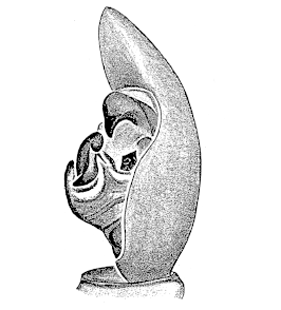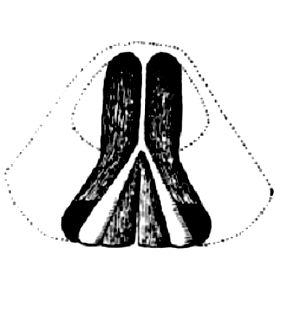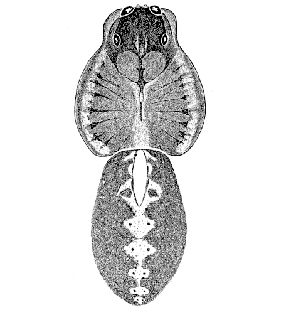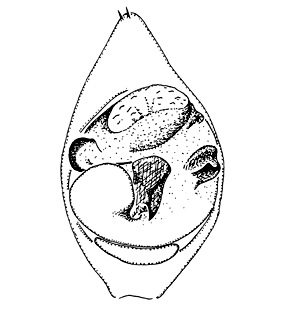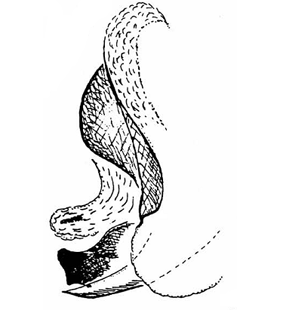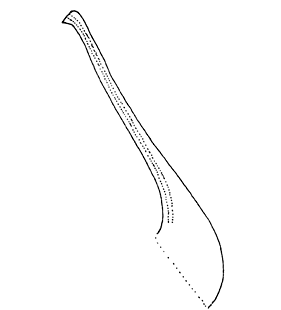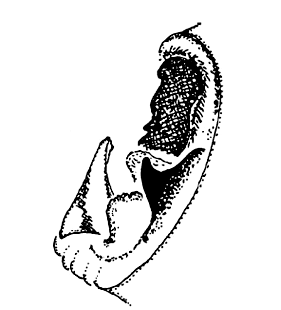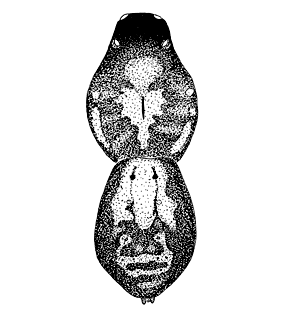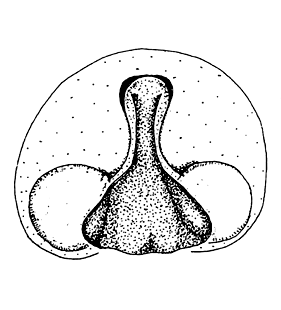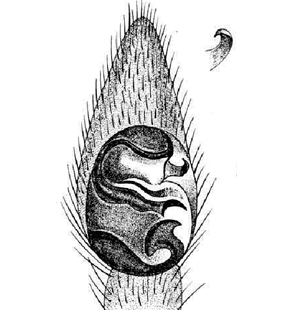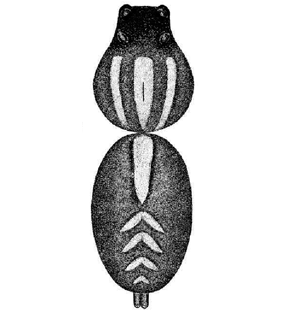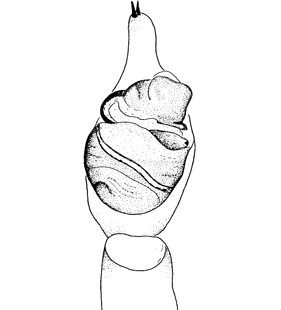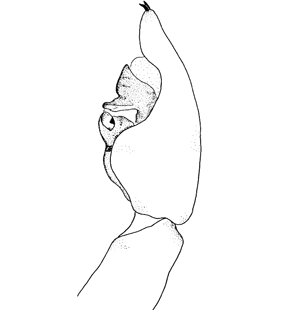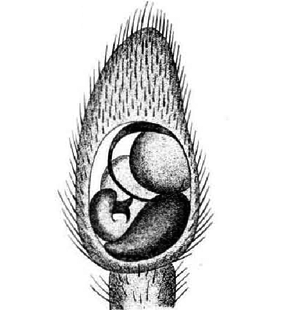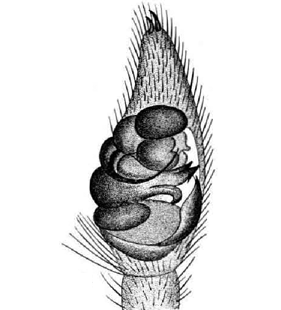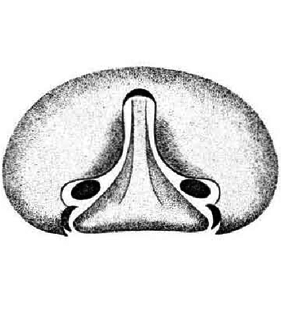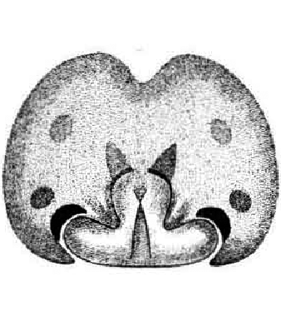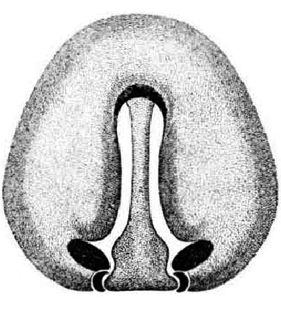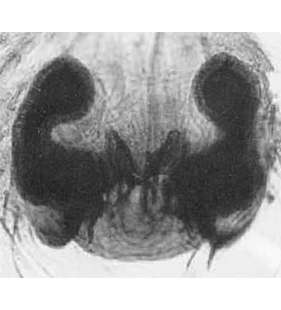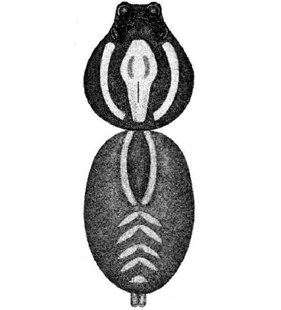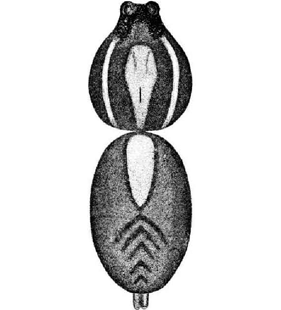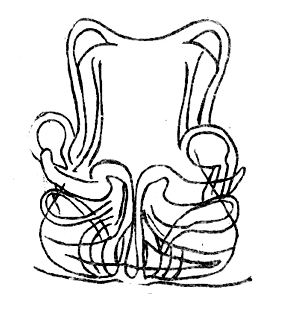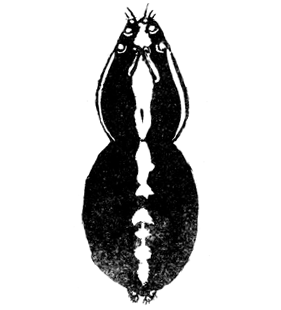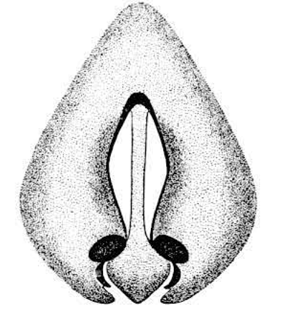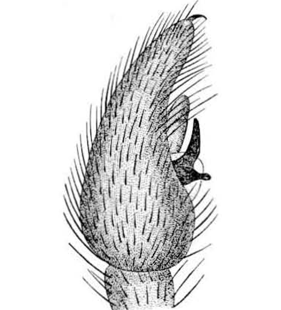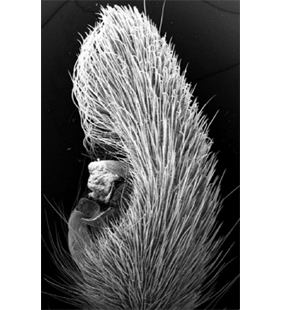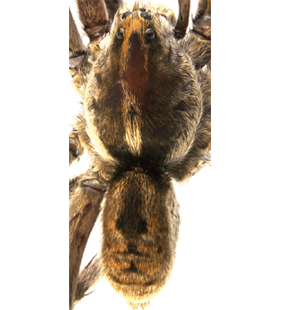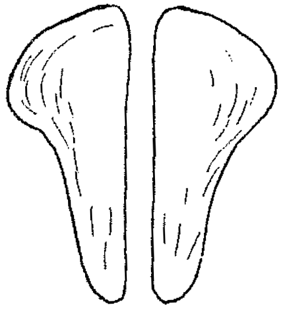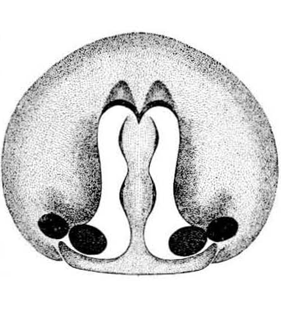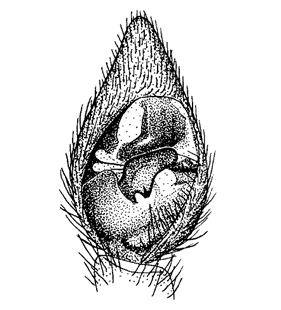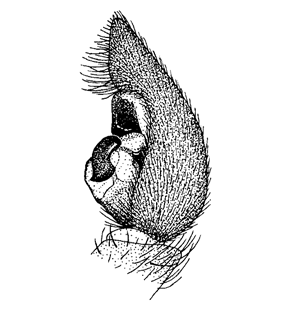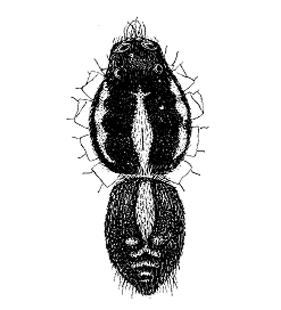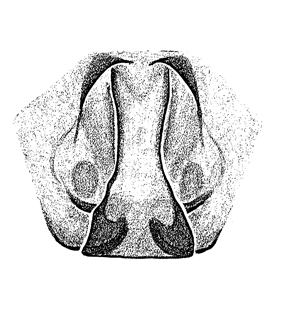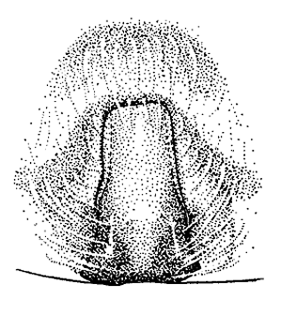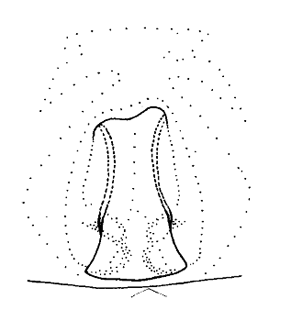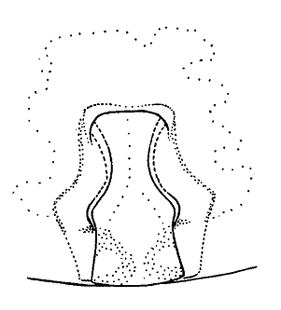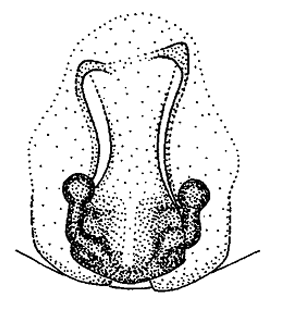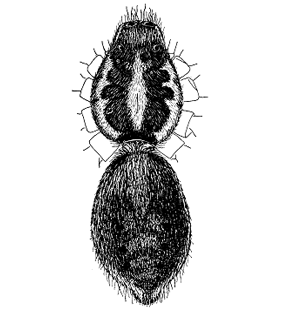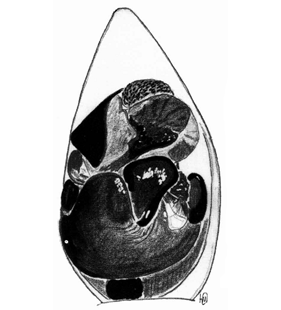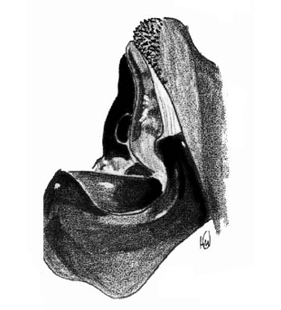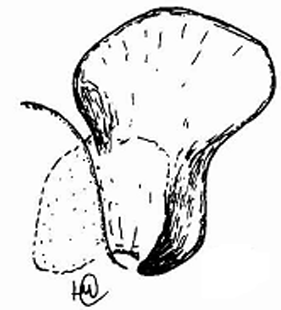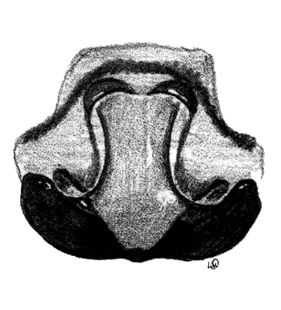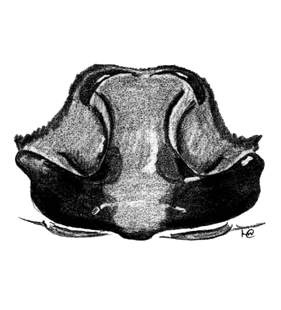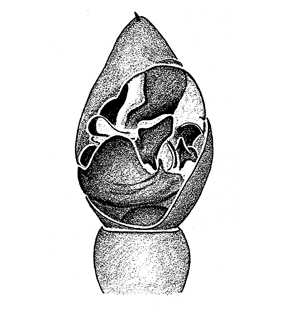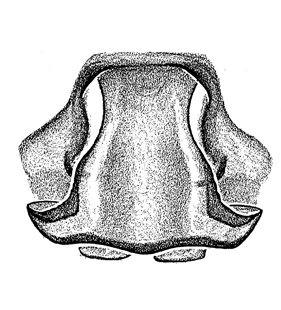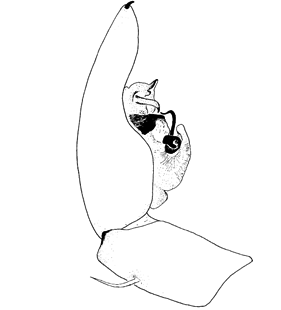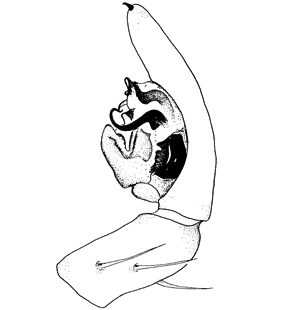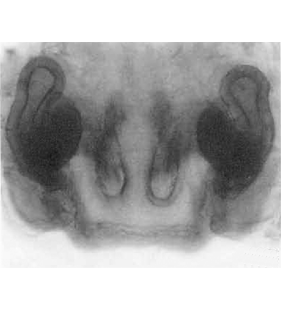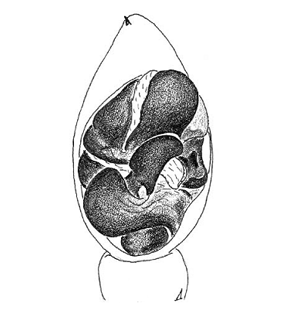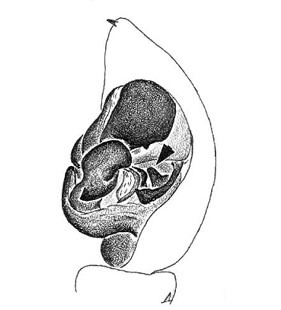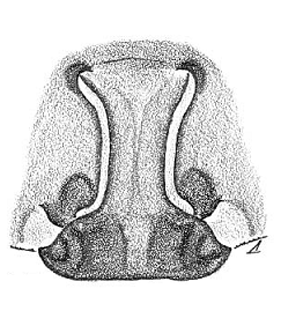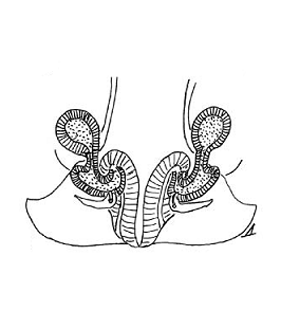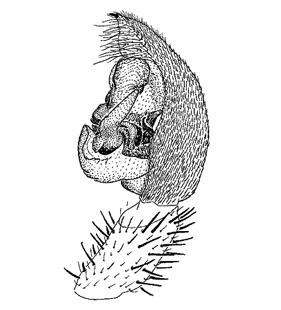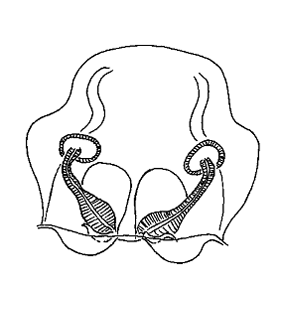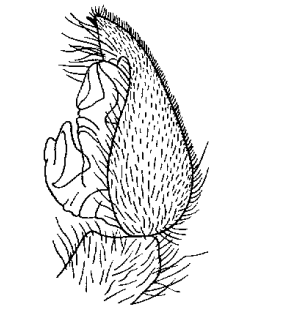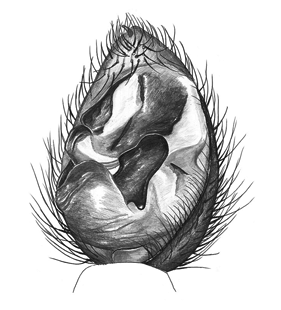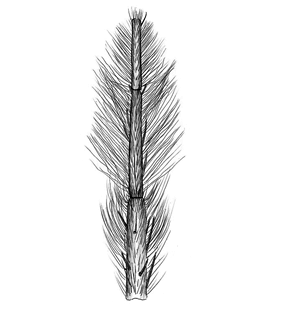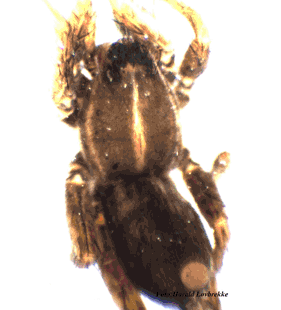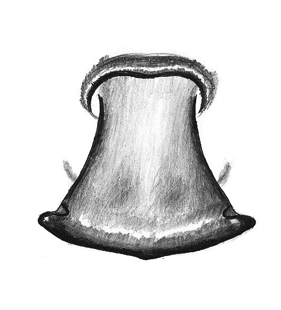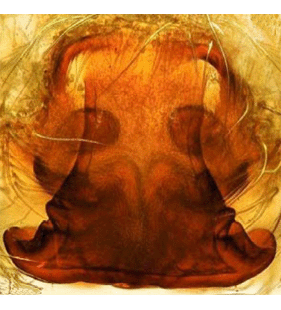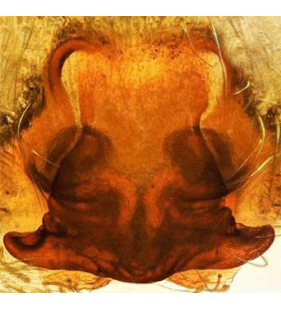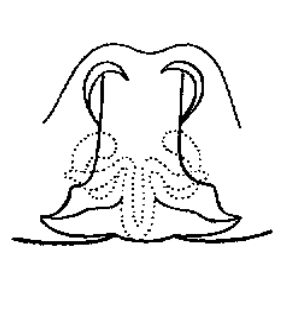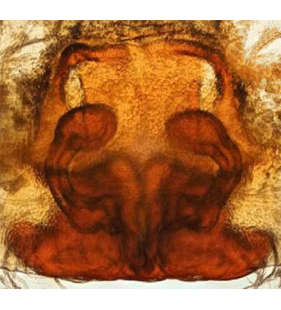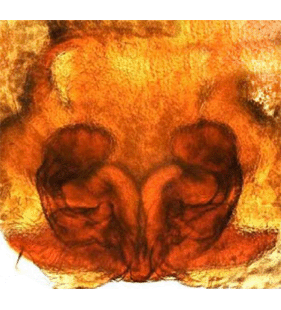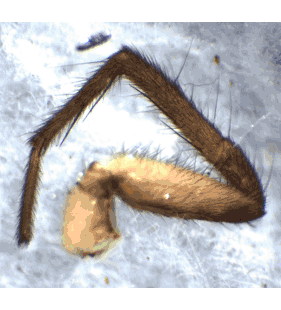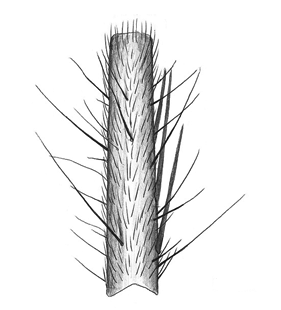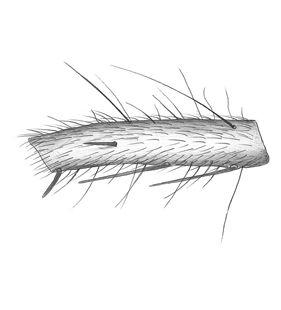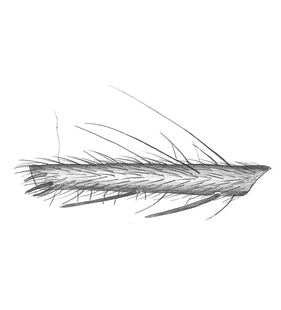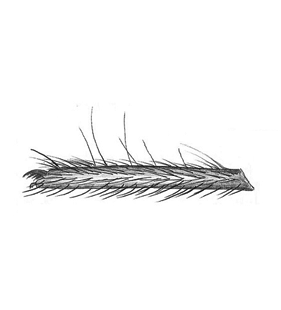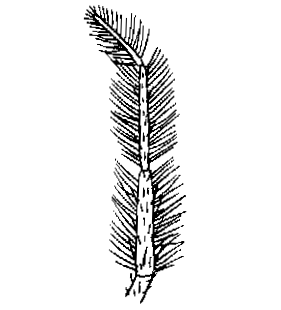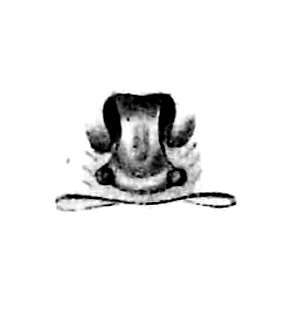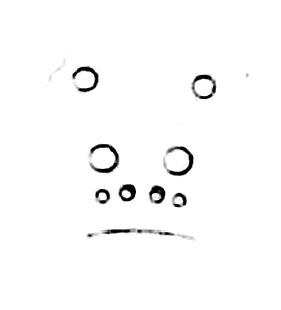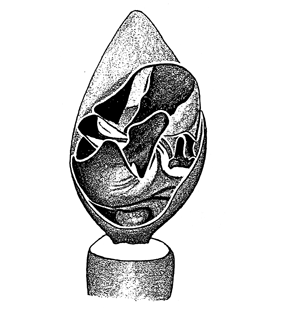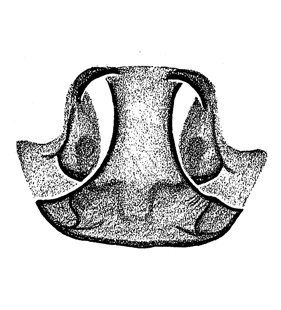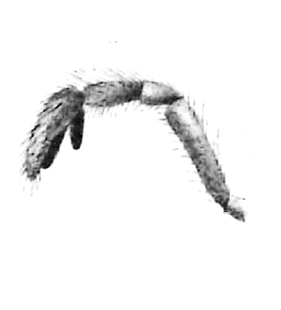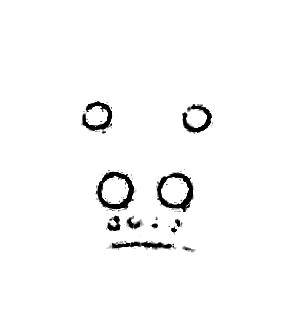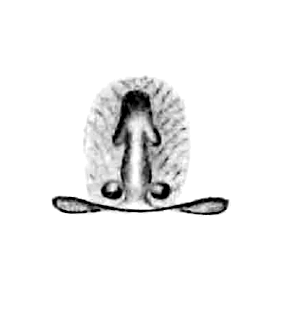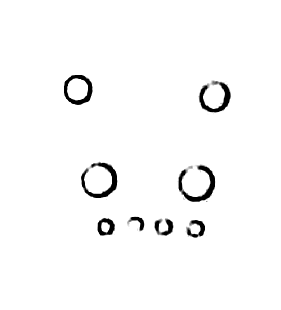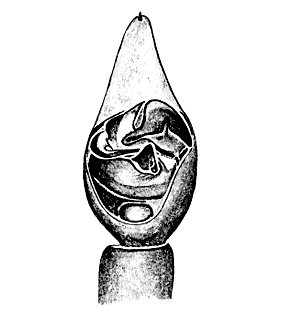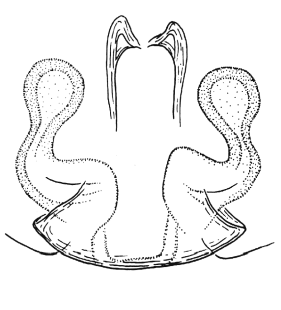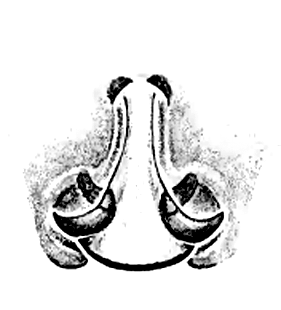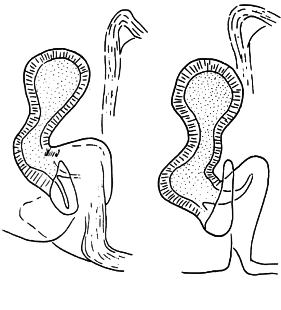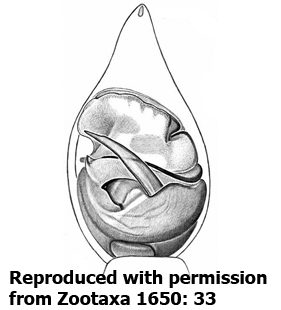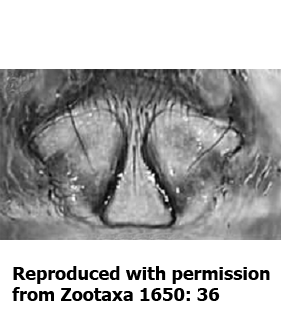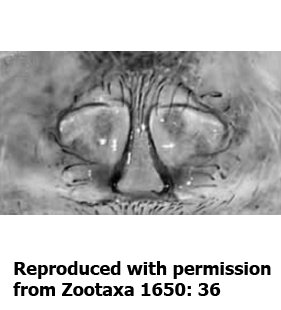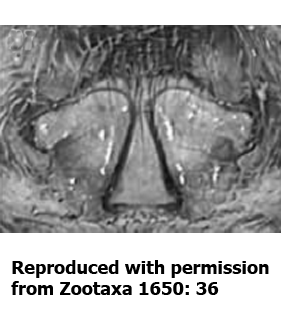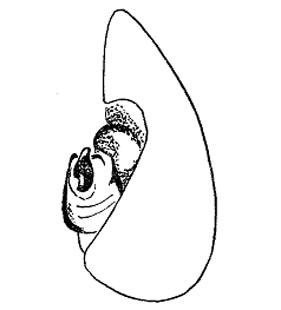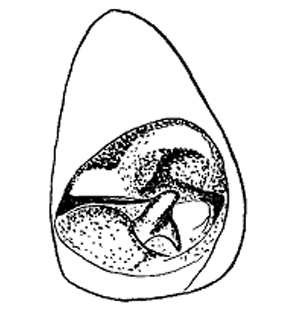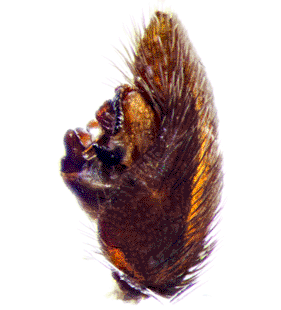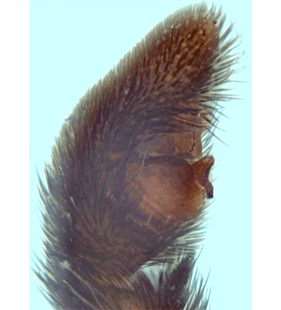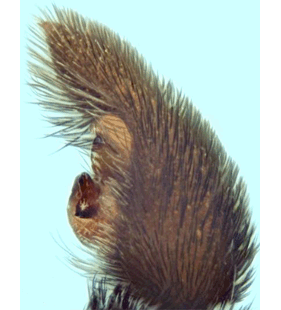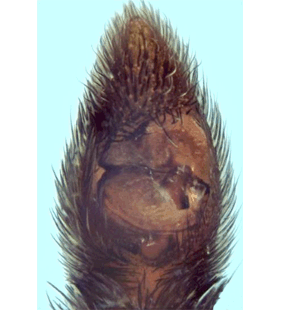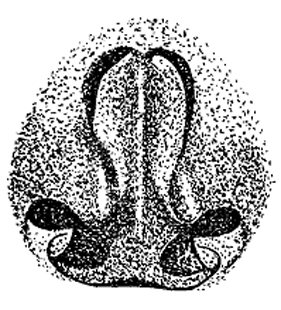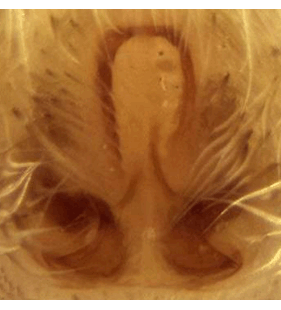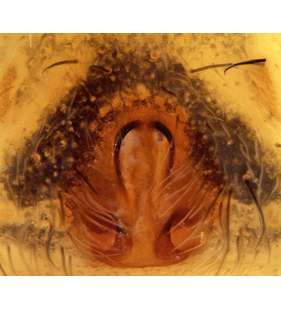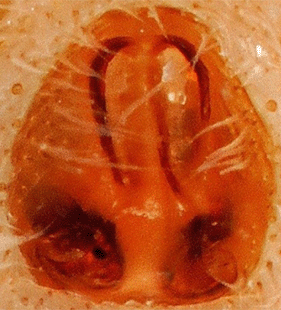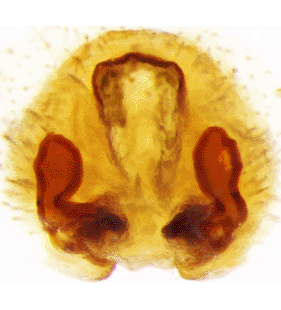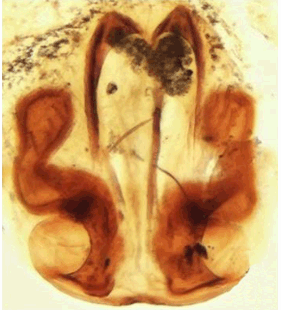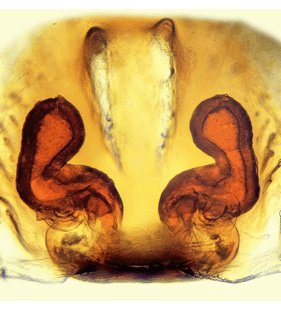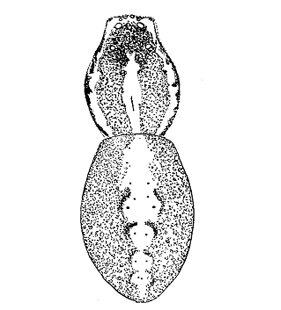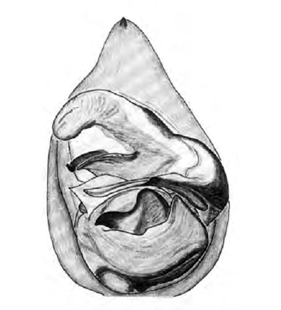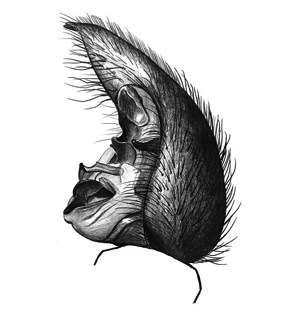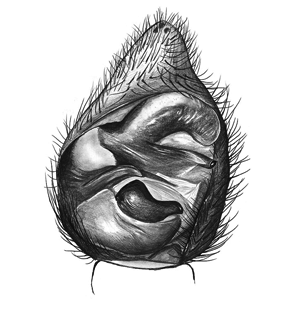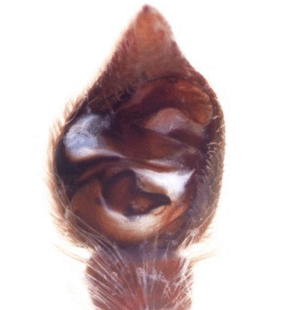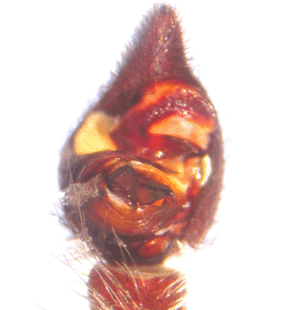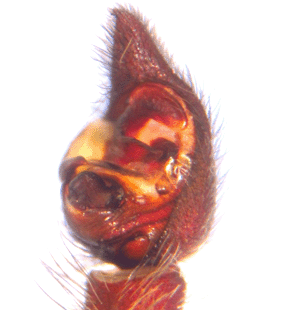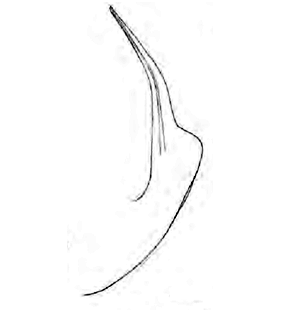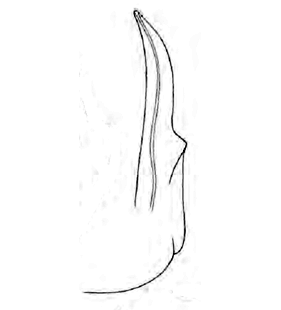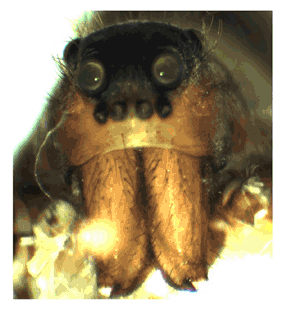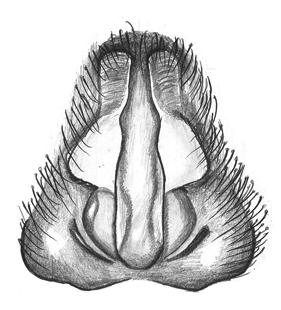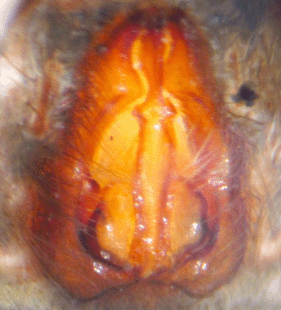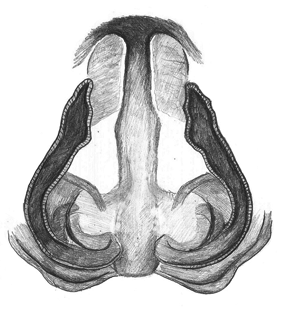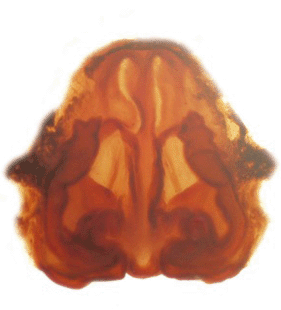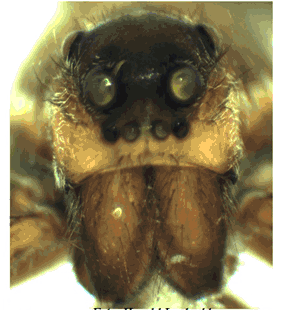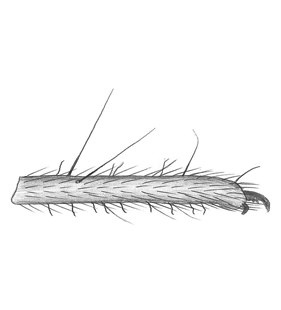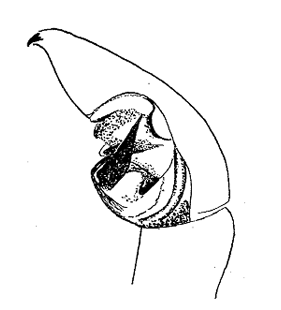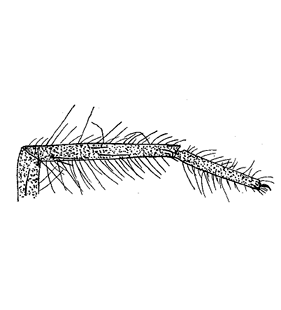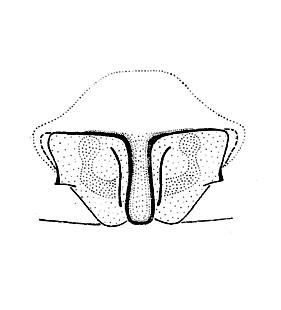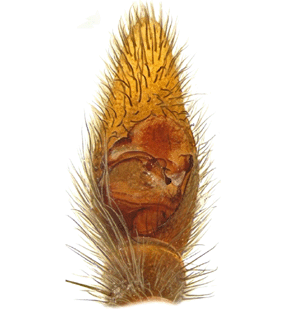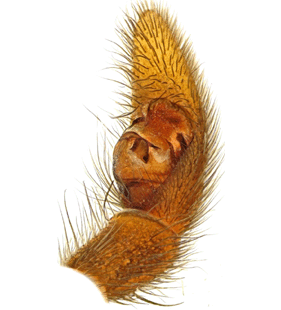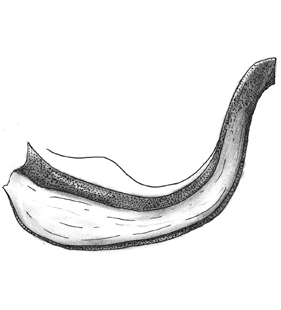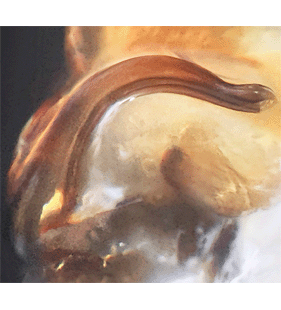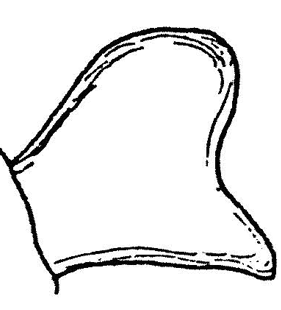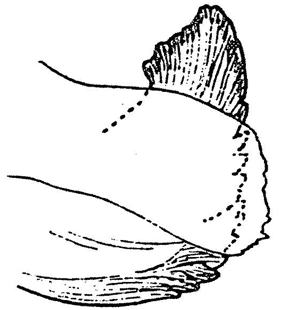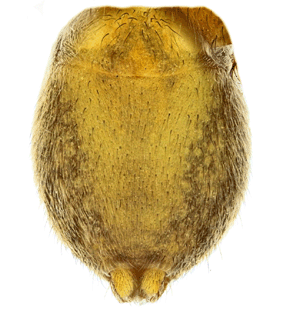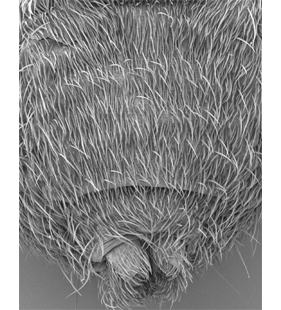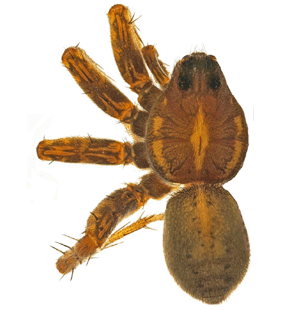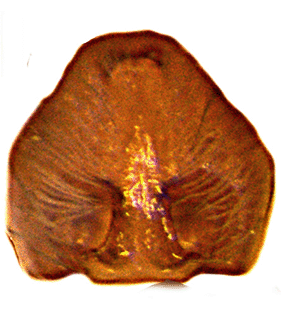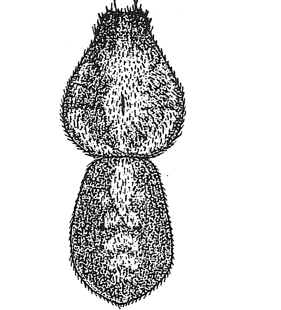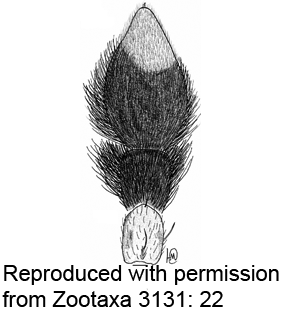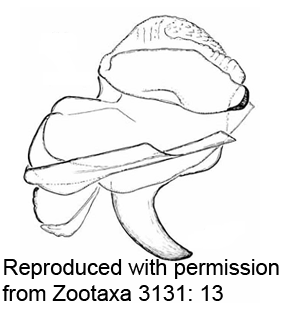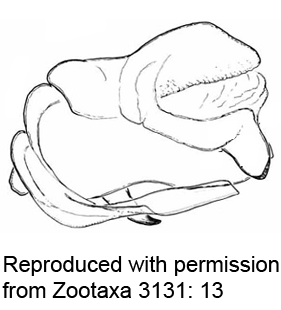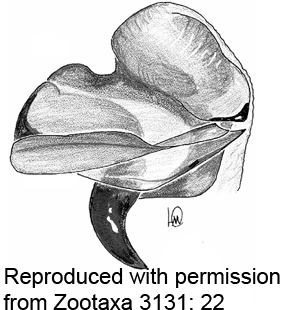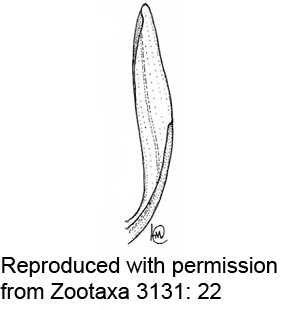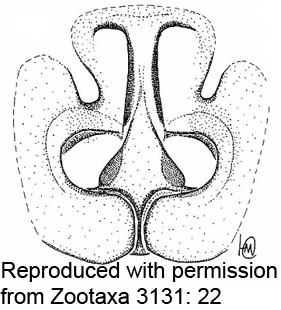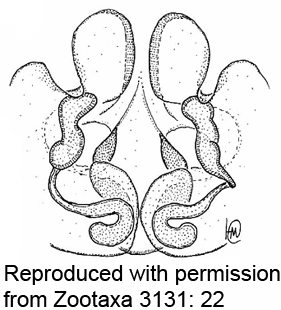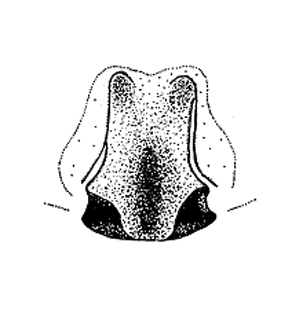Lycosidae: Pardosa C. L. Koch, 1847
Key not complete! Further species listed at the end of key |
In case you find an error or have a specific suggestion, please follow this link: click
|
||||||||||
| 1 |
Males | ||||||||||
| - | Females | ||||||||||
| 2 (1) |
Tegular apophysis as fig. |
| |||||||||
| - | Tegular apophysis different | ||||||||||
| 3 (2) |
Hairs on tarsus, metatarsus and tibia of leg I distinctly longer than on legs II-IV |
| |||||||||
| - | Hairs on tarsus, metatarsus and tibia of leg I not distinctly longer than on legs II-IV | ||||||||||
| 4 (3) |
Hairs on leg I appressed; terminal apophysis robust, beak-shaped; pedipalp ventrally as fig. Pardosa mixta (Kulczyński, 1887) |
||||||||||
| - | Hairs on leg I projecting; terminal apophysis different; pedipalp ventrally as fig. Pardosa purbeckensis F. O. Pickard-Cambridge, 1895 |
||||||||||
| 5 (3) |
Terminal apophysis large, robust, pointed Pardosa palustris (Linnaeus, 1758) |
||||||||||
| - | Different | ||||||||||
| 6 (5) |
Terminal apophysis with 2 small teeth | ||||||||||
| - | Terminal apophysis with one tooth at most | ||||||||||
| 7 (6) |
Tegular apophysis long and tapering into a tip; median longitudinal band on prosoma pointed anteriorly Pardosa agricola (Thorell, 1856) |
||||||||||
| - | Tegular apophysis long and bluntly tapering; terminal apophysis with 2 small teeth; pedipalp ventrally as fig; bright median band on prosoma broadened anteriorly Pardosa agricola (Thorell, 1856) |
||||||||||
| 8 (6) |
Median band of prosoma anteriorly broadened, lateral bands broken | ||||||||||
| - | Median band of prosoma anteriorly broadened or pointed, lateral bands not broken | ||||||||||
| 9 (8) |
Terminal apophysis pointed and with a robust tooth; pedipalp as fig. Pardosa torrentum Simon, 1876 |
| |||||||||
| - | Terminal apophysis without long tooth, distal tip bent toward the pedipalp plane; pedipalp as fig. Pardosa agrestis (Westring, 1861) |
||||||||||
| 10 (8) |
Median band on prosoma broadened anteriorly; terminal apophysis without tooth; pedipalp as fig. Pardosa agrestis (Westring, 1861) |
||||||||||
| - | Median band of prosoma anteriorly pointed | ||||||||||
| 11 (10) |
Terminal apophysis without tooth, the distal tip bent toward pedipalp plane; pedipalp ventrally as fig. Pardosa agrestis (Westring, 1861) |
||||||||||
| - | Terminal apophysis tooth-shaped | ||||||||||
| 12 (11) |
Pedipalp without white hairs; terminal apophysis small and narrow; tegular apophysis as fig. Pardosa monticola (Clerck, 1757) |
||||||||||
| - | Pedipalp at least partly with white hairs | ||||||||||
| 13 (12) |
Pedipalp from femur to middle of tarsus with white hairs; pedipalp as fig. Pardosa albatula (Roewer, 1951) |
| |||||||||
| - | Femur and patella of pedipalp with white hairs; pedipalp as fig. Pardosa blanda (C. L. Koch, 1833) |
| |||||||||
| 14 (2) |
Tibia I ventrally with 4 pairs of spines, distally with one pair of small spines; pedipalp as fig. Pardosa nigra (C. L. Koch, 1834) |
| |||||||||
| - | Tibia I ventrally with 2 pairs of spines, distally with one pair of spines (sometimes appearing as 3 pairs) | ||||||||||
| 15 (14) |
Tegular part of bulbus strongly protruding, a narrow and pointed process of shield bent toward outer margin | ||||||||||
| - | Different | ||||||||||
| 16 (15) |
Embolus long and pointed; pedipalp in lateral view as fig. Pardosa giebeli (Pavesi, 1873) |
| |||||||||
| - | Embolus flat, bent, its end with broad lamella | ||||||||||
| 17 (16) |
Basal part of shield process broad; pedipalp in lateral view as fig. Pardosa eiseni (Thorell, 1875) |
| |||||||||
| - | Basal part of shield process narrow; legs bright; femur darkly spotted Pardosa trailli (O. Pickard-Cambridge, 1873) |
||||||||||
| 18 (15) |
Some or all spinnerets black | ||||||||||
| - | Spinnerets yellow or brown, sometimes very dark coloured, but never black | ||||||||||
| 19 (18) |
All spinnerets black | ||||||||||
| - | Anterior spinnerets black, remaining spinnerets ± dark | ||||||||||
| 20 (19) |
Opisthosoma ventrally with bristle-like or spine-like thickened brown hairs between white hairs | ||||||||||
| - | Opisthosoma with thin, brown and white hairs | ||||||||||
| 21 (20) |
Cymbium mostly with 2 claws; ventral hairs on opisthosoma bristle-like; pedipalp as fig. Pardosa hyperborea (Thorell, 1872) |
||||||||||
| - | Cymbium with one claw; ventral hairs on opisthosoma short, spine-like; pedipalp as fig. Pardosa saltuaria (L. Koch, 1870) |
| |||||||||
| 22 (20) |
Cymbium mostly with 2 claws; pedipalp as fig.; Alps, south Europe Pardosa oreophila Simon, 1937 |
||||||||||
| - | Cymbium almost always with one claw; Krkonose Mountains Pardosa evelinae Wunderlich, 1984 |
| |||||||||
| 23 (19) |
Tegular apophysis is a robust, C-shaped lamella; terminal apophysis is a large tooth; lateral bands on prosoma narrow; opisthosoma with reddish pattern Pardosa cincta (Kulczyński, 1887) |
| |||||||||
| - | Tegular apophysis and terminal apophysis different; lateral bands on prosoma broad; opisthosoma with distinct yellow pattern | ||||||||||
| 24 (23) |
Tegular apophysis appearing as round lamella in ventral view, with robust tooth in the middle Pardosa schenkeli Lessert, 1904 |
| |||||||||
| - | Tegular apophysis with hook-shaped, lamellous protrusion on outer side (in ventral view) Pardosa bifasciata (C. L. Koch, 1834) |
||||||||||
| 25 (18) |
Metatarsi of leg II ventrally with long hairs, longer than on remaining legs; pedipalp as fig.; prosoma long and slender Pardosa vittata (Keyserling, 1863) |
| |||||||||
| - | Different | ||||||||||
| 26 (25) |
Tegular apophysis long, reaching ± to cymbial margin, upper branch of apophysis forwardly directed | ||||||||||
| - | Tegular apophysis short, various in shape; if upper branch present, then the branch not reaching to cymbial margin | ||||||||||
| 27 (26) |
Terminal apophysis long and narrow, finger-shaped | ||||||||||
| - | Terminal apophysis lacking (at least not visible) or a thin lamella | ||||||||||
| 28 (27) |
Terminal apophysis long and narrow, finger-shaped Pardosa nigriceps (Thorell, 1856) |
||||||||||
| - | Terminal apophysis shorter and broader Pardosa maisa Hippa & Mannila, 1982 |
| |||||||||
| 29 (27) |
Tegular apophysis robust, distally blunt, not reaching to cymbial margin; shield with robust, laterally directed process Pardosa ferruginea (L. Koch, 1870) |
| |||||||||
| - | Tegular apophysis blunt or pointed, in ventral view always reaching to cymbial margin | ||||||||||
| 30 (29) |
Median longitudinal band on prosoma broad, with white hairs; lateral longitudinal bands not distinctly developed lugubris - group The lugubris-group consists of the following 6 species. Males difficult to distinguish by morphological characters. Females not clearly identifiable by morphological characters, therefore females have to be identified via males caught in the same place. Nevertheless, the species are reproductively isolated due to different courtship behaviour |
||||||||||
| - | Median longitudinal band on prosoma more distinct in posterior part than in anterior part of prosoma, spindle-shaped or ± forked | ||||||||||
| 31 (30) |
Femora of all legs yellow with vague dark annulations; prosoma dark with dense, whitish yellow hairs; median longitudinal band on prosoma distinct, laterally with small, white haired spots; prosoma length < 2.4 mm; male pedipalp as fig. Pardosa baehrorum Kronestedt, 1999 |
||||||||||
| - | All femora dark brown, distal segments pale yellow; prosoma dark brown with black hairs; median prosomal longitudinal band with white hairs, small lateral spots; prosoma length > 2,4 mm | ||||||||||
| 32 (31) |
Prosoma length > 3 mm; tegular apophysis comparatively broad and robust; cymbial tip broad in lateral view Pardosa caucasica Ovtsharenko, 1979 |
| |||||||||
| - | Prosoma length < 3 mm; tegular apophysis thinner; cymbial tip narrow in lateral view | ||||||||||
| 33 (32) |
Prosoma length 2.8-3.0 mm; anterior part of tegular apophysis distinctly bent, forming a sickle-shaped structure together with lateral part Pardosa pertinax von Helversen, 2000 |
| |||||||||
| - | Prosoma length < 2.8 mm; anterior part of tegular apophysis only weakly bent or straight | ||||||||||
| 34 (33) |
Cymbium proximally with large red-brown spots (in alcohol pale yellow); cymbial tip narrow in lateral view, dorsally slightly concave; anterior part of tegular apophysis almost straight Pardosa alacris (C. L. Koch, 1833) |
||||||||||
| - | Cymbium proximally uniformly dark, distally straight or convex in lateral view; anterior part of tegular apophysis slightly bent | ||||||||||
| 35 (34) |
Cymbium strongly convex dorsally in lateral view; cymbial tip short with robust claw; pedipalp tibia and cymbium with scarce dark bristles; proximal part of cymbium dark, distally brownish Pardosa lugubris (Walckenaer, 1802) |
||||||||||
| - | Cymbium almost straight in lateral view; cymbial tip long with inconspicuous claw, covered by bristles; pedipalp tibia and cymbium densely provided with dark bristles; cymbium uniformly dark Pardosa saltans Töpfer-Hofmann, 2000 |
| |||||||||
| 36 (30) |
Median longitudinal band on prosoma weakly forked posteriorly; lateral longitudinal bands interrupted or missing; tibia and tarsus of pedipalp densely covered with black hairs; pedipalp as fig. Pardosa amentata (Clerck, 1757) |
||||||||||
| - | Median longitudinal band on prosoma ± spindle-shaped; lateral longitudinal bands continuous or divided into 2-3 parts; segments of pedipalp reddish | ||||||||||
| 37 (36) |
Tegular apophysis very long, blunt distally, distinctly reaching beyond cymbial margin Pardosa riparia (C. L. Koch, 1833) |
| |||||||||
| - | Tegular apophysis long, ± pointed, reaching to cymbial margin or reaching slightly beyond cymbial margin | ||||||||||
| 38 (37) |
Tegular apophysis pointed, hardly reaching to cymbial margin in ventral view, distinctly separated from cymbial margin in lateral view; metatarsus and tarsus I-II with scopula hairs Pardosa pullata (Clerck, 1757) |
||||||||||
| - | Tegular apophysis blunt distally, reaching to cymbial margin in lateral or ventral view; metatarsus and tarsus I-II without scopula hairs | ||||||||||
| 39 (38) |
Legs distinctly annulated; opisthosoma normally haired ventrally; prosoma red-brown, median longitudinal band only posteriorly broadened; lateral longitudinal band broadly separated from prosomal margin, often broken into 2-3 segments Pardosa prativaga (L. Koch, 1870) |
||||||||||
| - | Legs not annulated, at most femur dorsally with weak marking; opisthosoma ventrally covered with small sclerotised teeth; hairs on metatarsus and tarsus I-II shorter than 2 diameters; median longitudinal band broadened anteriorly; lateral longitudinal bands reaching to clypeus Pardosa sphagnicola (Dahl, 1908) |
| |||||||||
| 40 (26) |
Upper branch of tegular apophysis distinctly developed, ±hook-shaped, lower branch of tegular apophysis inwardly directed | ||||||||||
| - | Tegular apophysis compact or lamellous, upper branch lacking or not hook-shaped | ||||||||||
| 41 (40) |
Tegular apophysis distinctly C-shaped, upper branch blunt; lateral longitudinal bands on prosoma interrupted | ||||||||||
| - | Upper branch of tegular apophysis pointed distally; lateral longitudinal band on prosoma continuous, interrupted or lacking | ||||||||||
| 42 (41) |
Body length 5-6 mm; pedipalp tarsus 1.0 mm, with grey hairs; pedipalp as fig.; prosoma with dense grey hairs, lateral bands narrow, broken into 3-5 spots; legs yellow, weakly annulated; opisthosoma mostly without pattern or with white hairs in spots, indistinct yellow cardiac mark or spots; genital morphologically not distinguishable from saturatior Pardosa wagleri (Hahn, 1822) |
| |||||||||
| - | Body length 7-8 mm; pedipalp tarsus 1.5 mm, very dark, black haired; pedipalp as fig.; prosoma scarcely grey haired, lateral bands broken into 3-4 spots; legs reddish yellow, distinctly annulated; opisthosoma with very indistinct pattern Pardosa saturatior Simon, 1937 |
| |||||||||
| 43 (41) |
Upper branch of tegular apophysis short; shield with distally bent lamella in lateral view; femur I black, dorsally with yellow stripes; femur II dorsally yellow-brown and black; femur III and IV dorsally annulated; tibia I almost black Pardosa sordidata (Thorell, 1875) |
| |||||||||
| - | Upper branch of tegular apophysis long; shield not with bent lamella; femur dorsally black spotted or annulated Pardosa paludicola (Clerck, 1757) |
||||||||||
| 44 (40) |
Tegular apophysis forming a lamella; body length 8.2 mm; legs yellow, femur dorsally spotted Pardosa nebulosa (Thorell, 1872) |
||||||||||
| - | Different | ||||||||||
| 45 (44) |
Shield with lamella-like process | ||||||||||
| - | Shield without lamella-like process | ||||||||||
| - | Lamellous process of shield short | ||||||||||
| 46 (45) |
Tooth of tegular apophysis at 5 o'clock position; legs grey-brown, distinctly annulated Pardosa hortensis (Thorell, 1872) |
||||||||||
| - | Tooth of tegular apophysis at 4 o'clock position; legs red-brown with dark annulations Pardosa morosa (L. Koch, 1870) |
||||||||||
| 47 (45) |
Lateral longitudinal bands on prosoma indistinct, not broken; tegular apophysis wider than long; legs yellow; femur I black, II-IV dorsally spotted Pardosa cribrata Simon, 1876 |
||||||||||
| - | Lateral longitudinal bands on prosoma broken; tegular apophysis longer than wide Pardosa proxima (C. L. Koch, 1847) |
||||||||||
| 48 (1) |
Septum of epigyne is a trapezoid, reddish plate, covering genital groove | ||||||||||
| - | Different | ||||||||||
| 49 (48) |
Anterior spinnerets dark brown or black | ||||||||||
| - | Anterior spinnerets yellow | ||||||||||
| 50 (49) |
Projecting dorsal hairs on basal half of tarsus I-II inconspicuous, length 1.5-2.2 times the diameter of tarsus (often abraded) Pardosa hyperborea (Thorell, 1872) |
| |||||||||
| - | Projecting hairs on tarsus I-II 3-4 times the diameter of tarsus | ||||||||||
| 51 (50) |
"Wings" of epigynal plate without transverse depression, laterally not lobed and mostly strongly converging, therefore anterior margin strongly descending toward anterior end Pardosa oreophila Simon, 1937 |
| |||||||||
| - | Different | ||||||||||
| 52 (51) |
Anterior margin of "wings" ± straight, descending toward posterior end, without depression Pardosa evelinae Wunderlich, 1984 |
| |||||||||
| - | Anterior margin of "wings" concave; epigynal wings divergent, transverse depression, lateral margin lobed Pardosa saltuaria (L. Koch, 1870) |
| |||||||||
| 53 (49) |
Median longitudinal band on prosoma conically tapering, anteriorly pointed or ending star-shaped | ||||||||||
| - | Median longitudinal band on prosoma broadened posterior to eyes and around area of dorsal groove | ||||||||||
| 54 (53) |
Septum longer than wide | ||||||||||
| - | Septum wider than long | ||||||||||
| 55 (54) |
Bright lateral longitudinal stripes on prosoma not broken; margins of septum ± parallel or somewhat broadened posteriorly; corners of anterior epigynal pockets as fig. Pardosa monticola (Clerck, 1757) |
||||||||||
| - | Bright lateral longitudinal stripes on prosoma 2 times broken | ||||||||||
| 56 (55) |
Lateral longitudinal band 2-3 times broken; median longitudinal band narrow, white haired; corners of anterior epigynal pockets as fig. Pardosa blanda (C. L. Koch, 1833) |
| |||||||||
| - | Lateral longitudinal band and epigyne as figs.; median longitudinal band on prosoma anteriorly pointed Pardosa agricola (Thorell, 1856) |
||||||||||
| 57 (54) |
Septum distinctly much wider than long; corners of anterior epigynal pockets uniformly rounded as fig. |
||||||||||
| - | Septum strongly broadened posteriorly with ± uniformly indented sides, corners of anterior epigynal pockets not uniformly rounded | ||||||||||
| 58 (57) |
Posterior lateral process of septum obtuse angled, often wrinkled and protruding; length of longitudinal groove on septum 2/3 of length of septum; legs yellowish, ± annulated; femur darkly spotted dorsally Pardosa palustris (Linnaeus, 1758) |
||||||||||
| - | Posterior lateral process of septum laterally or forwardly bent, never wrinkled; legs, mainly femur dark Pardosa blanda (C. L. Koch, 1833) |
| |||||||||
| - | Very similar, in the mountains, south Europe, east Europe; only determinable via males caught in the same place Pardosa albatula (Roewer, 1951) |
| |||||||||
| 59 (57) |
Septum parallel-sided, posterior angle ± obtuse, often wrinkled; lateral longitudinal bands always continuous; on prosomal margin a thin bright longitudinal band, as wide as median band, separated from prosomal margin by a dark band; legs yellow-brown, indistinctly annulated Pardosa mixta (Kulczyński, 1887) |
| |||||||||
| - | Sides of septum indented, posterior angle protruding beak-like; epigyne variable; prosoma dark brown; longitudinal bands variable; legs bright, ± distinctly annulated Pardosa agrestis (Westring, 1861) |
||||||||||
| 60 (53) |
Lateral longitudinal bands on prosoma not broken | ||||||||||
| - | Lateral longitudinal bands on prosoma broken | ||||||||||
| 61 (60) |
Epigyne variable as fig.; prosoma dark brown, longitudinal bands variable; legs bright, ± distinctly annulated Pardosa agrestis (Westring, 1861) |
||||||||||
| - | Epigyne as fig., hardly distinguishable from agrestis females; prosoma dark brown; legs yellow-brown; femur only dorsally with dark longish spots; metatarsus indistinctly spotted, III and IV ± annulated | ||||||||||
| 62 (60) |
Septum approx. as wide as long, the sides S-shaped; corners of anterior epigynal pockets as fig. Pardosa agricola (Thorell, 1856) |
||||||||||
| - | Septum ± wider than long | ||||||||||
| 63 (62) |
Legs yellow-brown, distinctly annulated; corners of anterior epigynal pockets as fig. Pardosa torrentum Simon, 1876 |
| |||||||||
| - | Legs weakly annulated; sides of septum uniformly broadened; corners of anterior epigynal pockets as fig. Pardosa agrestis (Westring, 1861) |
||||||||||
| 64 (48) |
Tibia I ventrally with 4 (rarely 3) pairs of spines, distally one pair of short spines; epigyne as fig. Pardosa nigra (C. L. Koch, 1834) |
| |||||||||
| - | Tibia I ventrally with 2 (rarely 3) pairs of spines | ||||||||||
| 65 (64) |
Lateral longitudinal bands on prosoma not broken, often as broad as the dark stripes, reaching to prosomal margin, a ± distinct dark stripe within the bright stripe; opisthosoma with conspicuous yellow pattern | ||||||||||
| - | Lateral longitudinal bands on prosoma broken or not, but always narrower than dark stripes, separated from prosomal margin by dark stripes | ||||||||||
| 66 (65) |
Spinnerets yellow; epigyne as fig. Pardosa vittata (Keyserling, 1863) |
| |||||||||
| - | Anterior spinnerets black, at least base darkened | ||||||||||
| 67 (66) |
One anterior epigynal pocket with rounded corners, under which the median septum is folded; entrance duct twisted once; prosoma long and slender, dark brown Pardosa bifasciata (C. L. Koch, 1834) |
| |||||||||
| - | Two anterior epigynal pockets, median septum long and wavy; entrance duct at least 2 times twisted Pardosa schenkeli Lessert, 1904 |
| |||||||||
| 68 (65) |
Prosoma elongated | ||||||||||
| - | Prosoma not conspicuously elongated | ||||||||||
| 69 (68) |
Anterior epigynal pockets symmetric; median longitudinal band on prosoma reddish, posterior one yellow, posteriorly bordered by a dark transverse line and two dots Pardosa nigriceps (Thorell, 1856) |
| |||||||||
| - | Anterior epigynal pockets asymmetric; prosoma yellowish, lateral stripes on prosoma lacking Pardosa maisa Hippa & Mannila, 1982 |
||||||||||
| 70 (68) |
Anterior epigynal pockets distinctly separated and situated at anterior outer margin of epigyne; median septum ± broadened posteriorly; genital groove ear-shaped or triangular | ||||||||||
| - | Anterior epigynal pockets close together, touching each other or with septum | ||||||||||
| 71 (70) |
Genital groove ear-shaped; septum completely white haired, broadened posteriorly Pardosa riparia (C. L. Koch, 1833) |
| |||||||||
| - | Genital groove ± triangular; septum white haired on anterior part at most, bulb-shaped, ± rounded posteriorly | ||||||||||
| 72 (71) |
A connecting line between the centres of the two epigynal pockets cuts septum at median; anterior margin of epigynal pockets medially indented; legs reddish, not annulated (femur dorsally at most) Pardosa pullata (Clerck, 1757) |
||||||||||
| - | A connecting line between the two centres of anterior epigynal pockets cuts septum at its anterior margin or not touching it; anterior margin of epigynal pockets medially not indented | ||||||||||
| 73 (72) |
Femur,, tibia and metatarsus distinctly annulated; epigyne width (outer margin of epigynal pockets) 0.52-0.7 mm; prosoma red-brown, median longitudinal band only posteriorly broadened, lateral longitudinal bands broadly separated from prosomal margin, often divided into 2-3 segments Pardosa prativaga (L. Koch, 1870) |
||||||||||
| - | Legs not annulated; epigyne width 0.38-0.55 mm; prosoma red-brown; median longitudinal band anteriorly broadened; lateral longitudinal bands reaching to clypeus Pardosa sphagnicola (Dahl, 1908) |
| |||||||||
| 74 (70) |
At least the anterior spinnerets dark brown; margins of anterior epigynal pockets connected | ||||||||||
| - | Spinnerets bright; margins of anterior epigynal pockets not connected | ||||||||||
| 75 (74) |
Epigynal margins running parallel, almost the whole epigynal length, then posteriorly diverging | ||||||||||
| - | Epigynal margins at most in the first 1/5 of epigyne parallel, then diverging | ||||||||||
| 76 (75) |
Septum reaching underneath the anterior epigynal pockets; red-brown; median longitudinal band lacking, lateral longitudinal bands indistinct, broken into spots Pardosa sordidata (Thorell, 1875) |
| |||||||||
| - | Septum not reaching underneath the anterior epigynal pockets | ||||||||||
| 77 (76) |
Anterior part of epigynal groove 3-4 times longer than posterior part; prosoma dark brown; longitudinal bands on prosoma reddish, medially broad, laterally narrower Pardosa paludicola (Clerck, 1757) |
||||||||||
| - | Anterior part of epigynal groove at most twice as long as posterior part | ||||||||||
| 78 (77) |
Anterior part of epigynal groove hardly longer than posterior part; prosoma dark brown, median longitudinal band reddish yellow, anteriorly indistinct, lateral longitudinal bands indistinct and broken Pardosa giebeli (Pavesi, 1873) |
| |||||||||
| - | Anterior part of epigynal groove approx. twice as long as posterior part | ||||||||||
| 79 (78) |
Lateral and median longitudinal bands indistinct or lacking; prosoma dark brown; legs dark brown, slightly annulated; femur darkly spotted; opisthosomal pattern indistinct; epigyne as fig. Pardosa trailli (O. Pickard-Cambridge, 1873) |
||||||||||
| - | Median longitudinal band on prosoma yellow, broadened anteriorly; lateral longitudinal bands not broken; prosoma red-brown; legs yellowish, annulated (at least dorsally): opisthosoma with reddish pattern Pardosa eiseni (Thorell, 1875) |
| |||||||||
| 80 (75) |
Lateral longitudinal bands on prosoma distinct and not broken; margins of epigynal groove divergent; legs reddish; femur slightly spotted Pardosa cincta (Kulczyński, 1887) |
| |||||||||
| - | Lateral longitudinal bands on prosoma indistinct; median band oval, reddish; margins of epigynal groove at least at anterior part parallel, posteriorly divergent Pardosa ferruginea (L. Koch, 1870) |
| |||||||||
| 81 (74) |
Median longitudinal band on prosoma distinct, ± parallel-sided or spindle-shaped, never broadened anteriorly lugubris-group |
||||||||||
| - | Median longitudinal band on prosoma not always distinct, broadened posterior to eyes and around area of dorsal groove | ||||||||||
| - | Median longitudinal band on prosoma spindle-shaped or with star-shaped broadening at posterior end | ||||||||||
| 82 (81) |
The lugubris-group consists of the following 6 species. Females not clearly identifiable by morphological characters, therefore females have to be identified via males caught in the same place | ||||||||||
| - | Median longitudinal band on prosoma ± parallel-sided, white haired, lateral longitudinal bands narrow; epigyne anchor-shaped Pardosa lugubris (Walckenaer, 1802) |
||||||||||
| - | Prosoma dark brown, densely covered with black hairs, white hairs on median stripe, no lateral markings; sternum light brown with dark hairs; opisthosoma brown with dark spots on margin of median stripe, laterally grey-brown with yellow hairs; spinnerets brown; femora black proximally, light yellow distally like remaining segments Pardosa alacris (C. L. Koch, 1833) |
| |||||||||
| - | Prosoma dark brown with distinct white haired median stripe, no lateral markings; sternum yellow-brown with short dark hairs; opisthosoma brown with light brown median stripe, bordered by dark spots, laterally with grey spots, white haired, ventrally yellow-brown with dark spots; spinnerets brown; coxa to femur black; patella to tarsus yellow Pardosa saltans Töpfer-Hofmann, 2000 |
| |||||||||
| - | Prosoma brown with light brown median band; lateral bands less distinct, laterally with dark and bright hairs on prosomal margin; chelicerae and sternum yellowish to brownish; opisthosoma brown with median stripe, grained with grey, laterally and ventrally with grey-brown spots; legs yellowish with weak annulations Pardosa baehrorum Kronestedt, 1999 |
| |||||||||
| - | Prosoma dark brown with small dark bristles, median stripe distinct, white haired; chelicerae dark brown; sternum light brown with spots; opisthosoma light brown, median stripe dark brow, ventrally dark, like spinnerets; coxa to femur dark brown with long dark hairs; distal part of femora to tarsi pale yellow Pardosa caucasica Ovtsharenko, 1979 |
||||||||||
| - | Prosoma dark brown with small black bristles, median stripe distinct, white-haired; chelicerae dark brown; sternum dark brown with black hairs; opisthosoma dark brown with white hairs, without median stripe, ventrally dark, spinnerets also; legs: coxa to femur dark brown with long dark hairs; distal part of femora to tarsi pale yellow Pardosa pertinax von Helversen, 2000 |
||||||||||
| 83 (81) |
Lateral longitudinal bands on prosoma broken; margins of epigynal groove parallel in anterior part; legs reddish yellow with dark annulations; opisthosoma brown with reddish pattern, mostly indistinct Pardosa proxima (C. L. Koch, 1847) |
||||||||||
| - | Lateral longitudinal bands not broken, indistinct, with dark spots and black hairs; margins of epigynal groove not parallel in anterior part; legs reddish yellow, distinctly spotted and annulated; body brown to green-brown; opisthosomal pattern yellow, distinct Pardosa cribrata Simon, 1876 |
| |||||||||
| 84 (81) |
Lateral longitudinal bands on prosoma not broken, distinctly jagged laterally; median band forked anteriorly; legs yellow, distinctly annulated; epigyne as fig. Pardosa nebulosa (Thorell, 1872) |
||||||||||
| - | Lateral longitudinal bands on prosoma broken | ||||||||||
| 85 (84) |
Anterior part of septum semilunar; septum narrowed medially, posterior part becoming broader toward posterior end; prosoma brown, light median band reddish, yellowish posteriorly; legs yellow-red, annulated Pardosa amentata (Clerck, 1757) |
||||||||||
| - | Septum ± triangular | ||||||||||
| 86 (85) |
Anterior epigynal pockets separated by septum; Margins of septum merge with margins of epigynal pockets | ||||||||||
| - | Anterior epigynal pockets close together; margins of septum do not merge with margins of epigynal pockets | ||||||||||
| 87 (86) |
Body length 6.0-7.5 mm; epigyne as fig.; length of epigynal septum 0.5 mm; prosoma dark brown, densely covered with grey hairs, lateral bands narrow, broken into 3-5 spots; legs yellow, weakly annulated; genital morphologically not distinguishable from saturatior Pardosa wagleri (Hahn, 1822) |
||||||||||
| - | Body length 7.8-9.5 mm; epigyne as fig.; length of epigynal septum 0.75 mm; prosoma chocolate brown, scarcely covered with grey hairs, lateral bands broken into 3-4 spots; legs reddish yellow, distinctly annulated Pardosa saturatior Simon, 1937 |
| |||||||||
| 88 (86) |
Septum not completely covering genital groove, its shape is variable; prosoma grey-brown; long bright median band, lateral bands reddish yellow, broken into spots, mostly indistinct; legs grey-brown, distinctly annulated Pardosa hortensis (Thorell, 1872) |
||||||||||
| - | Septum triangular, almost completely covering genital groove | ||||||||||
| - | Median and lateral longitudinal bands on prosoma reddish, indistinct; median band partly broken into spots, forked posteriorly, lateral bands broken into 3 or more spots; epigyne as fig.; legs red-brown with dark annulation Pardosa morosa (L. Koch, 1870) |
Further taxa
1. Pardosa abagensis Ovtsharenko, 1979 | ||||||||
2. Pardosa aenigmatica Tongiorgi, 1966 |
| |||||||
3. Pardosa agricola borussica (Dahl, 1908) |
| |||||||
4. Pardosa agricola fucicola (Dahl, 1908) |
| |||||||
5. Pardosa alasaniensis Mcheidze, 1997 |
| |||||||
6. Pardosa angusta Denis, 1956 |
| |||||||
7. Pardosa aquila Buchar & Thaler, 1998 |
| |||||||
8. Pardosa armeniaca Marusik, 2023 | ||||||||
9. Pardosa atomaria (C. L. Koch, 1847) | ||||||||
10. Pardosa atomaria saturiator Caporiacco, 1948 |
| |||||||
11. Pardosa atrata (Thorell, 1873) | ||||||||
12. Pardosa azerifalcata Marusik, Guseinov & Koponen, 2003 | ||||||||
13. Pardosa buchari Ovtsharenko, 1979 | ||||||||
14. Pardosa cavannae Simon, 1881 |
| |||||||
15. Pardosa colchica Mcheidze, 1946 |
| |||||||
16. Pardosa condolens (O. Pickard-Cambridge, 1885) |
| |||||||
17. Pardosa confalonierii Caporiacco, 1928 |
| |||||||
18. Pardosa consimilis Nosek, 1905 | ||||||||
19. Pardosa cribrata catalonica Simon, 1937 |
| |||||||
20. Pardosa dagestana Buchar & Thaler, 1998 | ||||||||
21. Pardosa danica (Sørensen, 1904) |
| |||||||
22. Pardosa drenskii Buchar, 1968 |
| |||||||
23. Pardosa elegans (Thorell, 1875) |
| |||||||
24. Pardosa femoralis Simon, 1876 |
| |||||||
25. Pardosa fulvipes (Collett, 1876) | ||||||||
26. Pardosa furcifera (Thorell, 1875) | ||||||||
27. Pardosa gefsana Roewer, 1959 | ||||||||
28. Pardosa ghigii Caporiacco, 1932 |
| |||||||
29. Pardosa gracilenta (Lucas, 1846) |
| |||||||
30. Pardosa gusarensis Marusik, Guseinov & Koponen, 2003 |
| |||||||
31. Pardosa ibex Buchar & Thaler, 1998 |
| |||||||
32. Pardosa ilgunensis Nosek, 1905 |
| |||||||
33. Pardosa incerta Nosek, 1905 | ||||||||
34. Pardosa indecora L. Koch, 1879 | ||||||||
35. Pardosa iniqua (O. Pickard-Cambridge, 1876) |
| |||||||
36. Pardosa injucunda (O. Pickard-Cambridge, 1876) | ||||||||
37. Pardosa inopina (O. Pickard-Cambridge, 1876) | ||||||||
38. Pardosa inquieta (O. Pickard-Cambridge, 1876) |
| |||||||
39. Pardosa invenusta (C. L. Koch, 1837) |
| |||||||
40. Pardosa italica Tongiorgi, 1966 | ||||||||
41. Pardosa italica valenta Zyuzin, 1976 | ||||||||
42. Pardosa jaikensis Ponomarev, 2007 | ||||||||
43. Pardosa jeniseica Eskov & Marusik, 1995 |
| |||||||
44. Pardosa jergeniensis Ponomarev, 1979 | ||||||||
45. Pardosa lapponica (Thorell, 1872) | ||||||||
46. Pardosa lasciva L. Koch, 1879 | ||||||||
47. Pardosa luctinosa Simon, 1876 | ||||||||
48. Pardosa masurae Esyunin & Efimik, 1998 | ||||||||
49. Pardosa monticola ambigua Simon, 1937 |
| |||||||
50. Pardosa monticola minima Simon, 1876 |
| |||||||
51. Pardosa monticola pseudosaltuaria Simon, 1937 |
| |||||||
52. Pardosa mtugensis (Strand, 1908) |
| |||||||
53. Pardosa naevia (L. Koch, 1875) | ||||||||
54. Pardosa ninigoriensis Mcheidze, 1997 |
| |||||||
55. Pardosa obscuripes Simon, 1909 |
| |||||||
56. Pardosa observans (O. Pickard-Cambridge, 1876) | ||||||||
57. Pardosa occidentalis Simon, 1881 | ||||||||
58. Pardosa oksalai Marusik, Hippa & Koponen, 1996 | ||||||||
59. Pardosa olympica Tongiorgi, 1966 |
| |||||||
60. Pardosa paleata Alderweireldt & Jocqué, 1992 | ||||||||
61. Pardosa paracolchica Zyuzin & Logunov, 2000 |
| |||||||
62. Pardosa pirkuliensis Zyuzin & Logunov, 2000 |
| |||||||
63. Pardosa plumipes (Thorell, 1875) | ||||||||
64. Pardosa poecila (Herman, 1879) |
| |||||||
65. Pardosa pontica (Thorell, 1875) |
| |||||||
66. Pardosa prativaga scoparia Simon, 1937 |
| |||||||
67. Pardosa profuga (Herman, 1879) |
| |||||||
68. Pardosa proxima poetica Simon, 1876 |
| |||||||
69. Pardosa pseudostrigillata Tongiorgi, 1966 | ||||||||
70. Pardosa pullata jugorum Simon, 1937 |
| |||||||
71. Pardosa pyrenaica Kronestedt, 2007 | ||||||||
72. Pardosa roscai (Roewer, 1951) | ||||||||
73. Pardosa septentrionalis (Westring, 1861) | ||||||||
74. Pardosa serena (L. Koch, 1875) |
| |||||||
75. Pardosa subalpina Schenkel, 1918 |
| |||||||
76. Pardosa tasevi Buchar, 1968 |
| |||||||
77. Pardosa tenuipes L. Koch, 1882 | ||||||||
78. Pardosa tesquorum (Odenwall, 1901) | ||||||||
79. Pardosa thorelli (Collett, 1876) |
| |||||||
80. Pardosa torrentum integra Denis, 1950 |
| |||||||
81. Pardosa uiensis Esyunin, 1996 |
|
